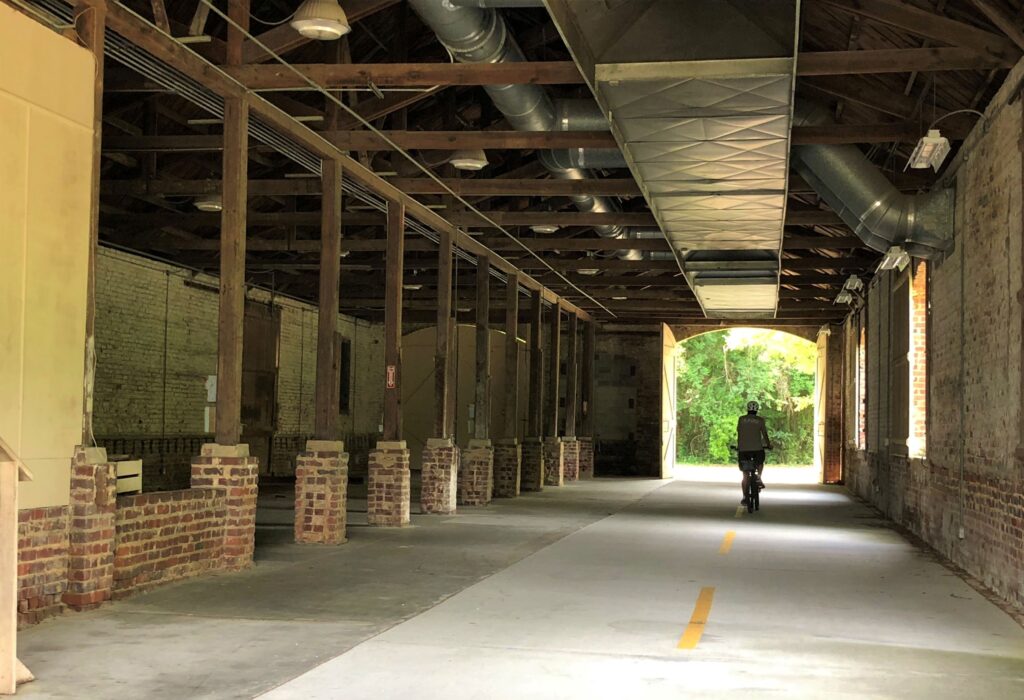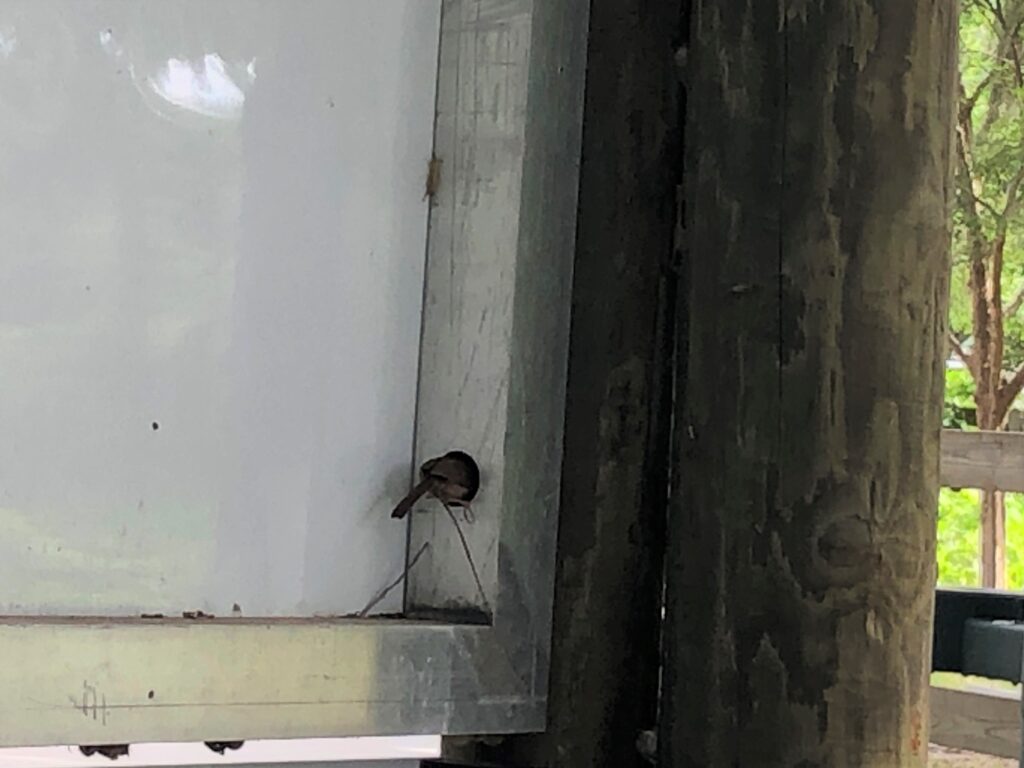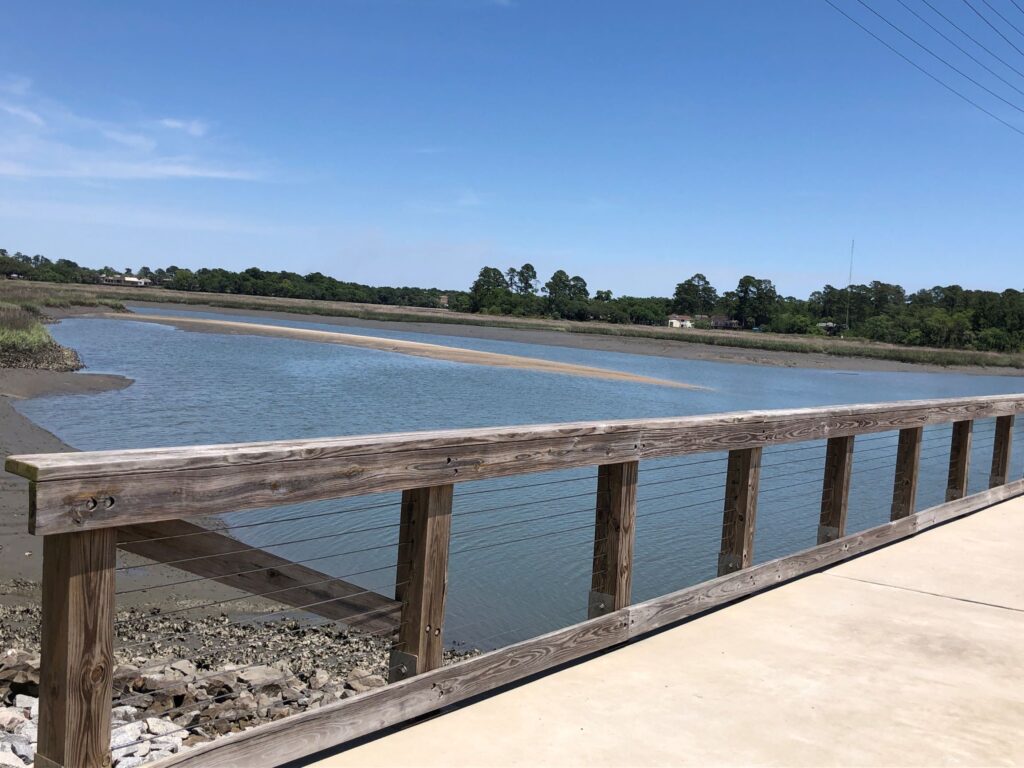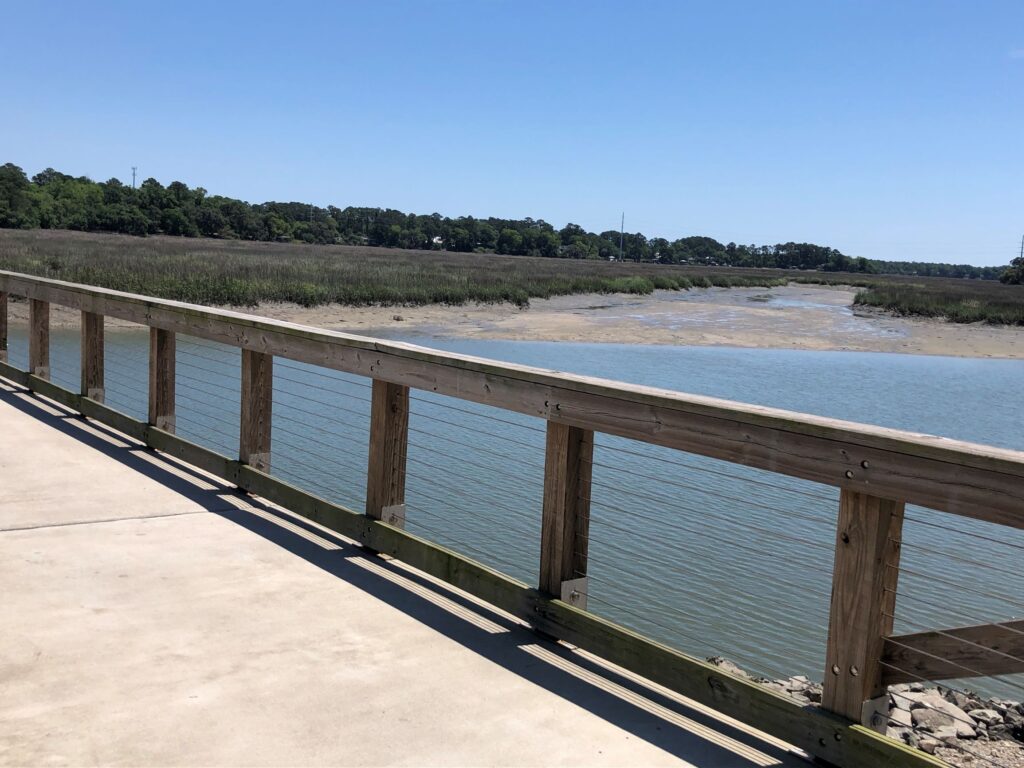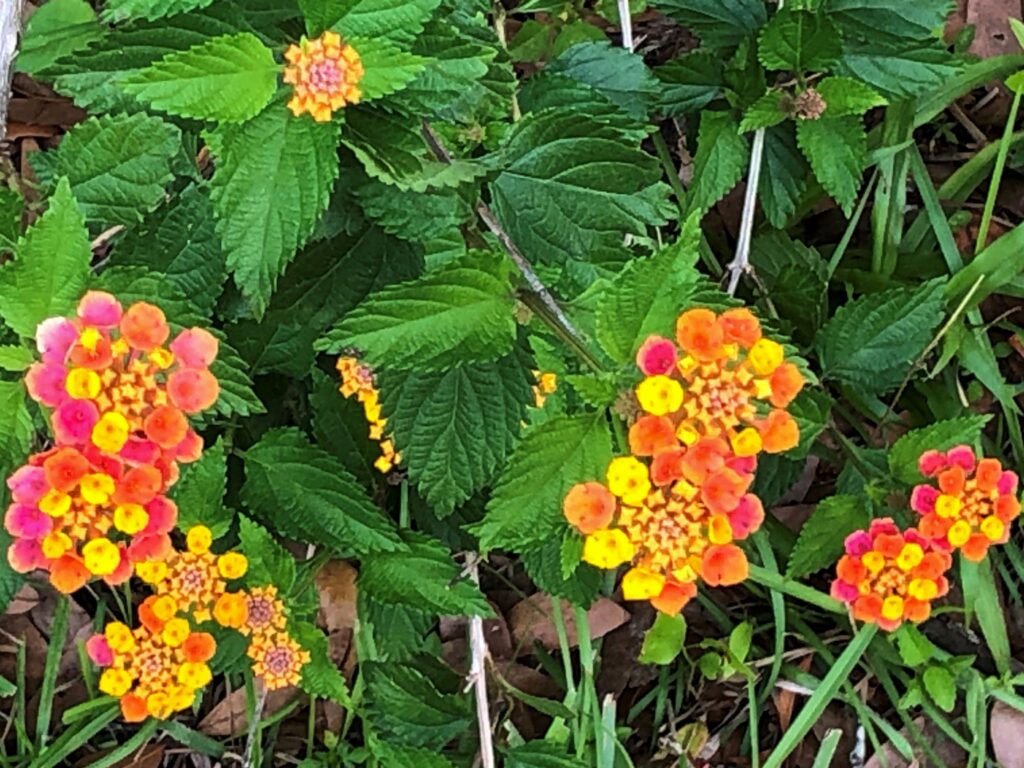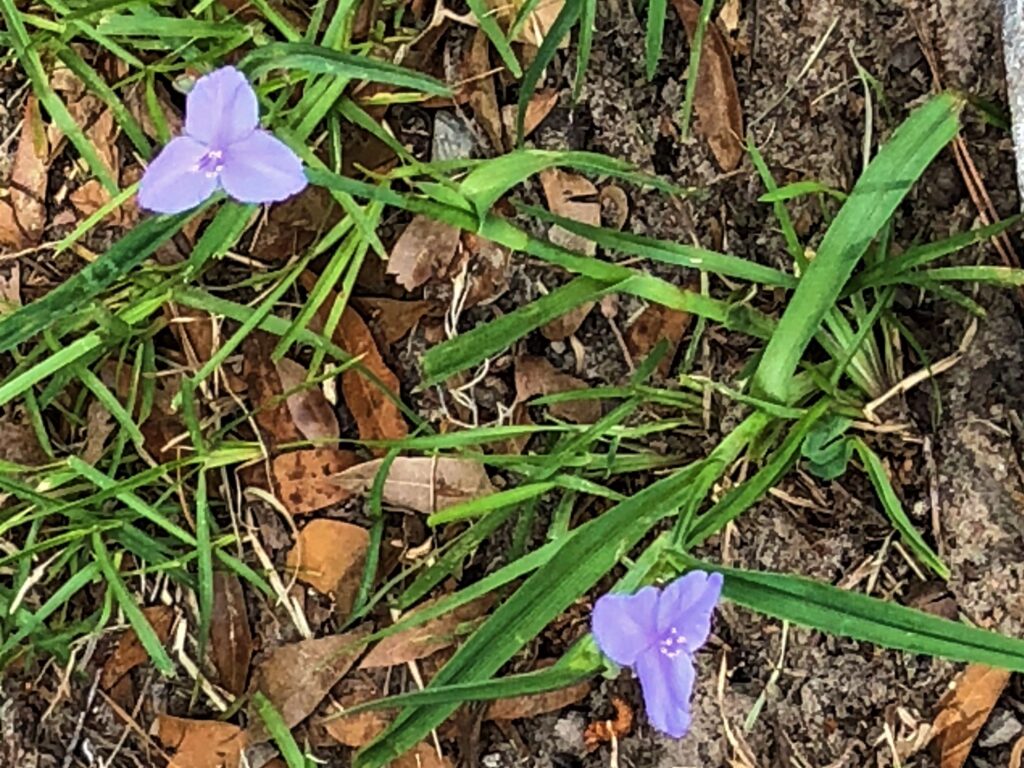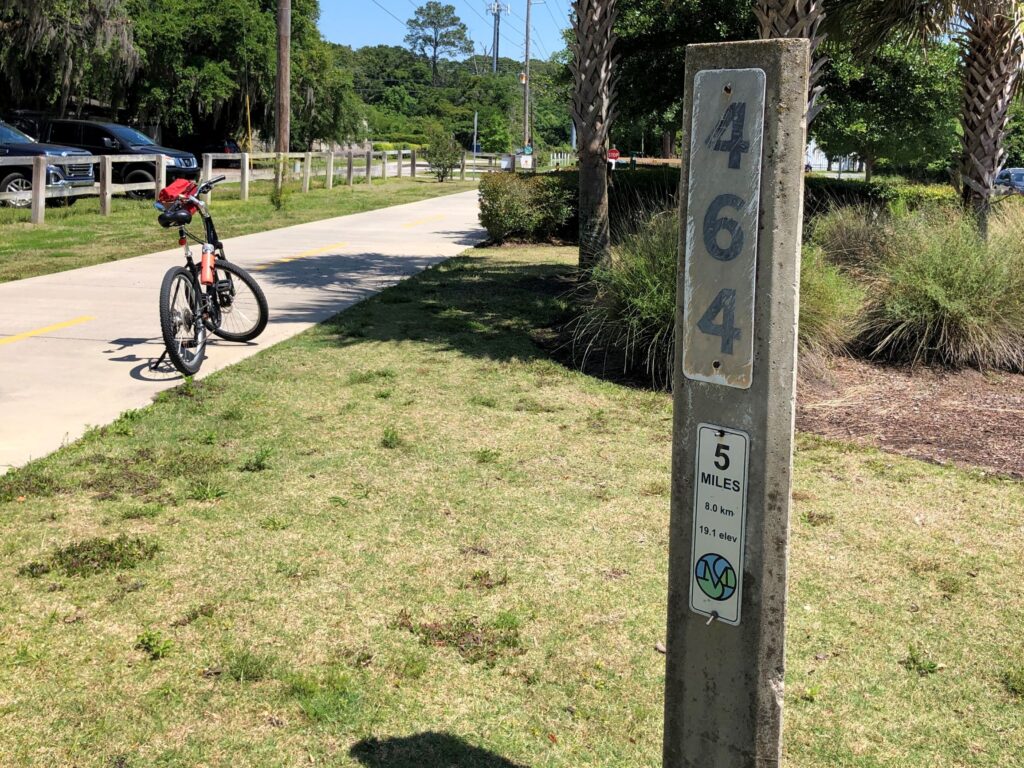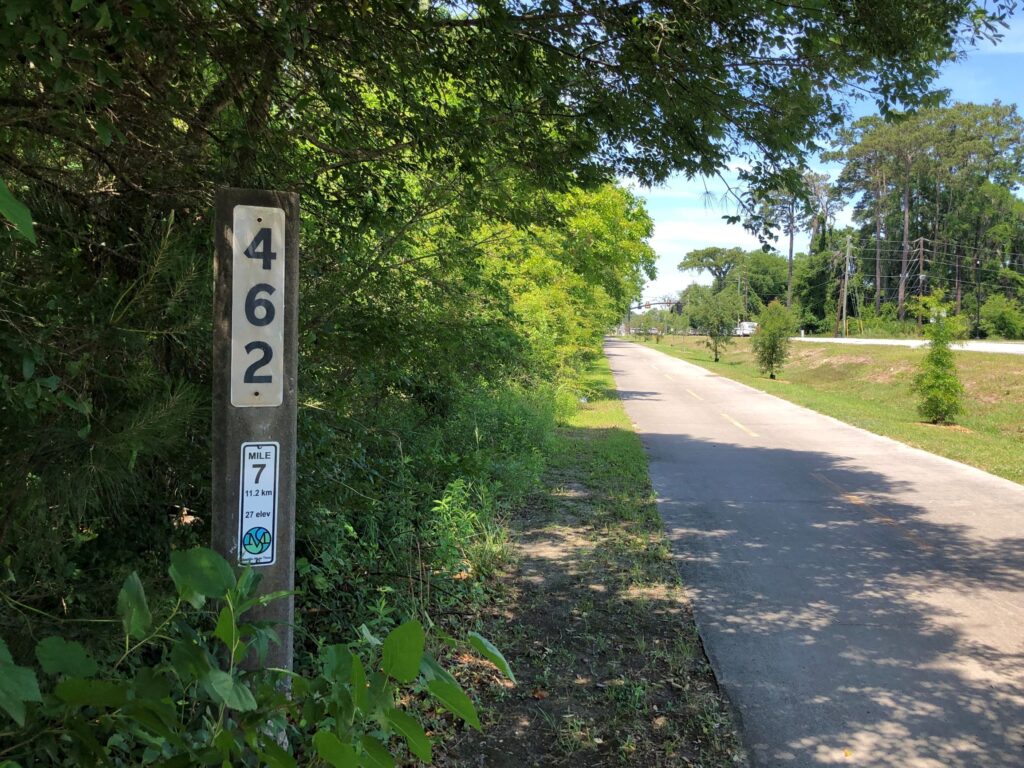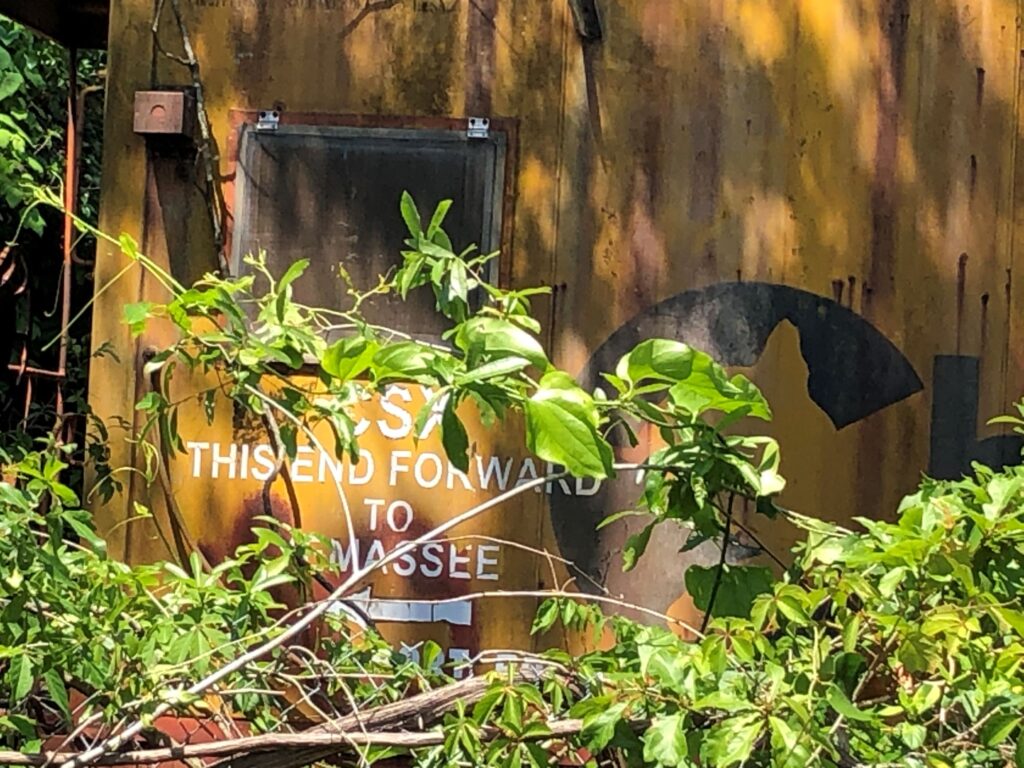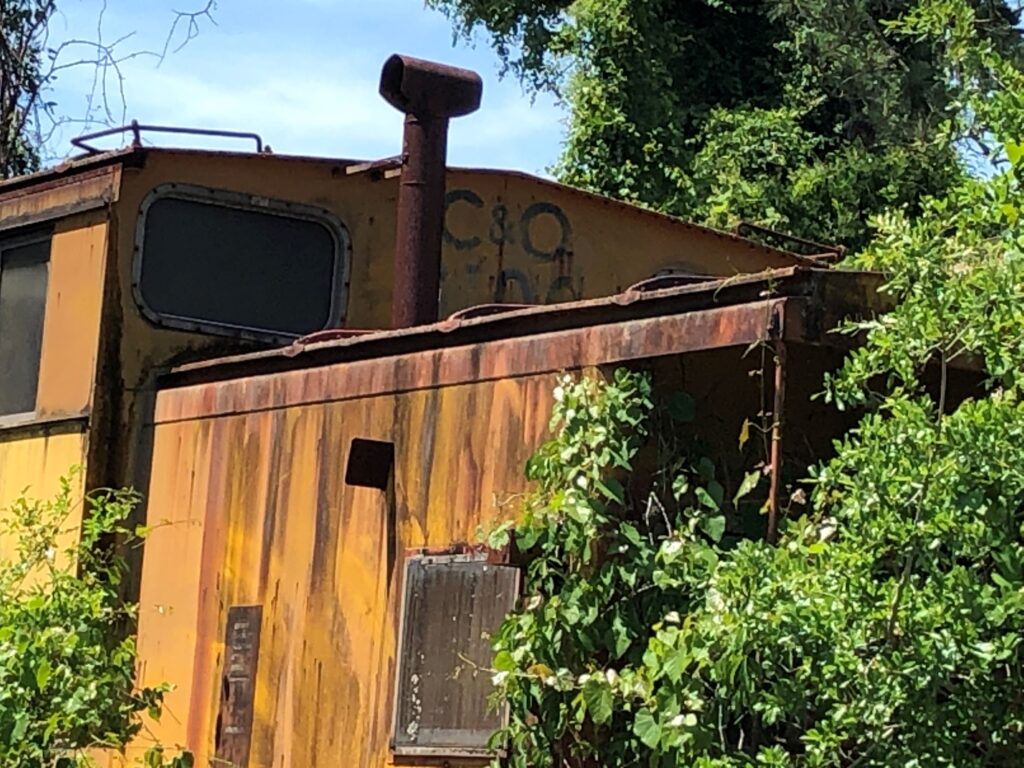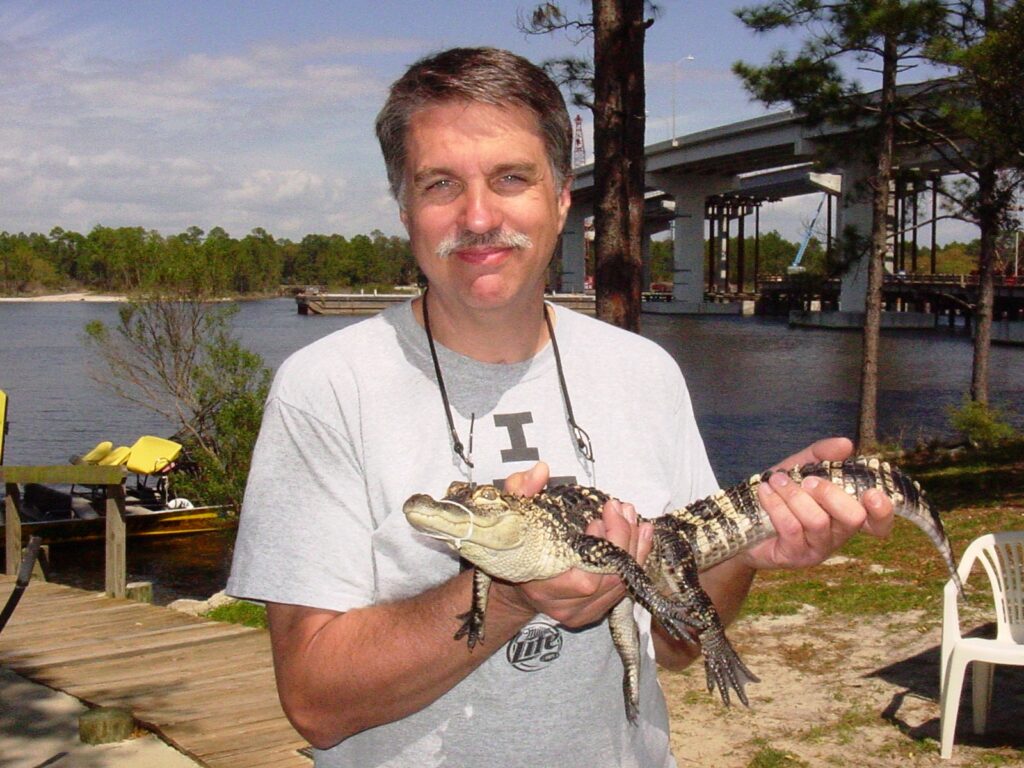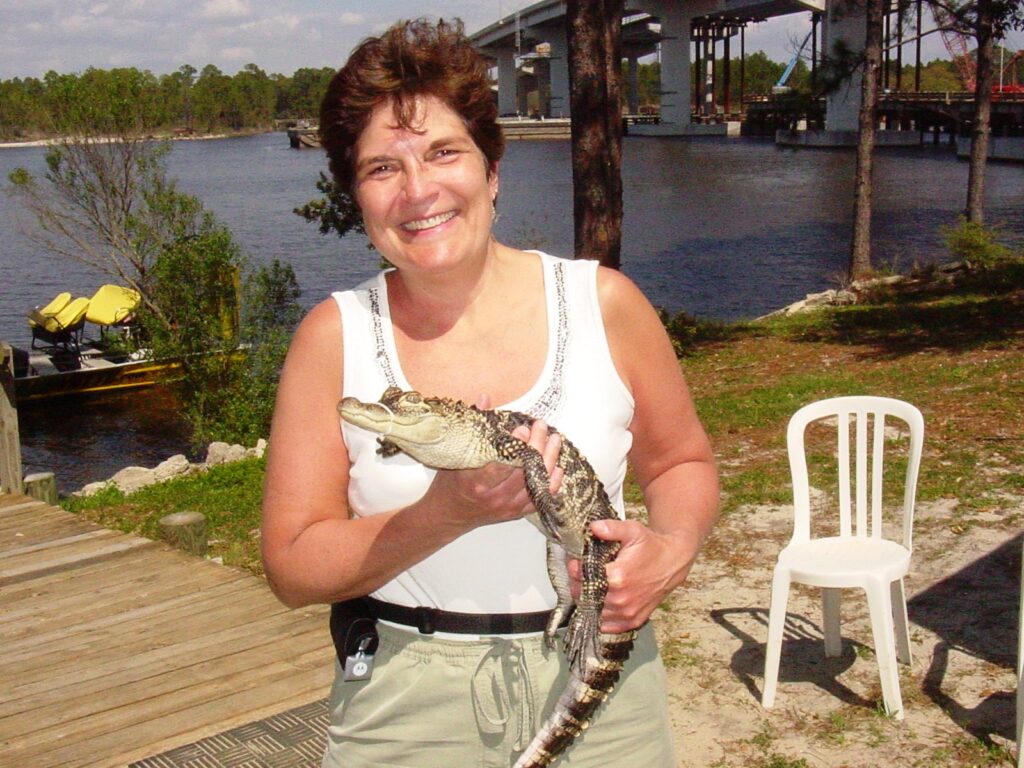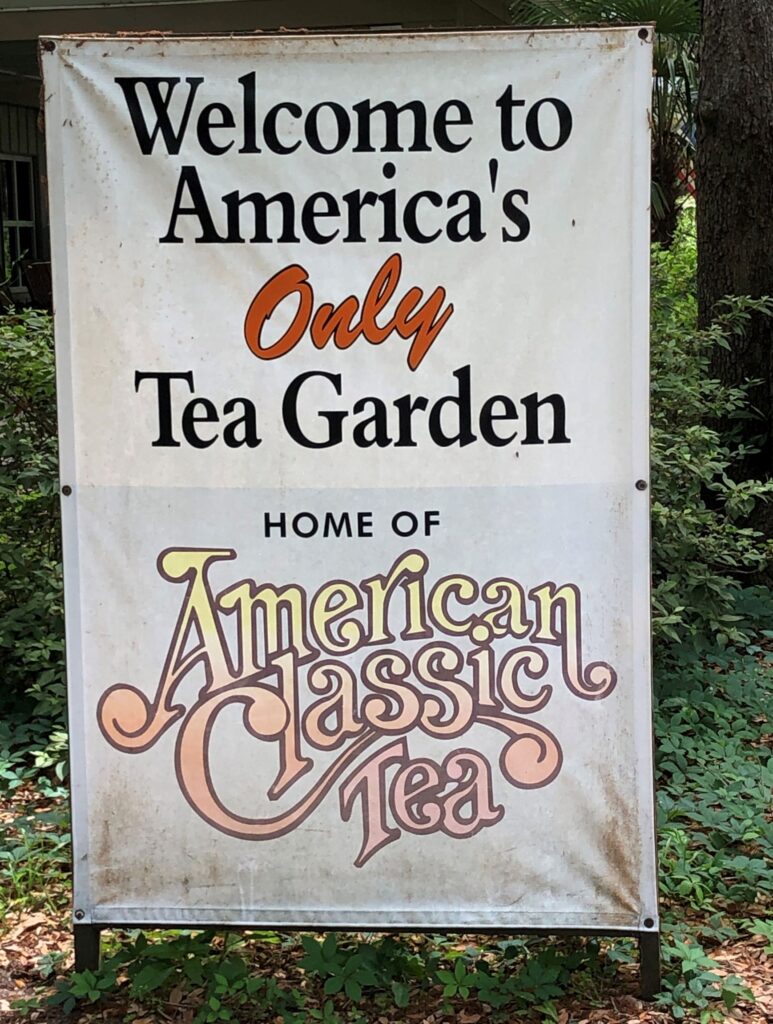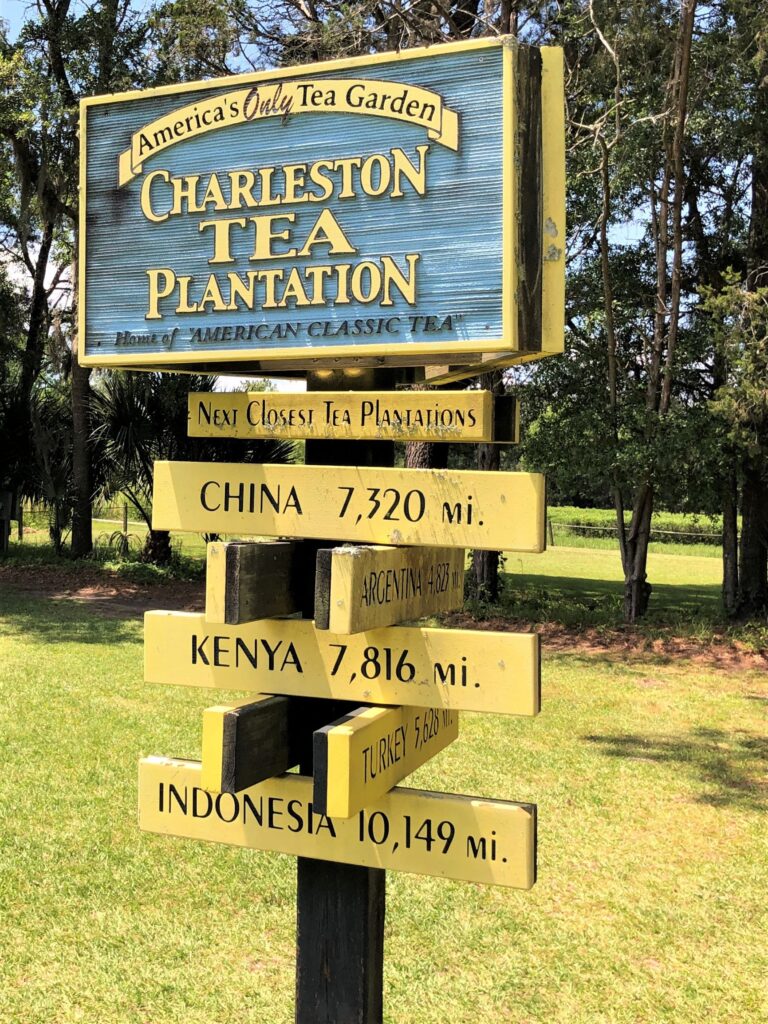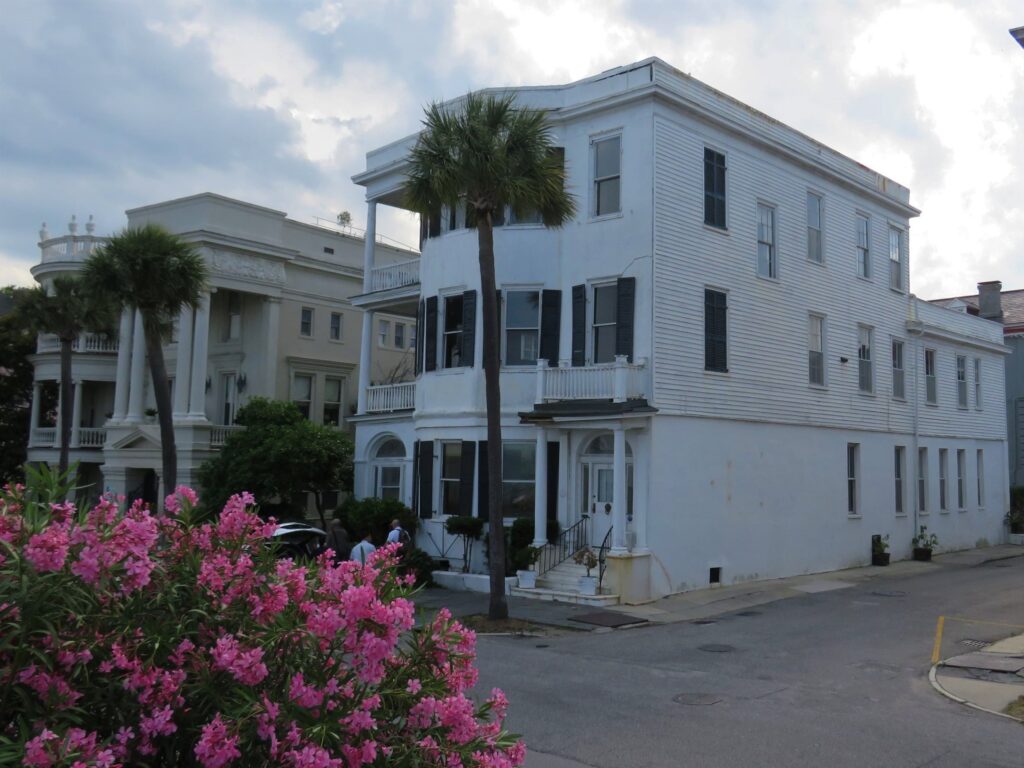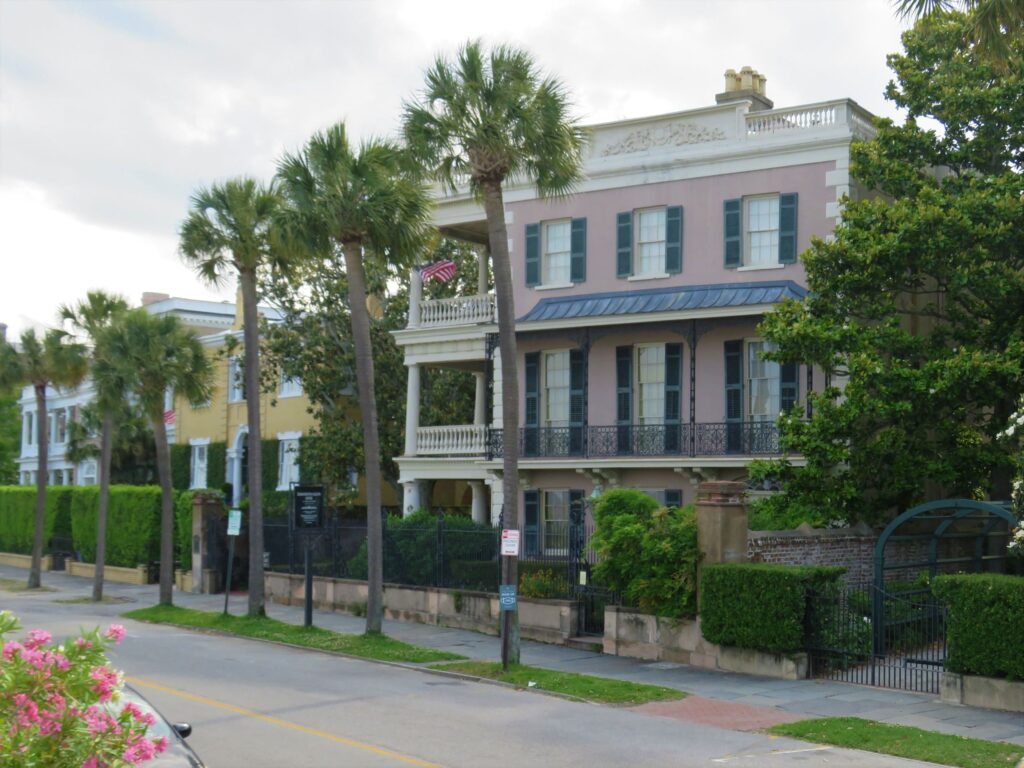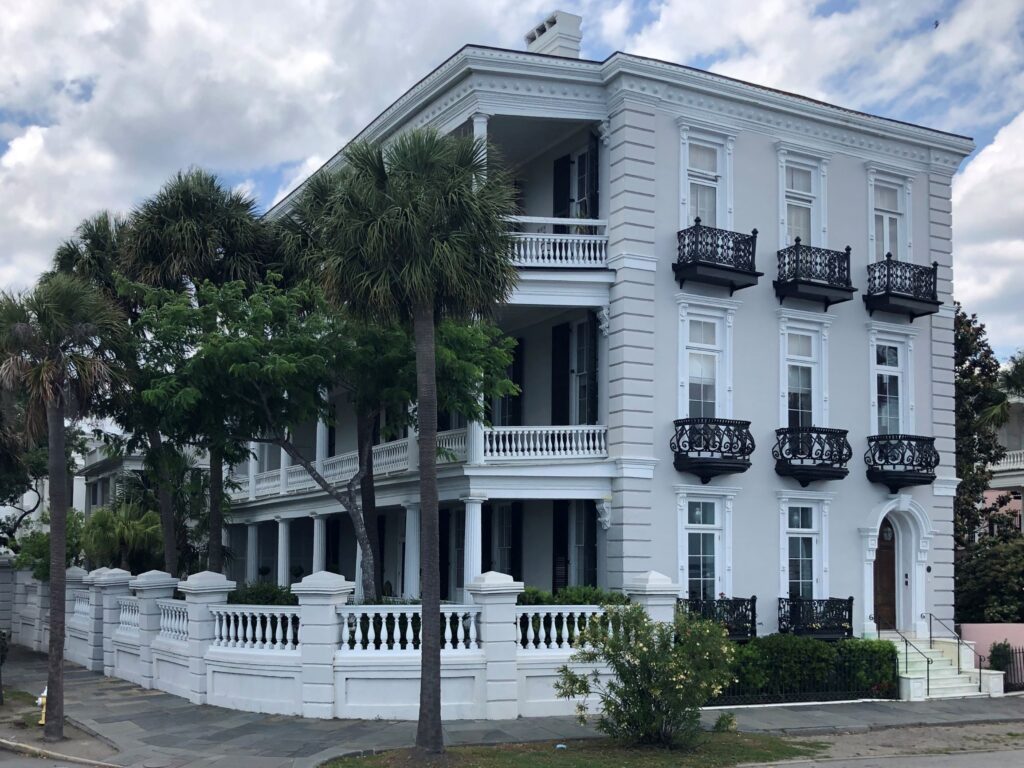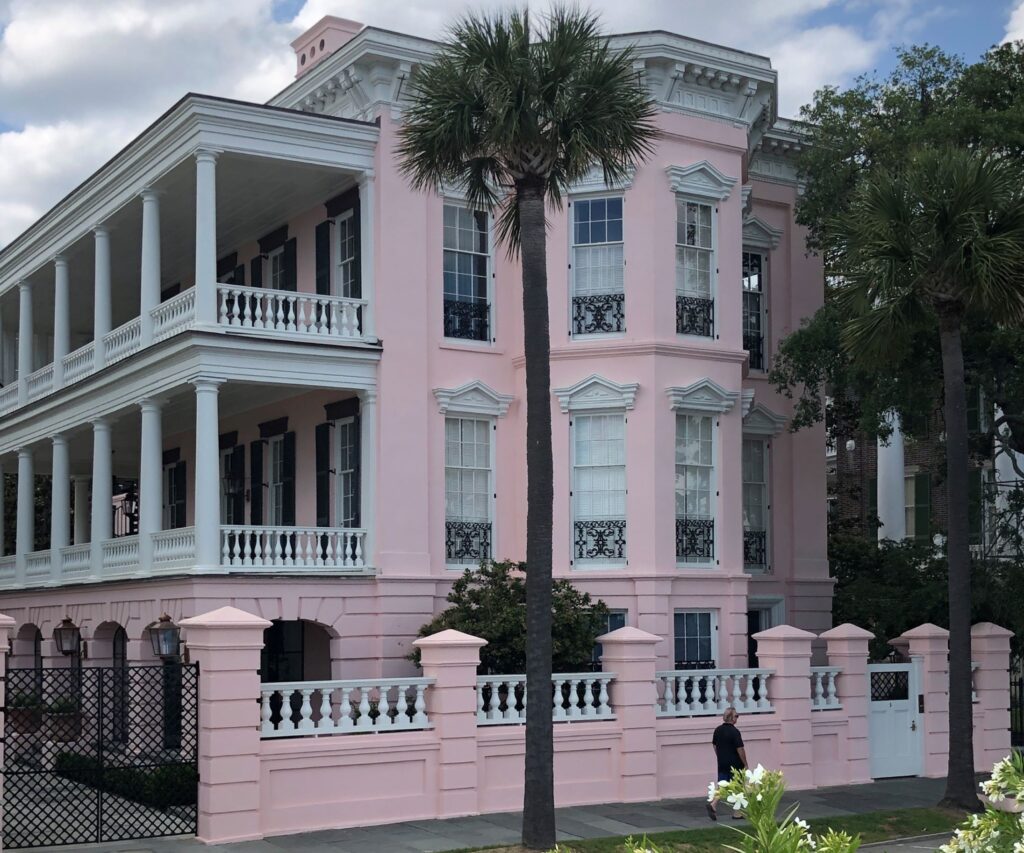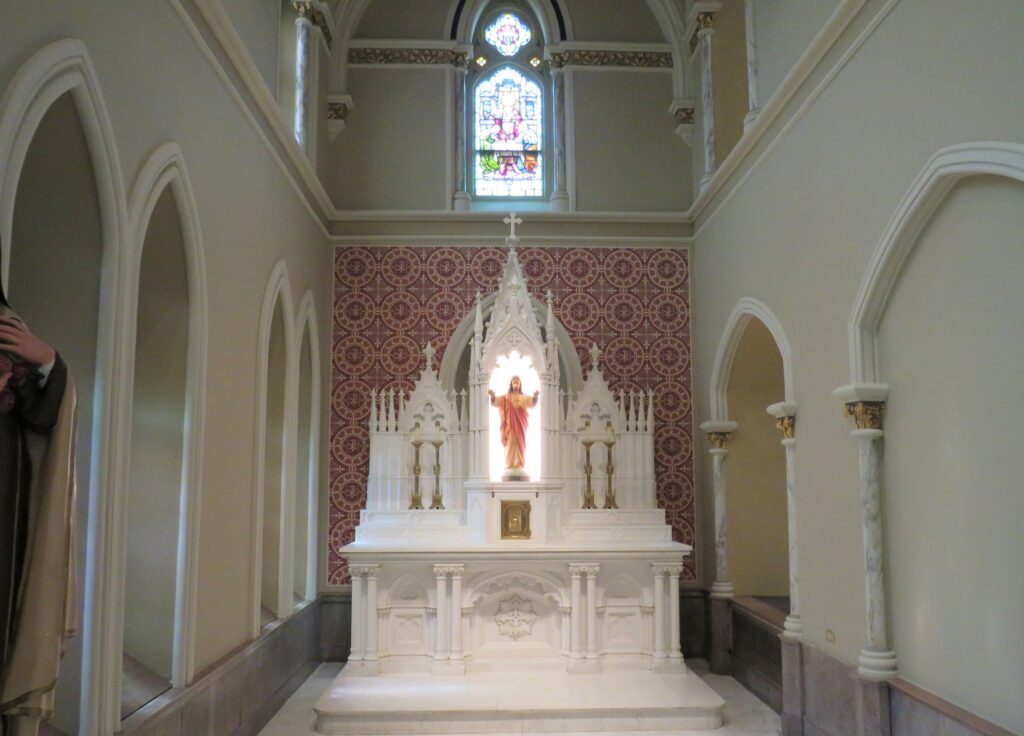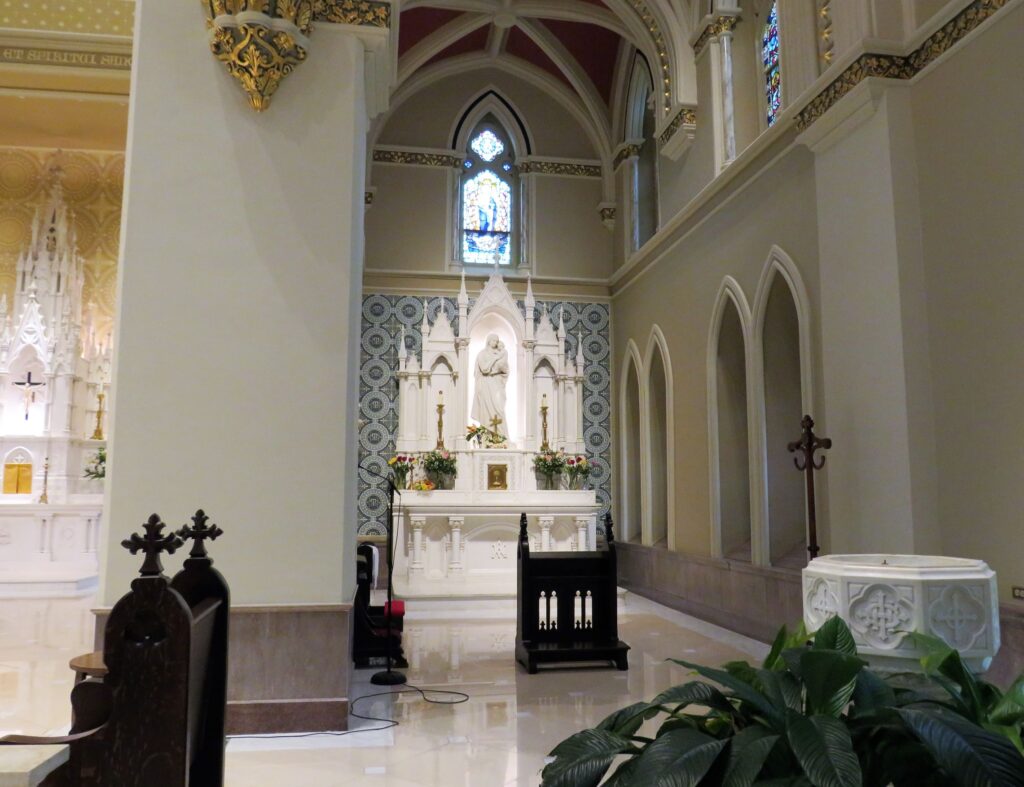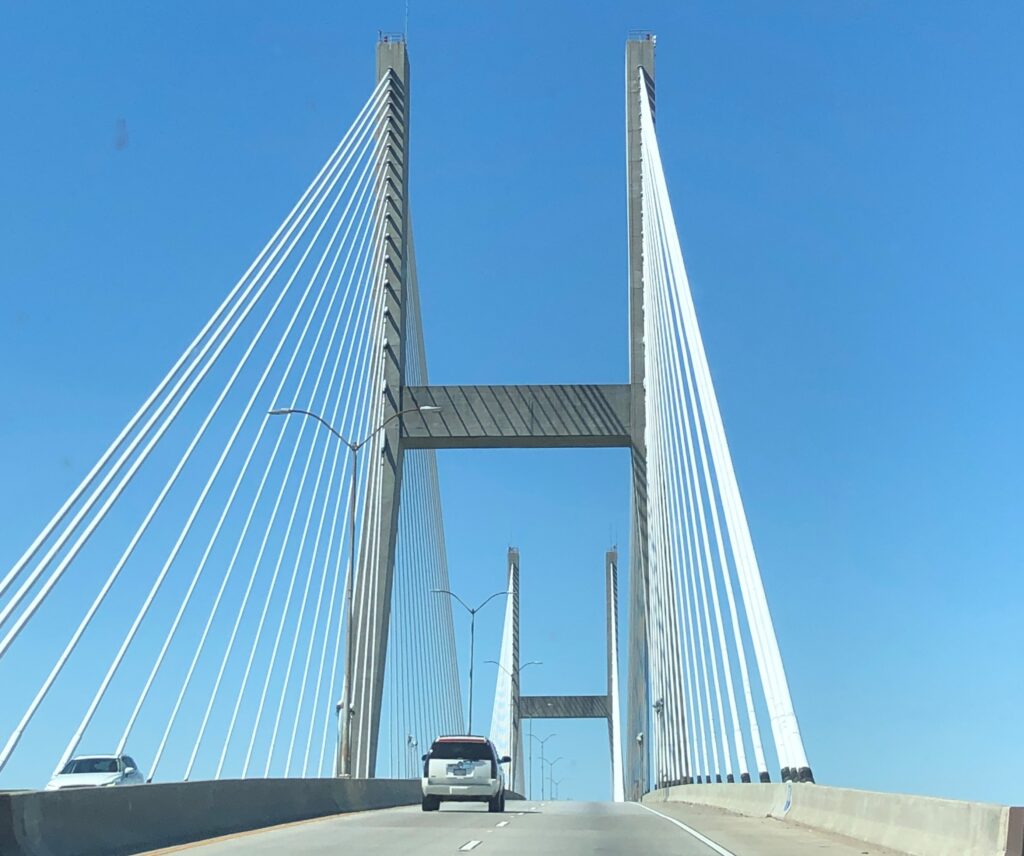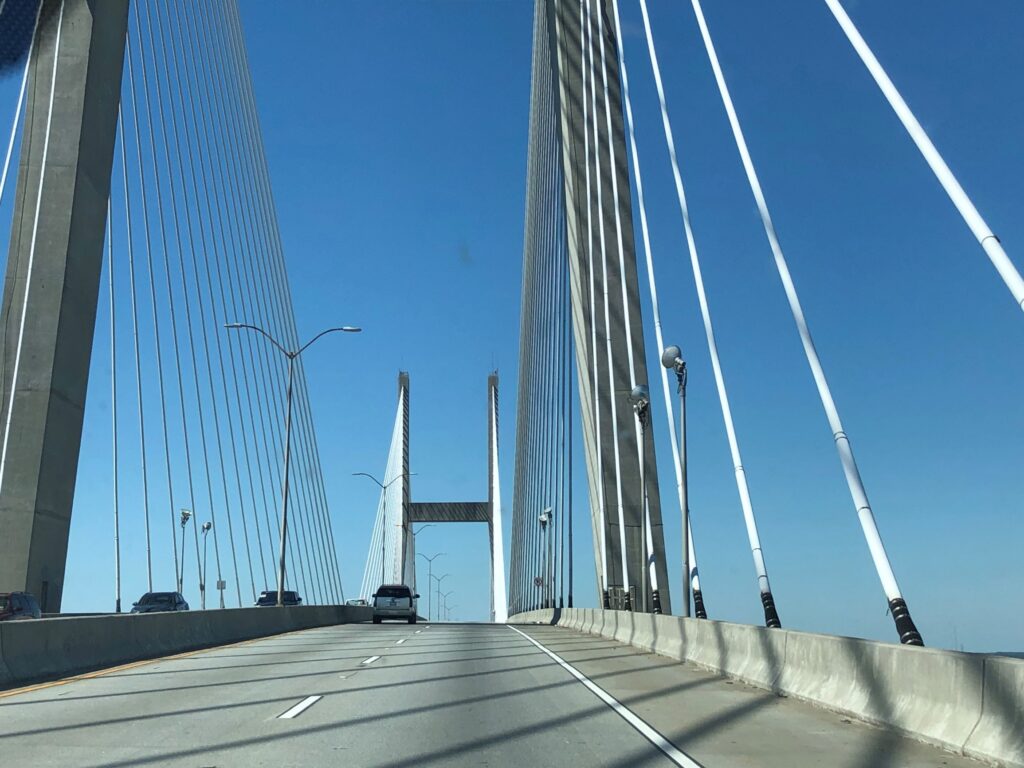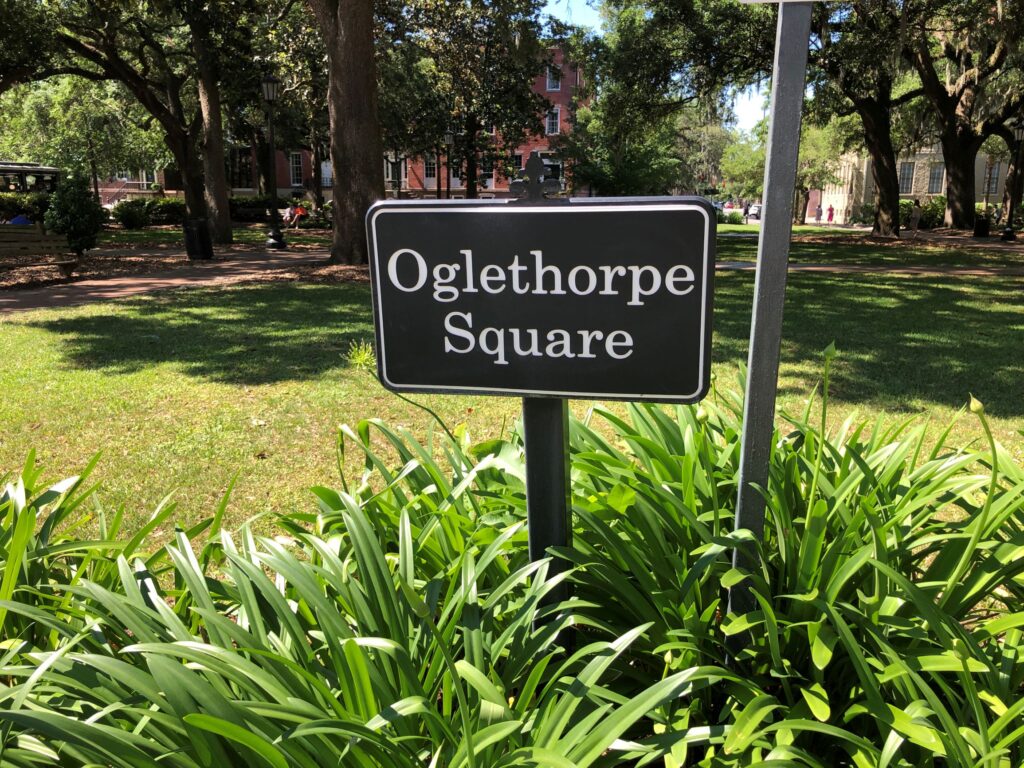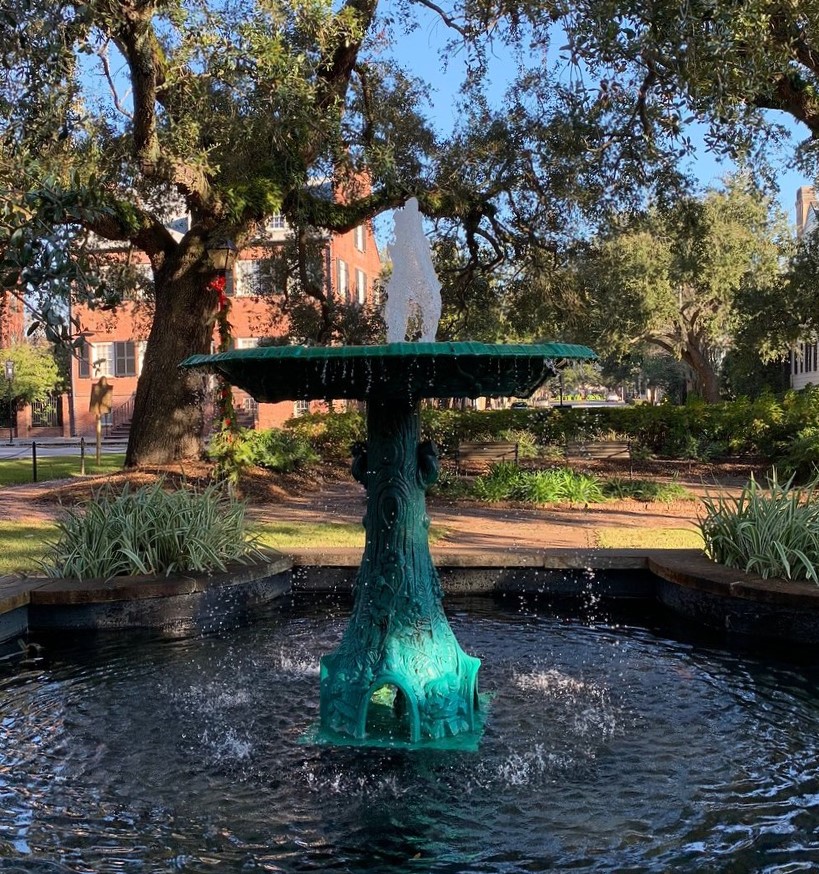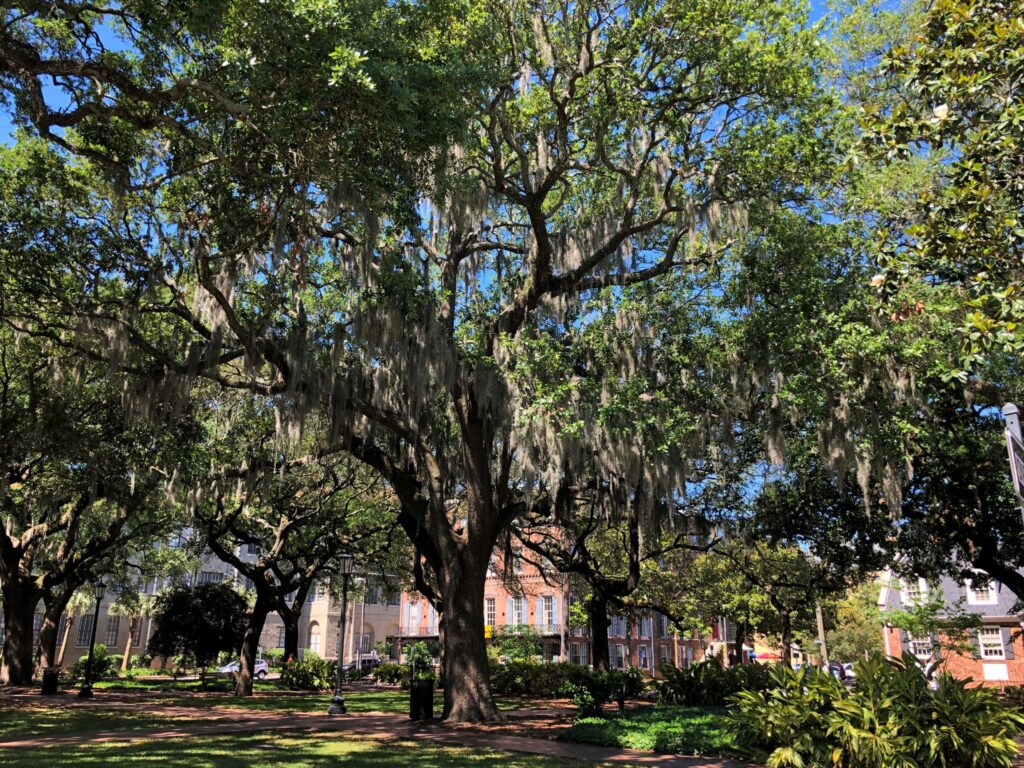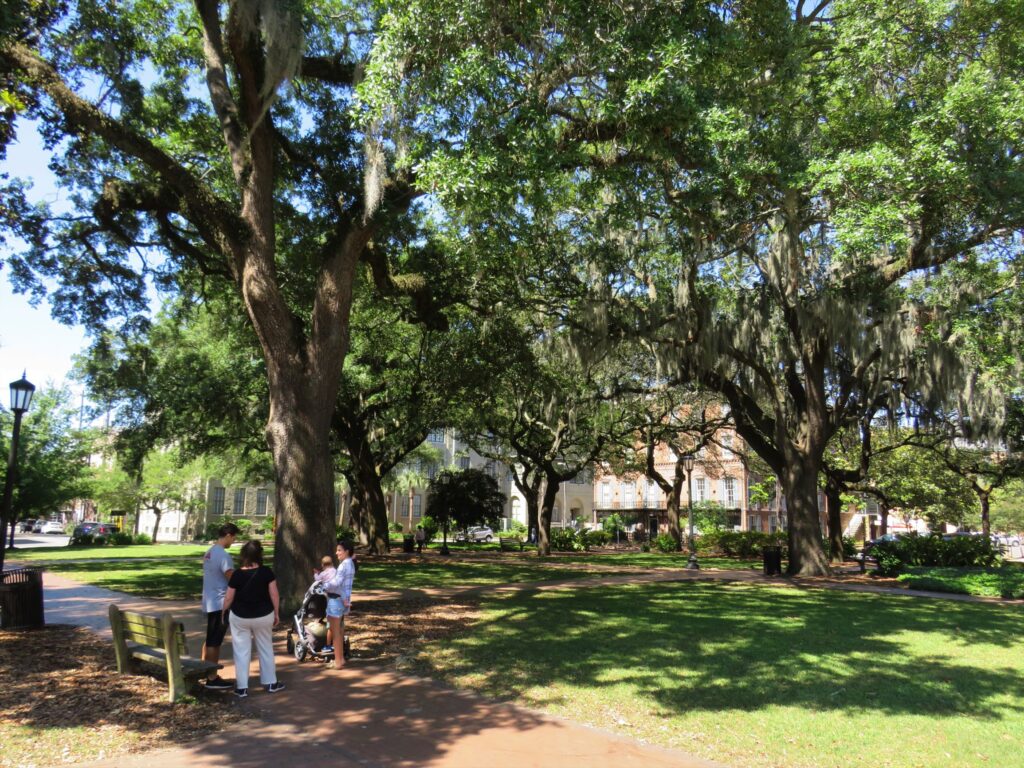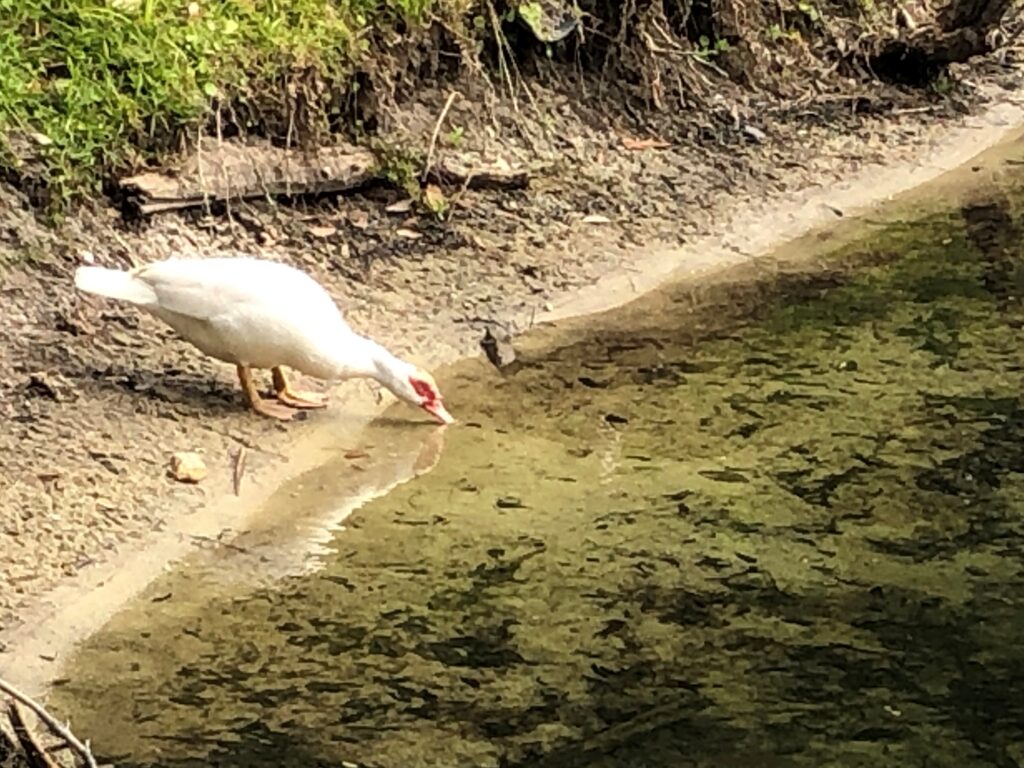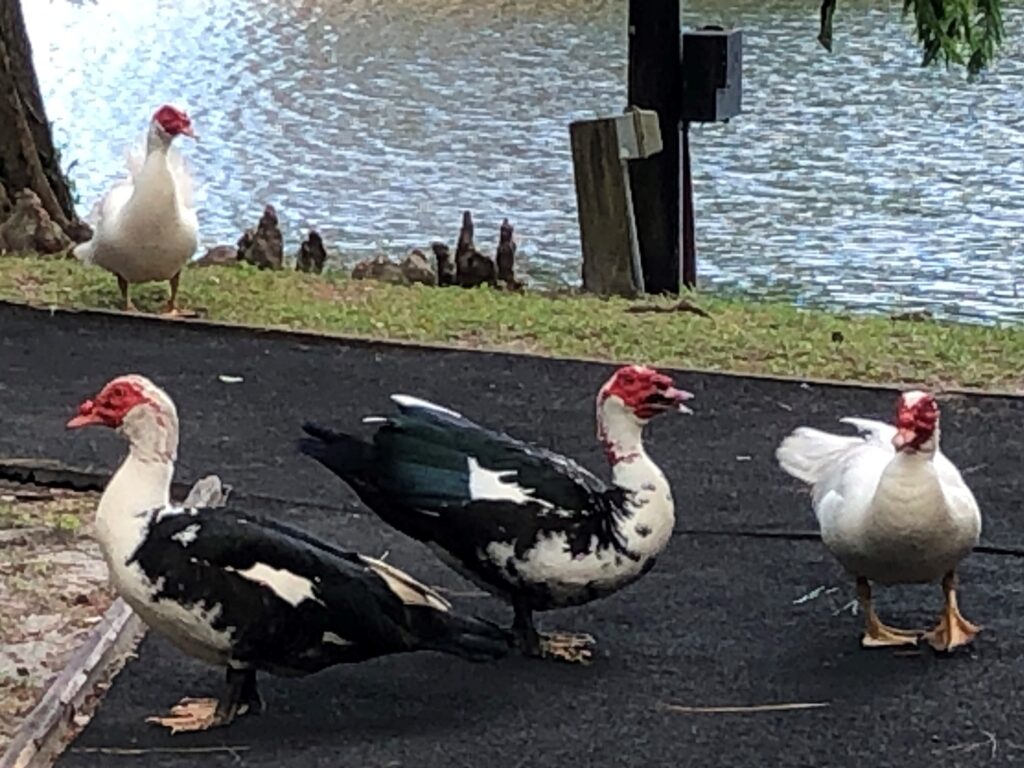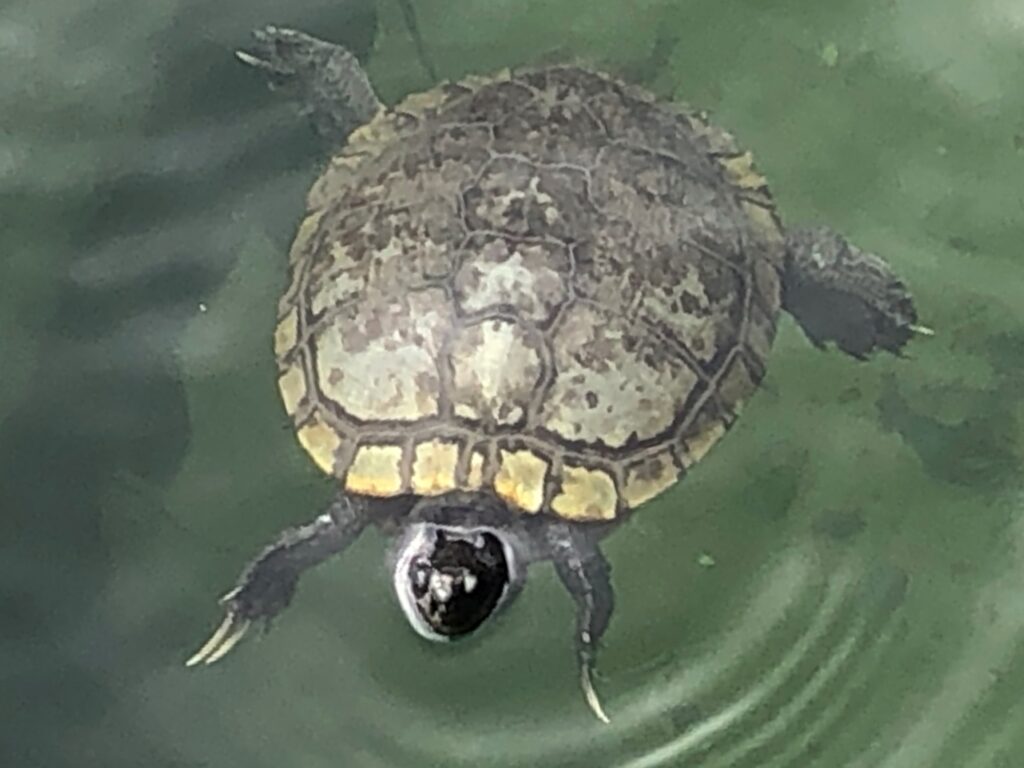On Friday May 7th, after a quick trip to Costco, we left Lexington, SC at 11am with Acey’s mileage at 72,323.3 and Thor has 83,891miles. Another short driving day; we arrived at the Thousand Trails park in Yemassee, SC just after 1pm. We had lunch, got set up and ran a few errands. We have a nice spot with full hook ups for our two week stay! This is a long blog with lots of details – we had a busy time here!
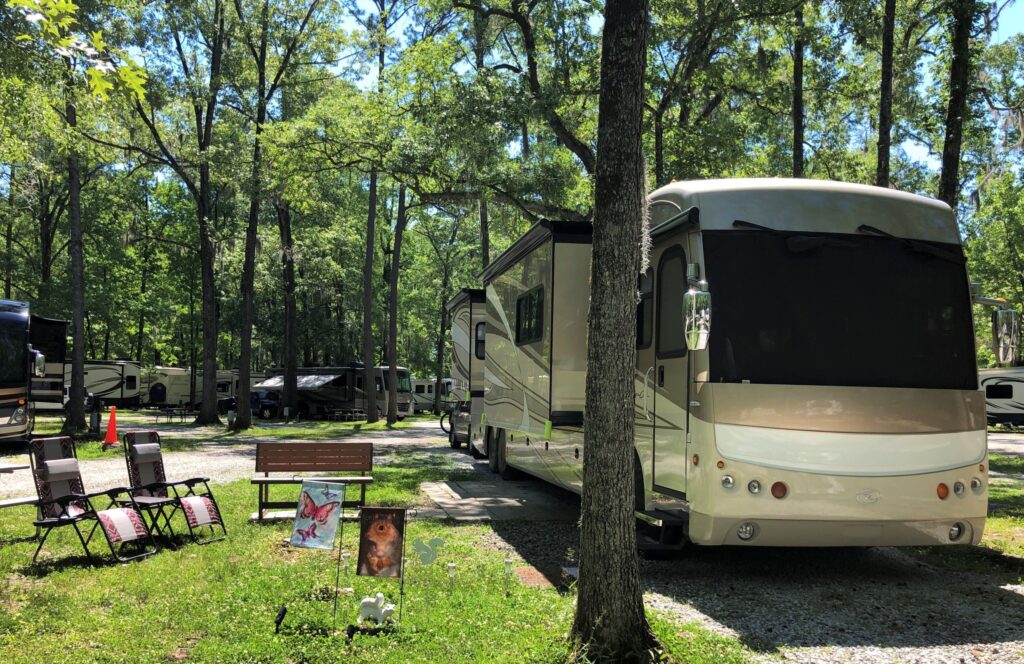
Saturday was a nice sunny day; we went for a bike ride on the Spanish Moss Trail.
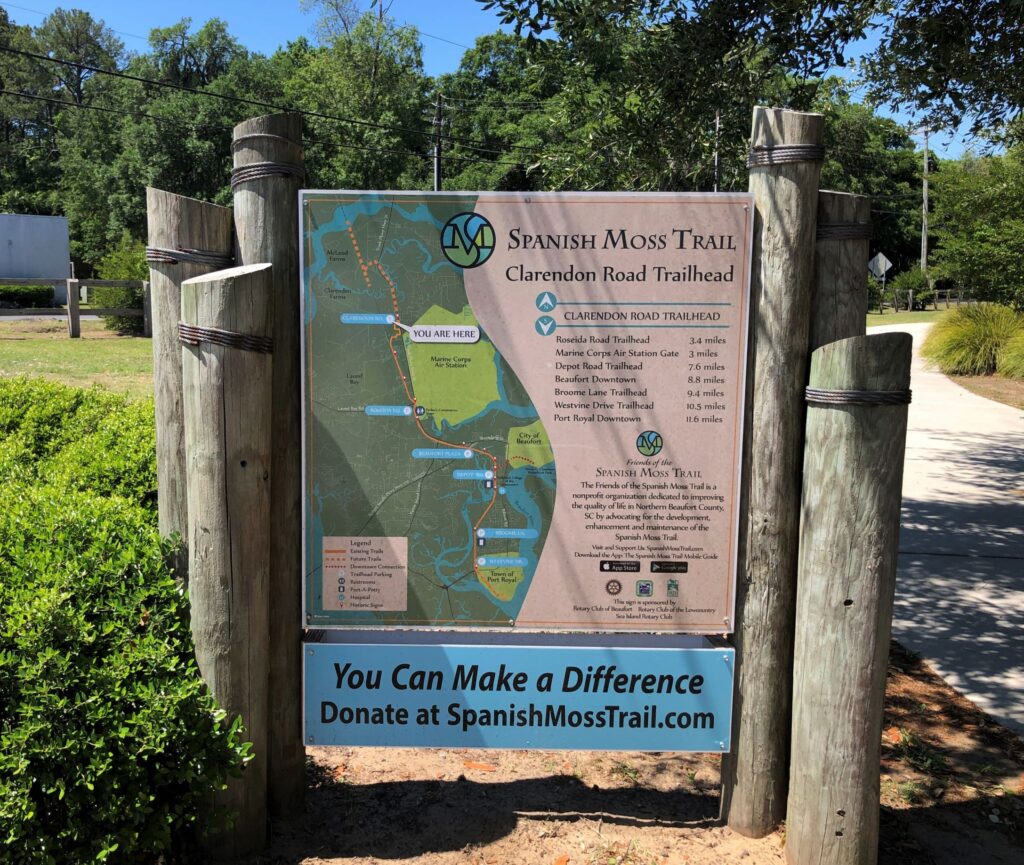
This very nice concrete trail (first concrete bike trail we have seen!) had many street crossings, some with traffic signals. It was a pretty ride with a few history stops along the way. Parts of the trail had sharp turns so we were surprised to read on the sign below that the trail runs along the historic Magnolia Line. The railroad depot had been located just behind this sign; we are imagining the concrete and steel shown below the sign may have been the edge of the depot platform?
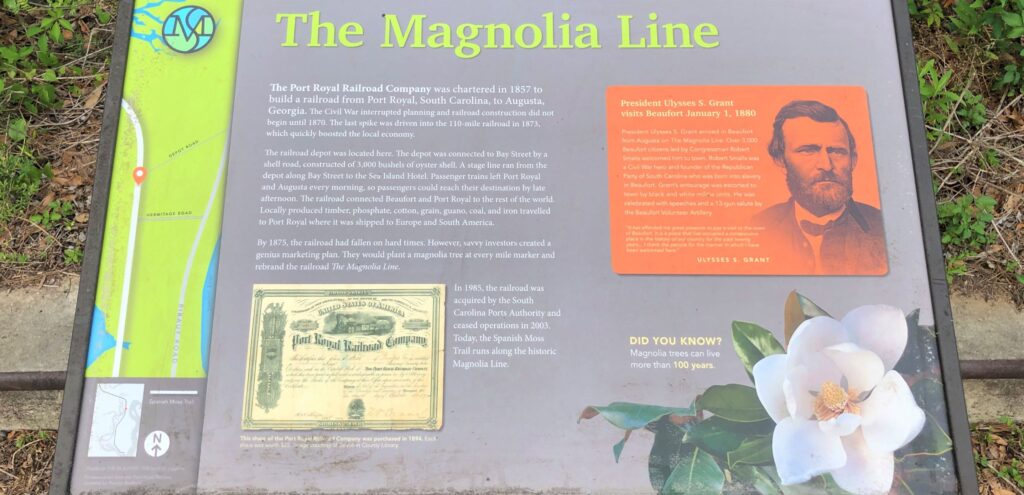
Just down from that sign was a building that had been a grocery warehouse in 1915; by the 1940s, it housed building supplies. The trail went next to and right through!
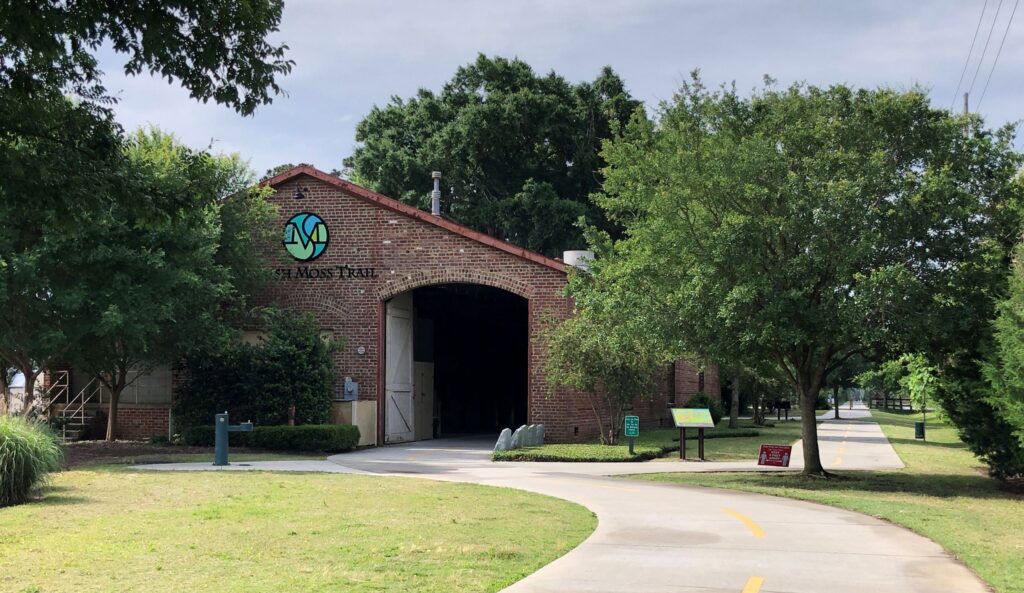
This sign indicated many businesses served by the railroad in 1912; Gulf Refining Co., People’s Ice & Fuel, N. Christensen & Sons Gen. Warehouse, Standard Oil Co., and the building pictured above, Charles E Danner & Co. grocery warehouse. It also pictures the Old Port Royal Railroad Depot – which was demolished in 1974.
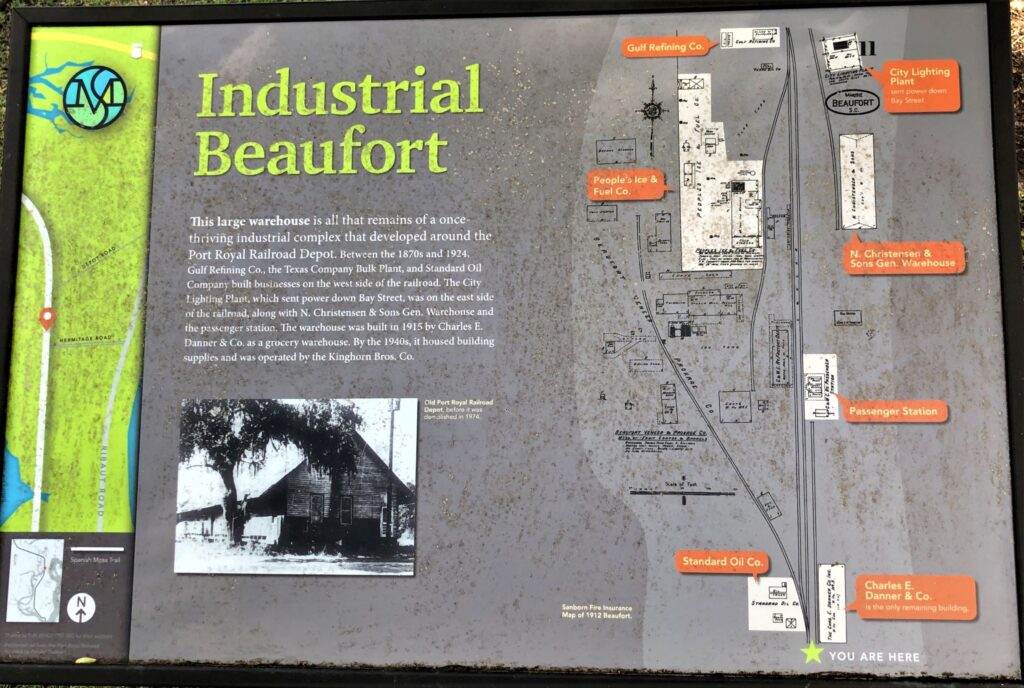
And somewhat of an eyesore, but a historic place – the Seacoast Packing Company.
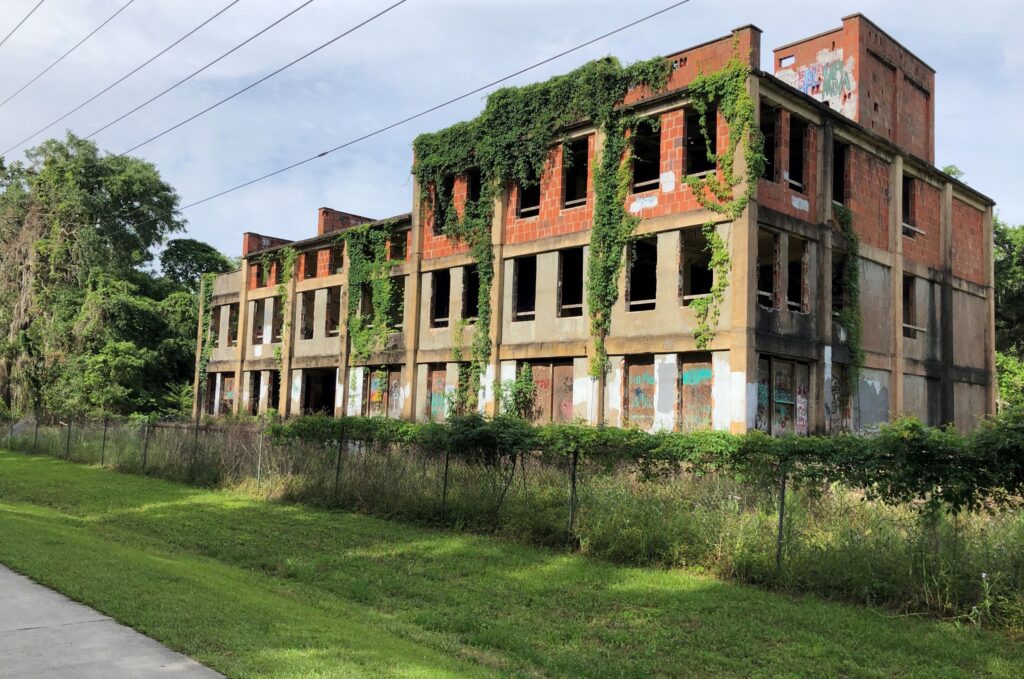
This abandoned building was completed in 1921. Wikipedia had this to say: “The Seacoast Packing Company is a historic packing house in Beaufort, South Carolina that was listed on the National Register of Historic Places in 2008. Also known as Peninsular Canning Company/Pig Factory and as Pickle Factory, it was built by Brooks Engineering.”
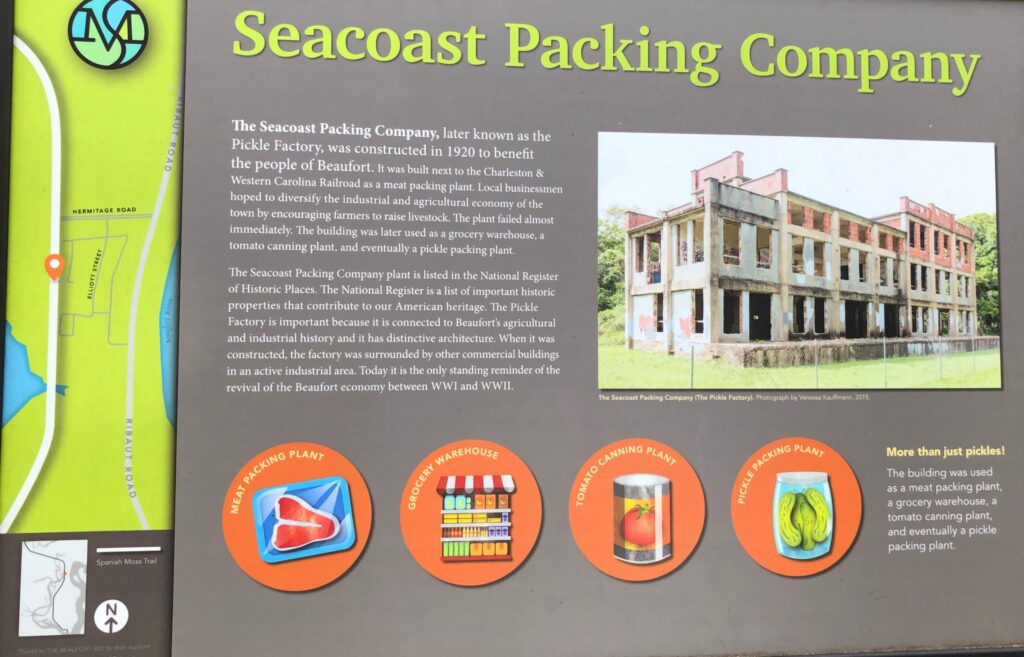
We rode to the end of the paved trail; they hope to finish the trail to Port Royal, adding 2 miles.
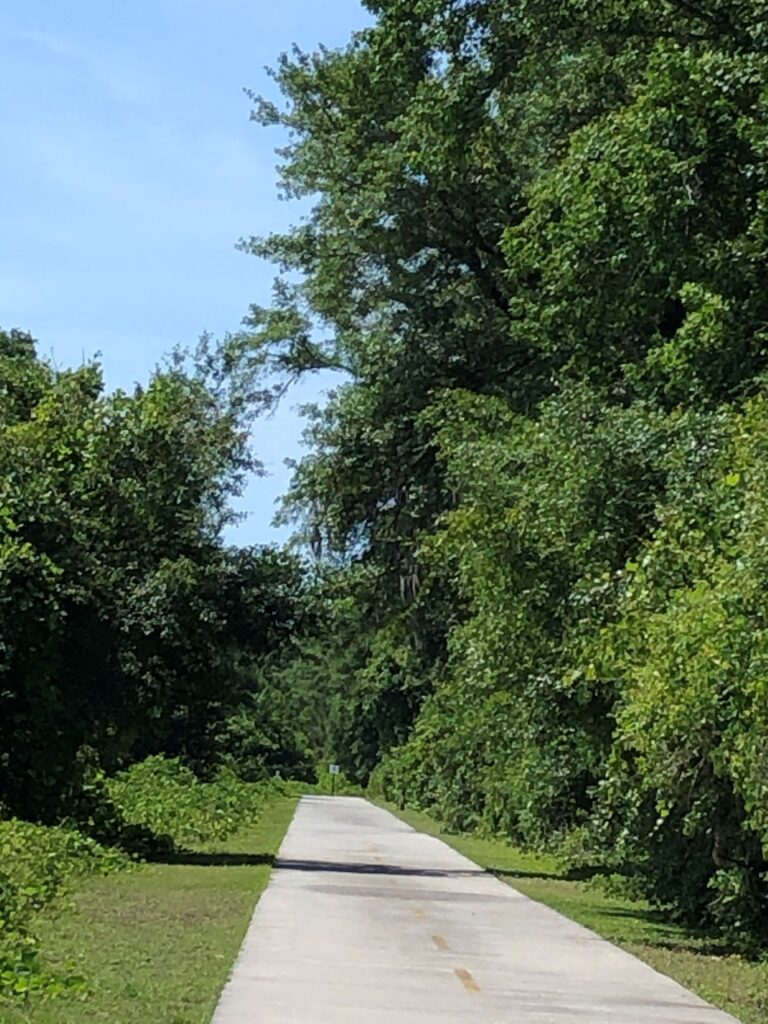
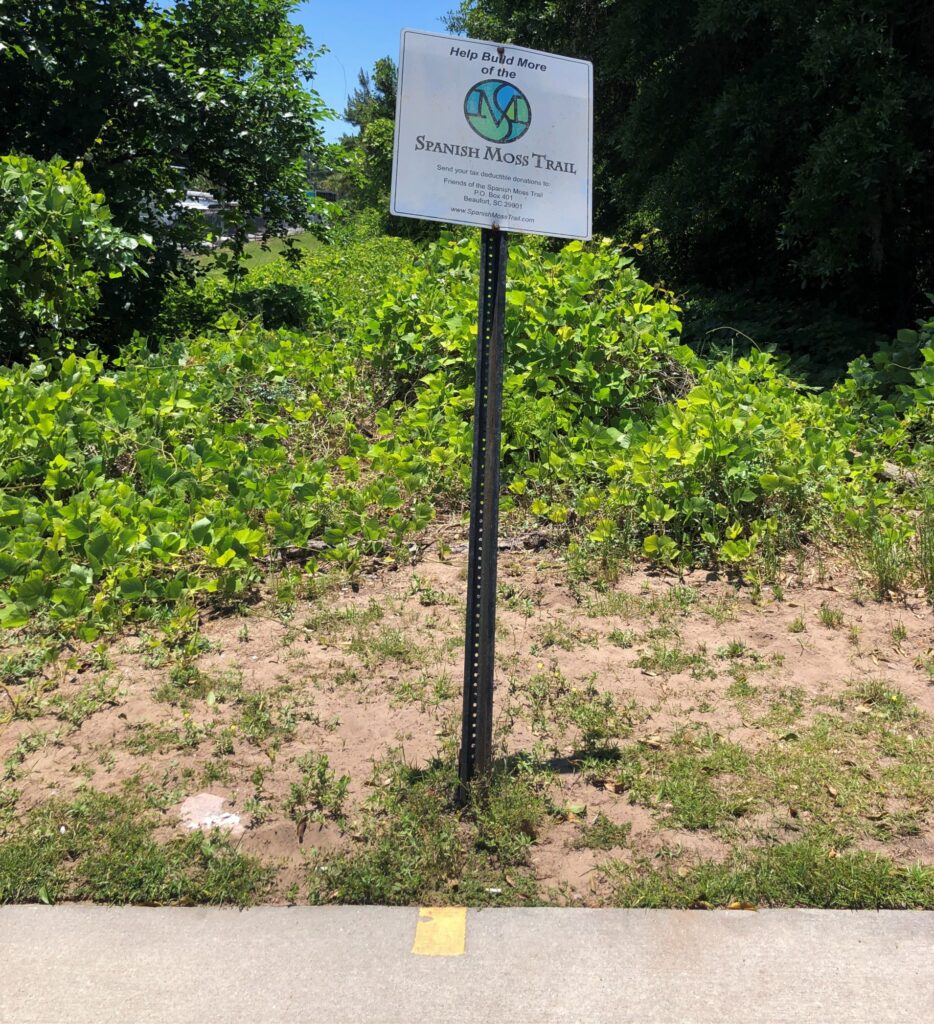
We ate our packed lunch on a bench near the end of the trail and watched as a wren built a nest in the back of the trailhead sign. When we returned on Monday, there were 2 eggs in the nest!
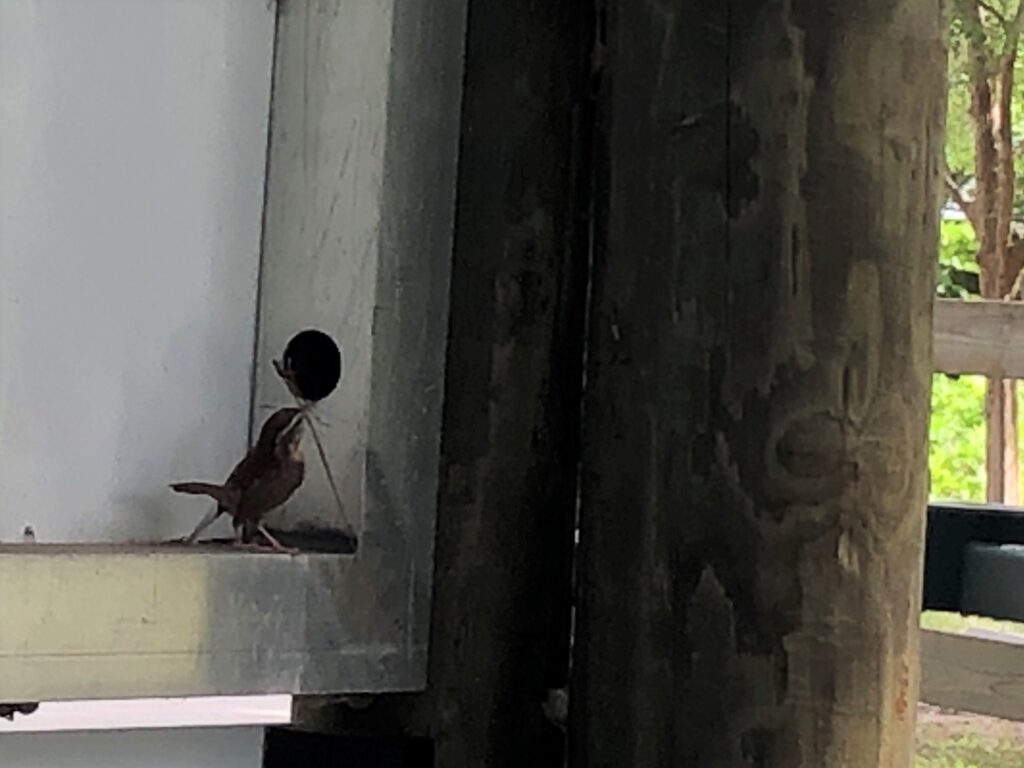
It was a scenic ride in the Low Country!
There were some flowers along the trail.
And, YES! – there was Spanish moss in the trees along the Spanish Moss Trail!
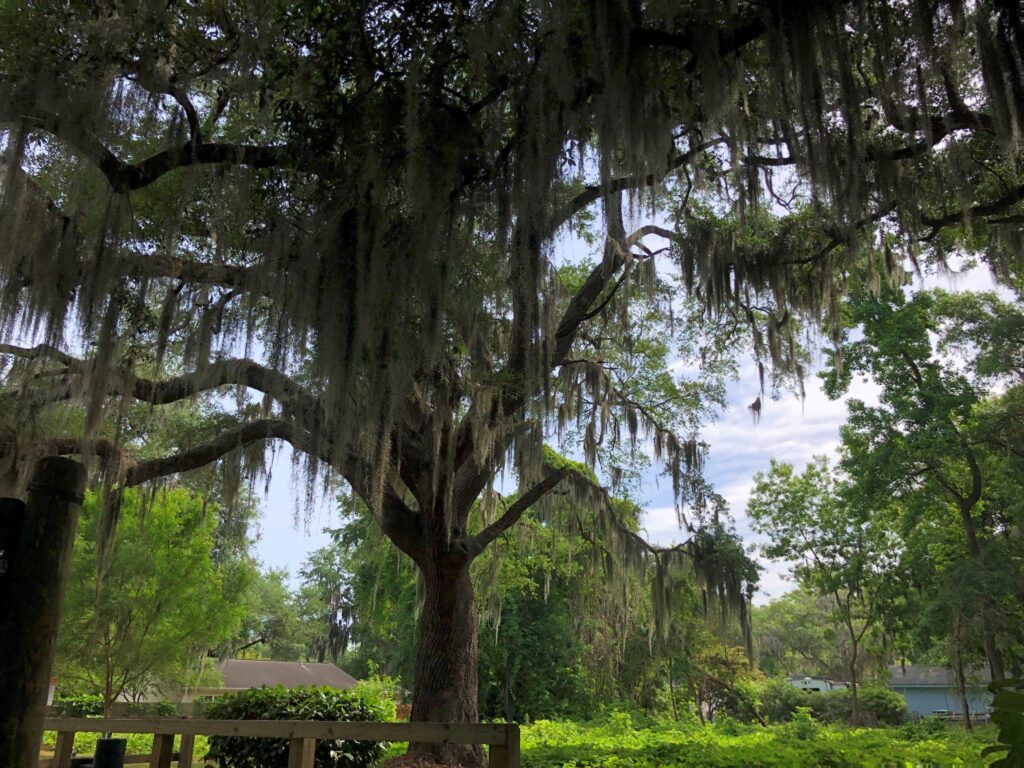
Even some on this dead tree; the photo makes it look wet…
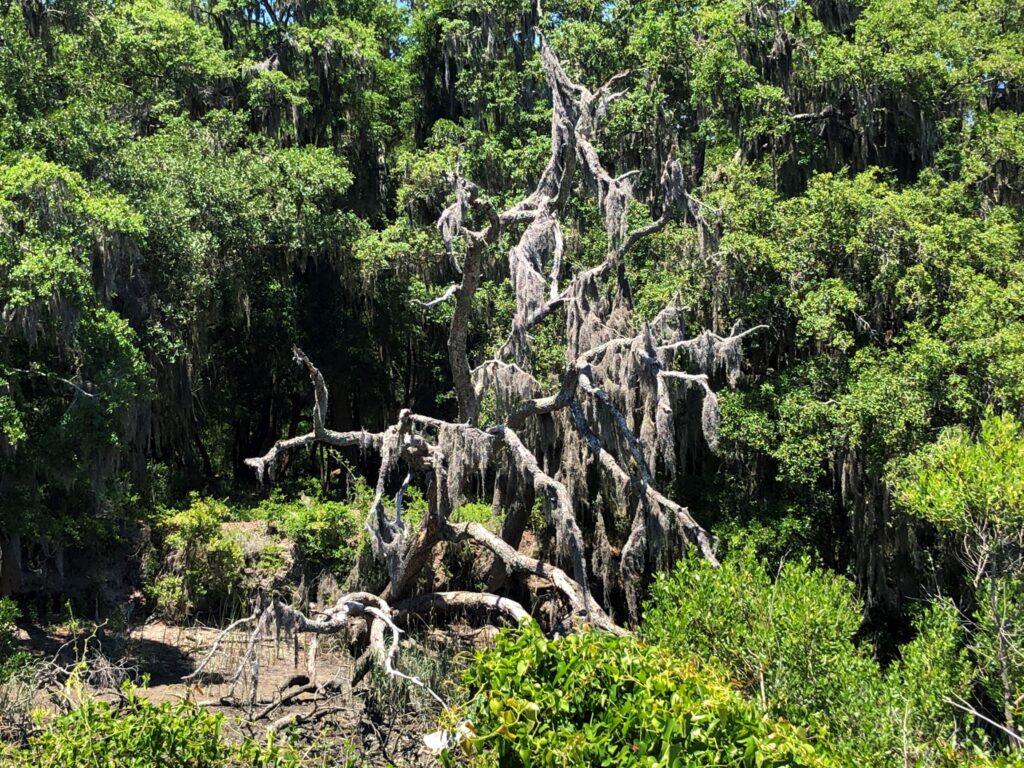
We have been on many bike trails far from “civilization”; we found this sign to be kind of funny…
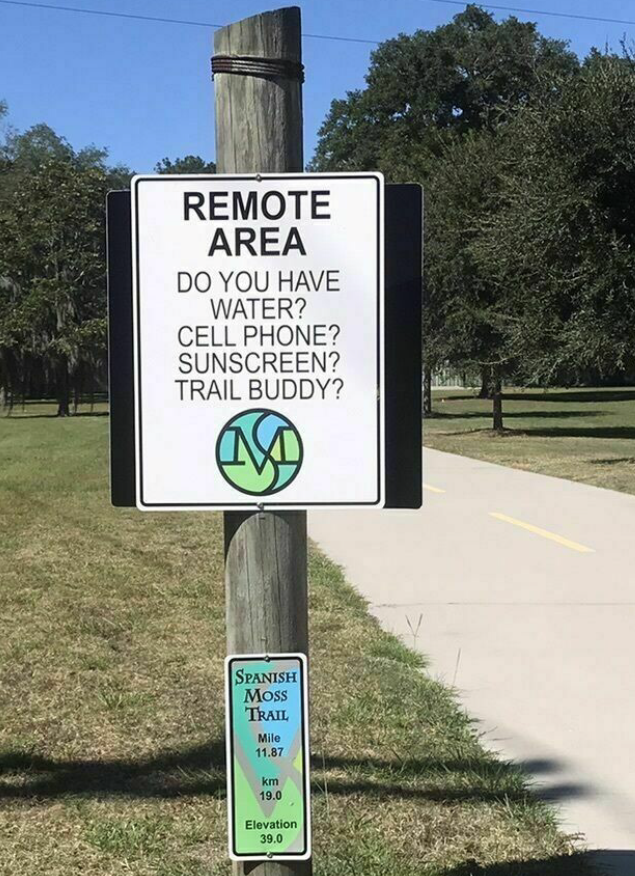
There were a few concrete mile markers that remained from the train route – not sure what city they measured the distance from, but probably Richmond, VA.
When we finished our ride, a second look at the the sign at the trailhead showed that much of the trail does indeed look like a train route with some variations. You can see that they hope to extend this 12 foot wide trail in both directions.
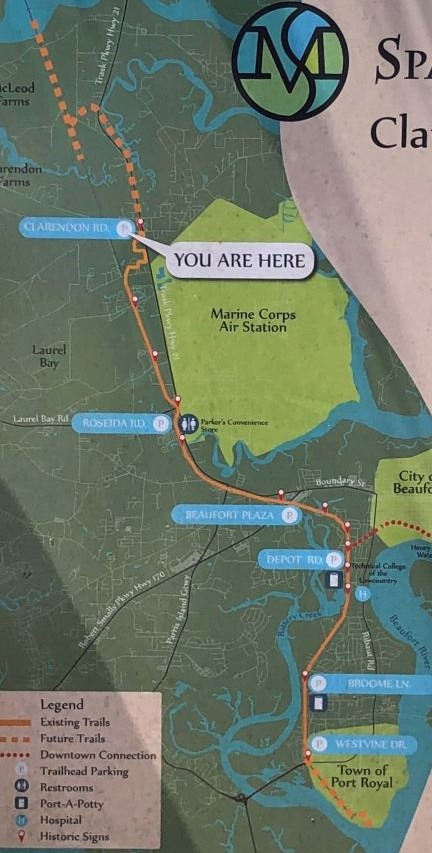
We rode just over 22 miles, including a stop at Lowe’s for some connectors to hook up the cable TV. We have now ridden our bikes over 1,000 miles since we left Nashville on May 27, 2020.
Sunday we zoomed with our Sunday School Class and worshipped via You Tube with our home church in Nashville – Stephens Valley Church. After lunch. we walked around the RV Park and saw some turtles sunning themselves on logs.
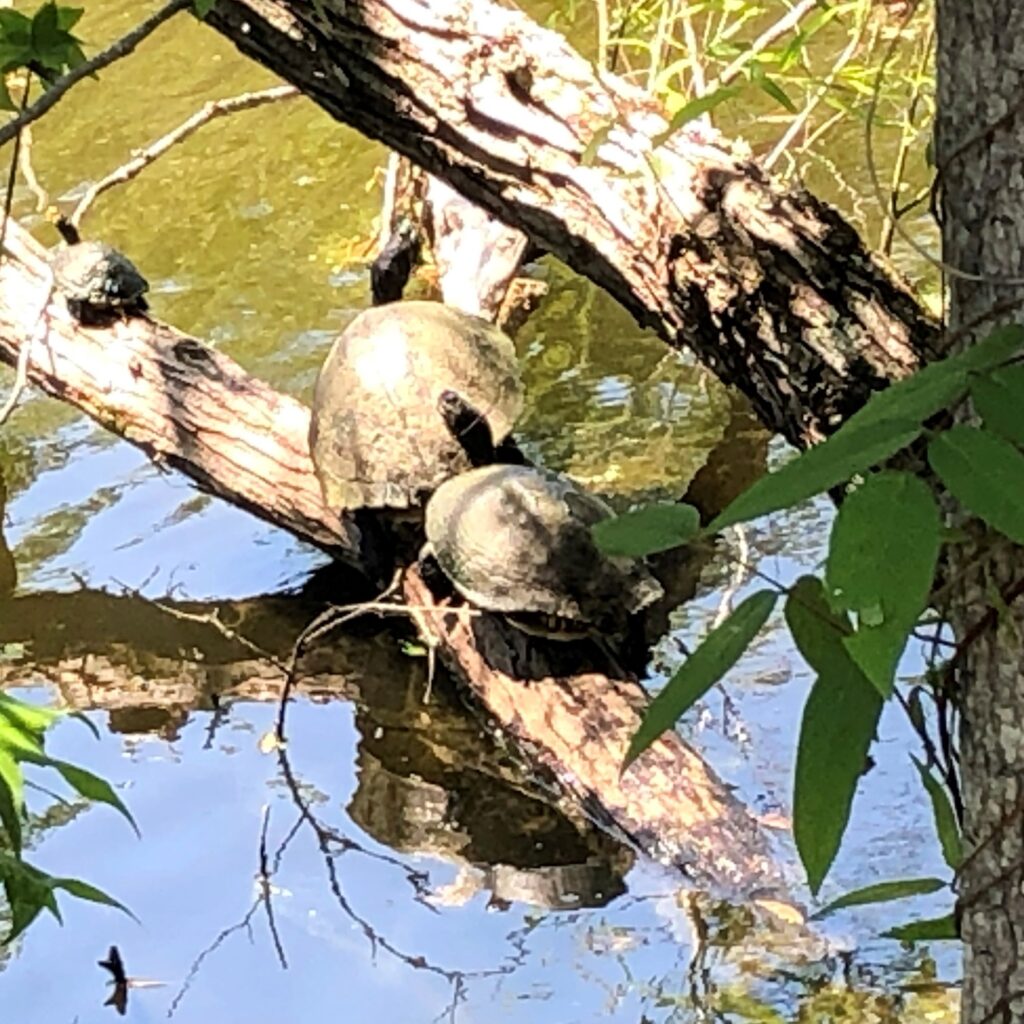
The algae was quite thick in some places…
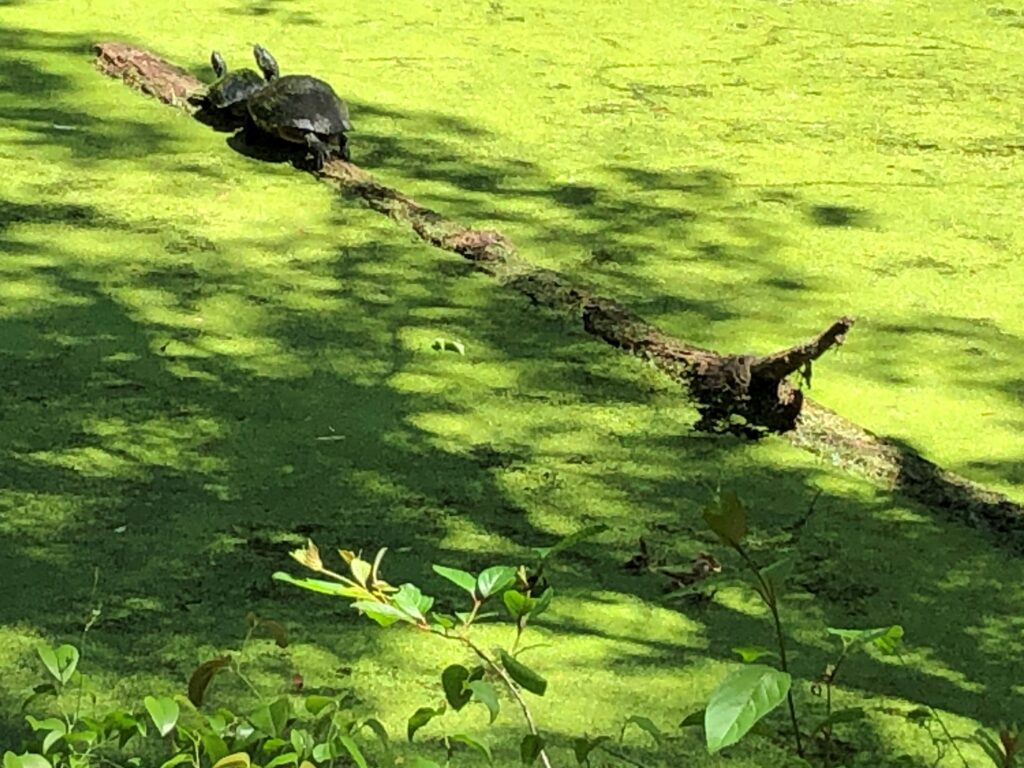
…and we saw some alligators! Some, you can only see their head, and we could hear a few plop into the water as we came near.
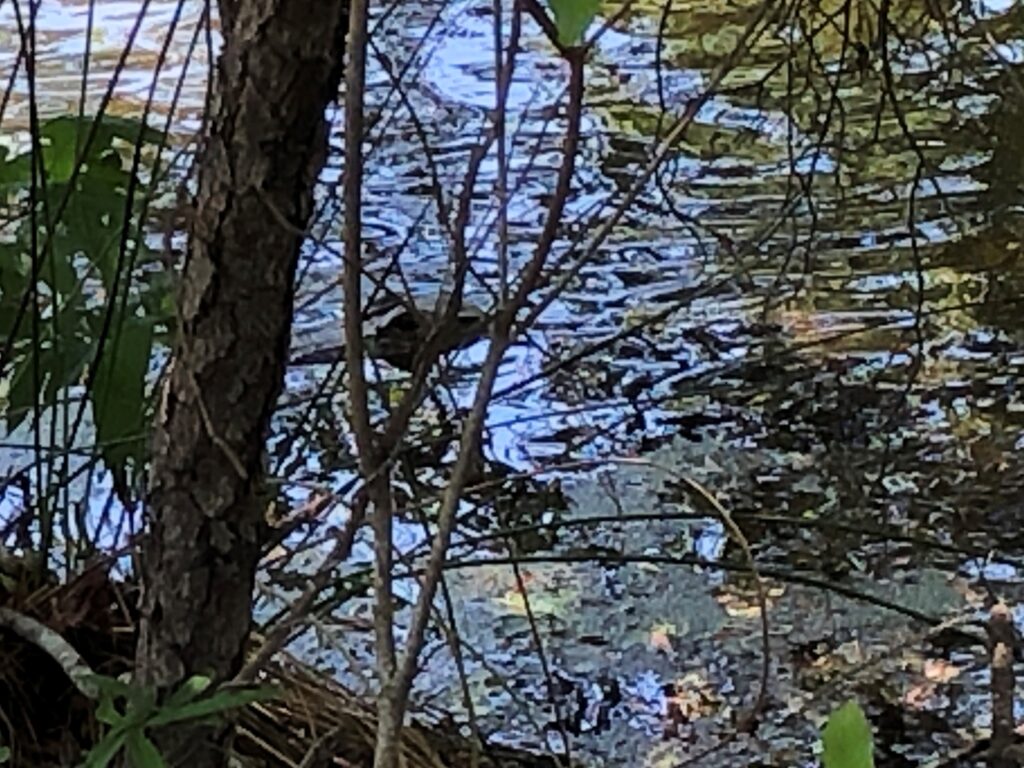
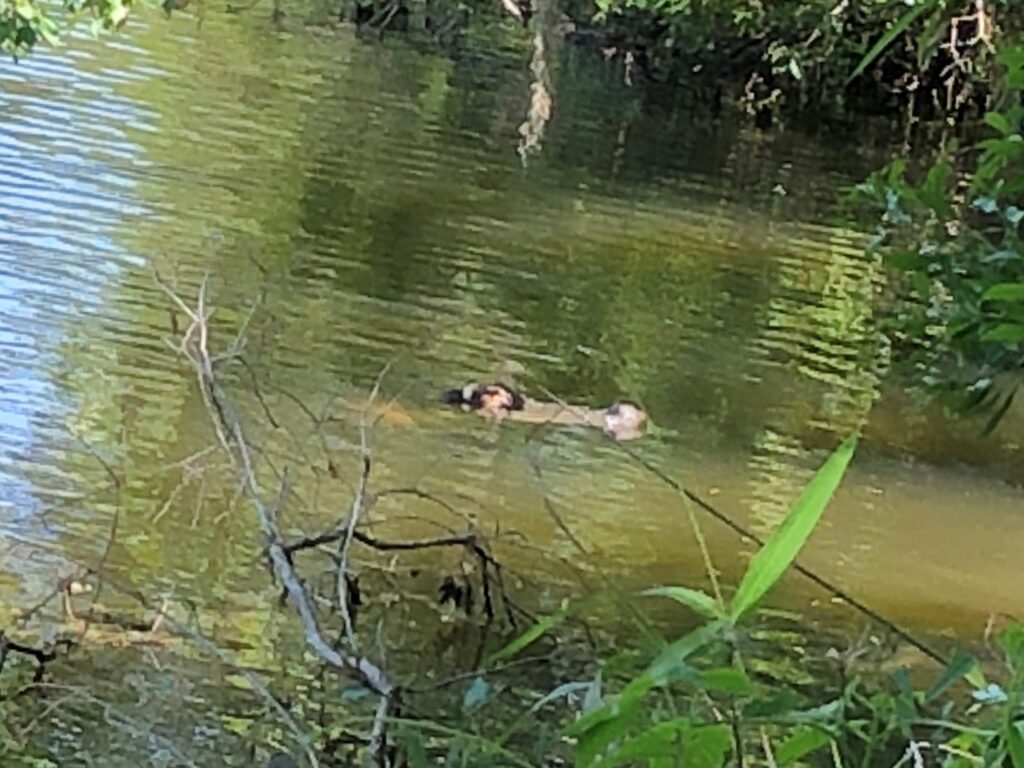
There definitely were several in the area!
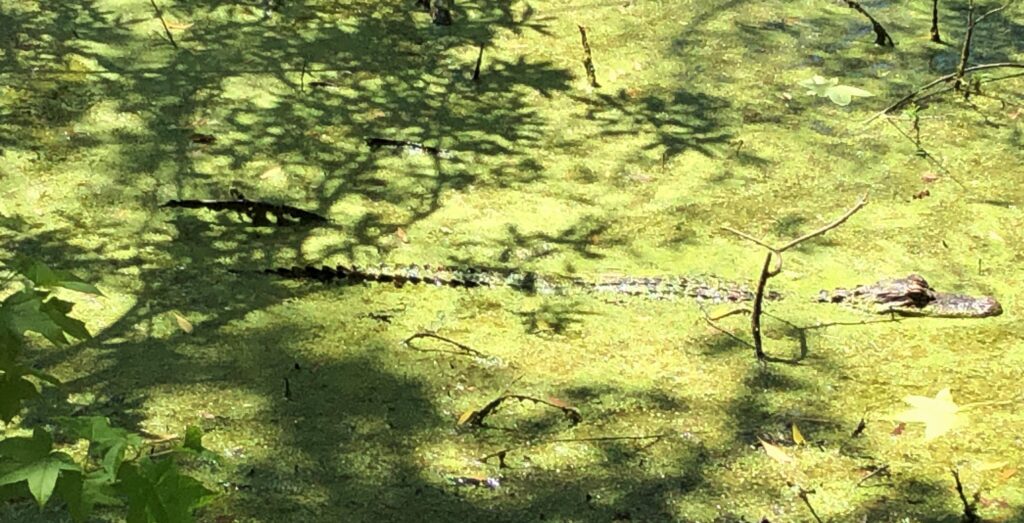
Monday, we got an early start and drove in to Beaufort to drop off Thor at Discount Tires at 9:30.
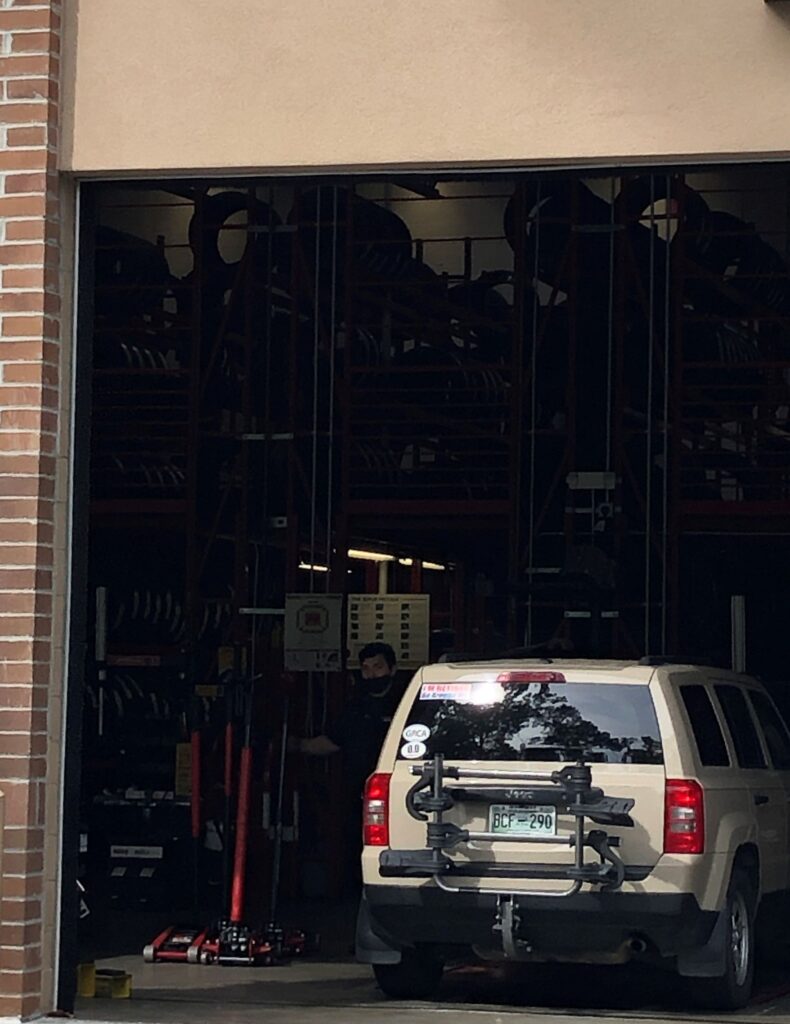
While they installed the new tires, we bicycled again on the Spanish Moss Trail. This yellow caboose was almost hidden next to the trail. There was no sign – could it be someone’s personal acquisition to restore?
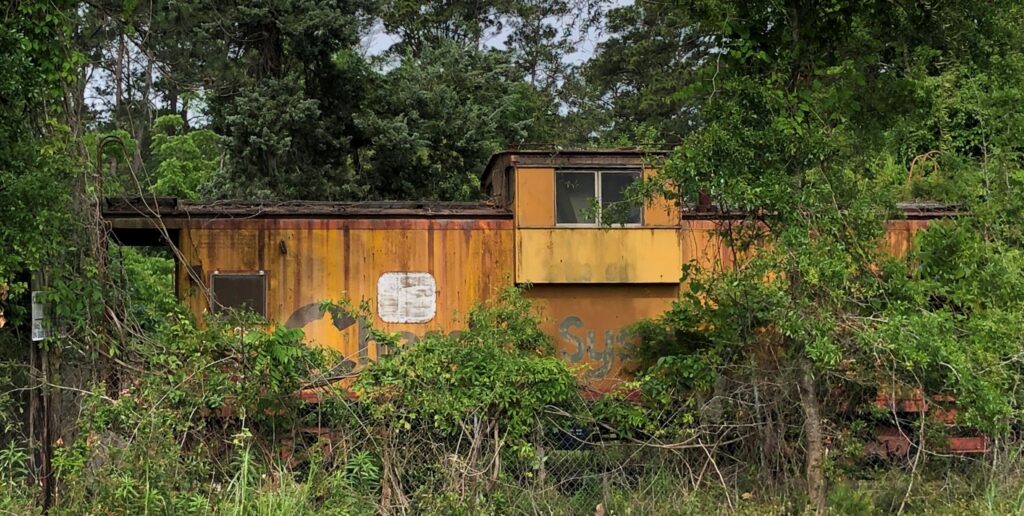
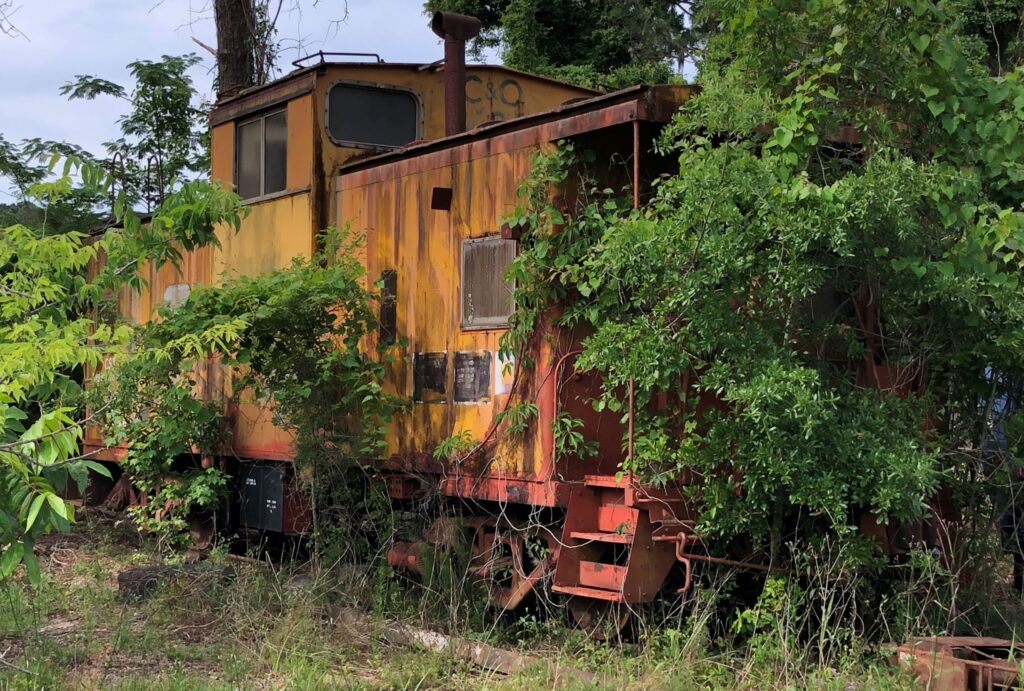
We found this much better photo online, taken in 2008 – this is the C & O 3100 caboose; We think it is the first one of a series of 226 extended vision cabooses built in 1968.
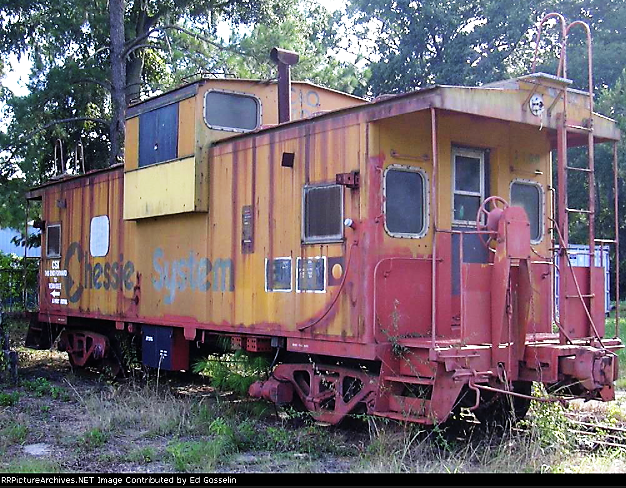
There was a baby alligator (maybe 18″) on the trail ahead of us; it was funny to see it wobble and flop about as it tried hard to get footing on the concrete trail and tried to run! It was chomping his jaws as we rode past. We didn’t stop for pictures in case Mama was nearby. It reminded us of “Chomps” the baby gator we held before we went on an airboat ride with the family back in 2008. (Look close and you may notice there is a rubber band on its mouth)
There was a boardwalk/bridge over a pond that was full of lily pads and begged for a photo or two!

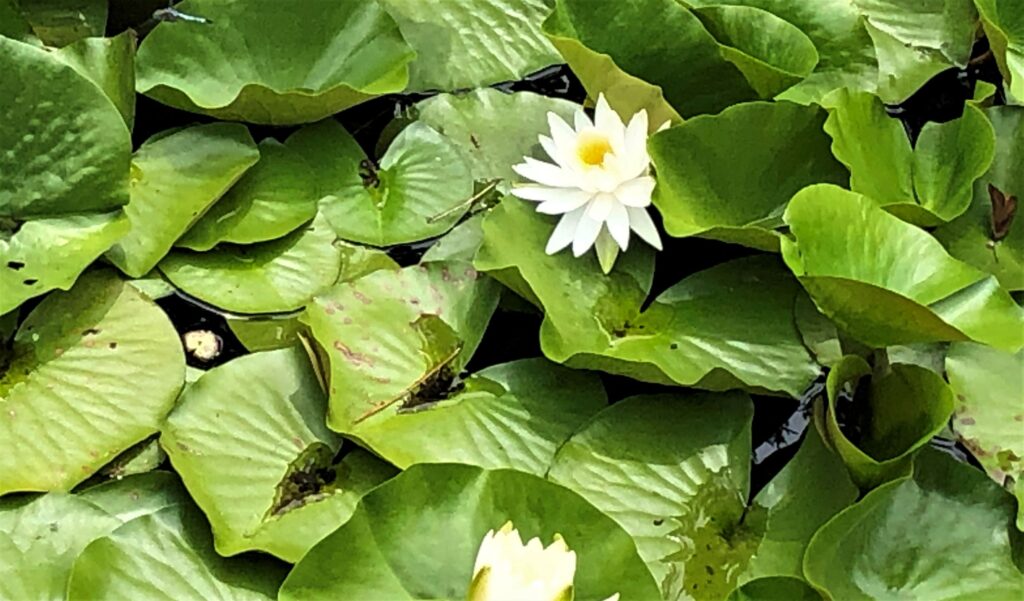
It was 80F by the time we had lunch, and it was humid – we felt like it was time to quit – we rode 15 miles today.
Tuesday we went to explore Charleston! Our first stop was on Wadmalaw Island at the Charleston Tea Garden; the only tea garden in North America was established in 1987!
On the front porch, Linda met Waddy, the mascot of the Charleston Tea Garden.
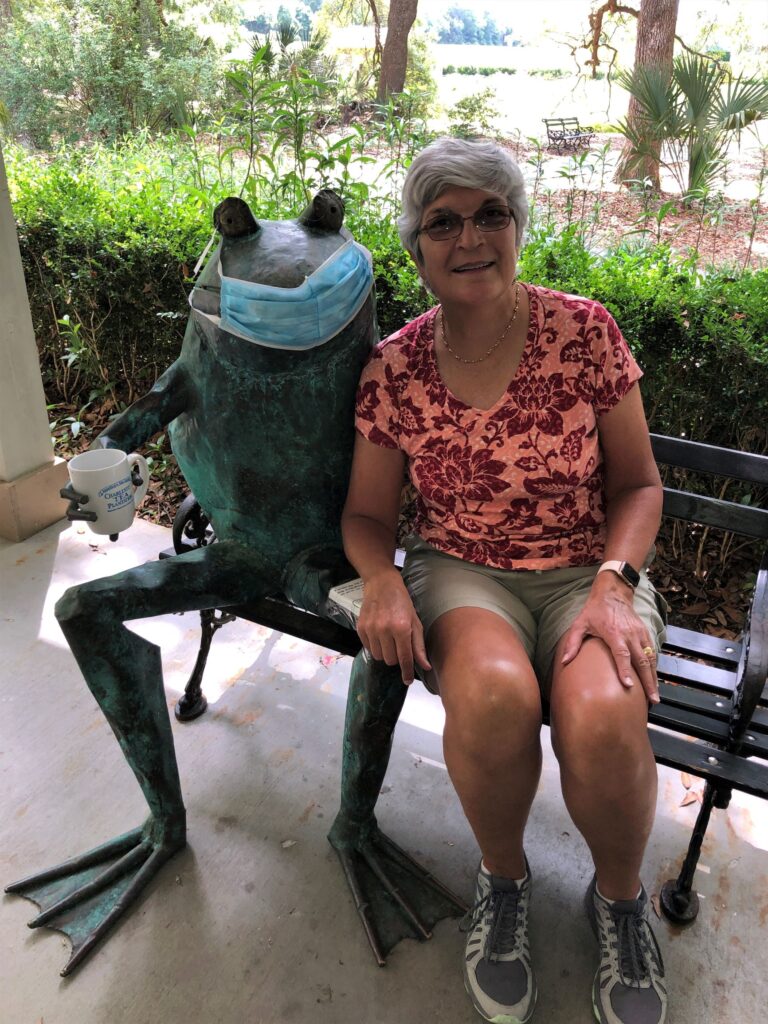
There was a nice gift shop with all sorts of tea-related merchandise – and of course tea! There was a free tea bar where you could sample a few of their teas hot or cold. They had a free “factory tour” where you could see the machines that process the tea – the machines were not running, but there were several video stops along the way where the process of harvesting to finished product was explained. Very interesting!
Below is the “Green Giant” – the machine that harvests the tea – they cut off the top 3-4″ of new growth to make their tea. I’m thinking they said they get 3 harvests a year – and get 1/3 the original harvest weight as a finished product, after drying and removing stems and fibers. You can see some of the hedges of tea plants behind the machine.
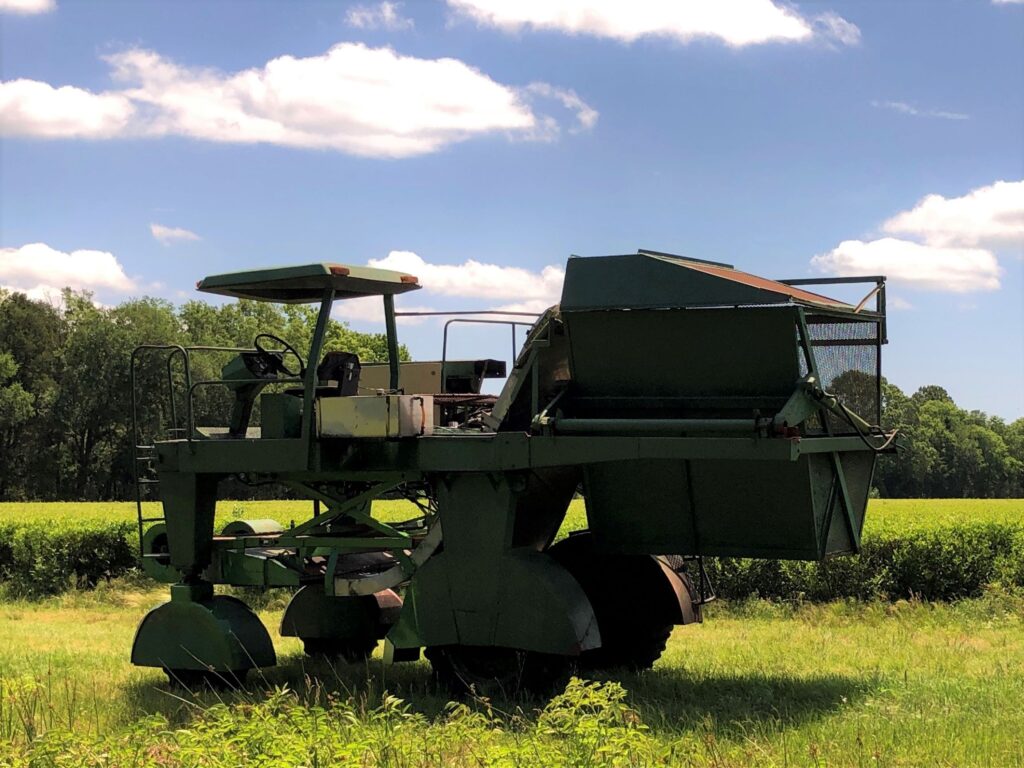
With 127 acres of tea plants, we can’t get them all in one photo!!
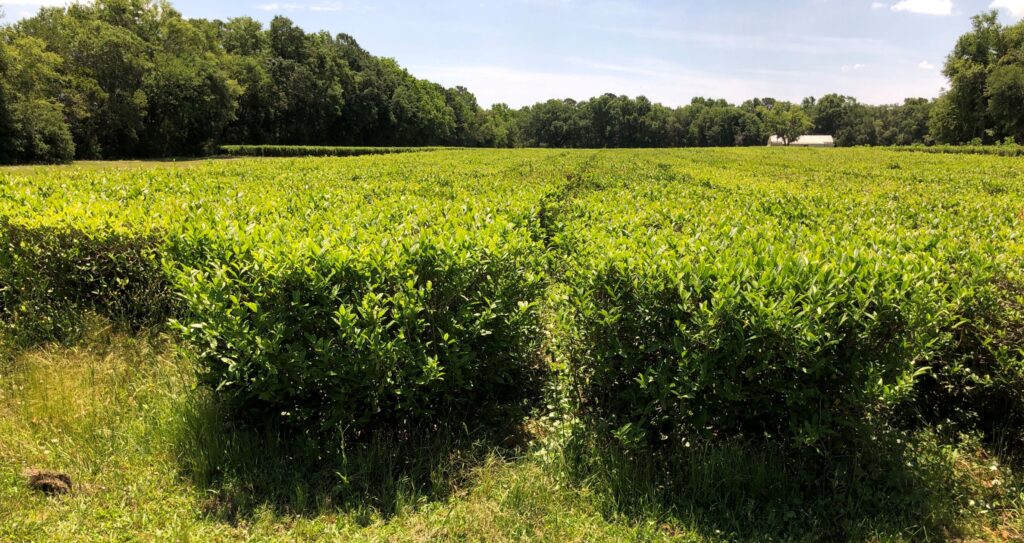
The garden grows the Camellia Sinensis plant to produce their tea.
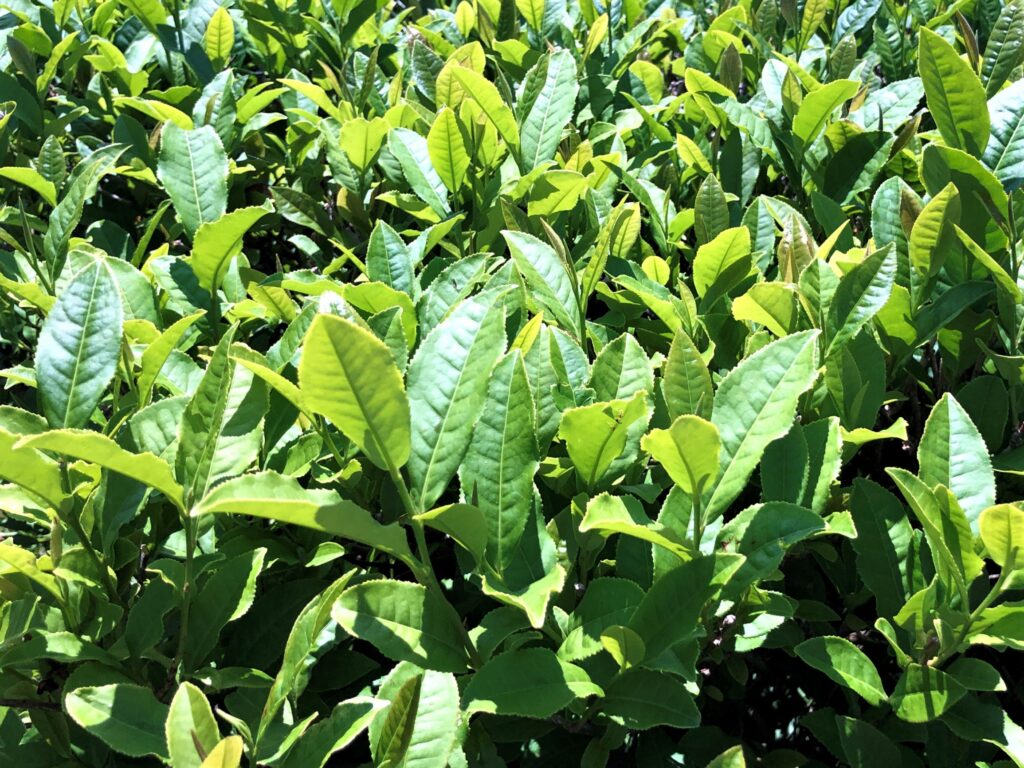
We left the Tea Garden and headed off to see the Angel Oak which was nearby.
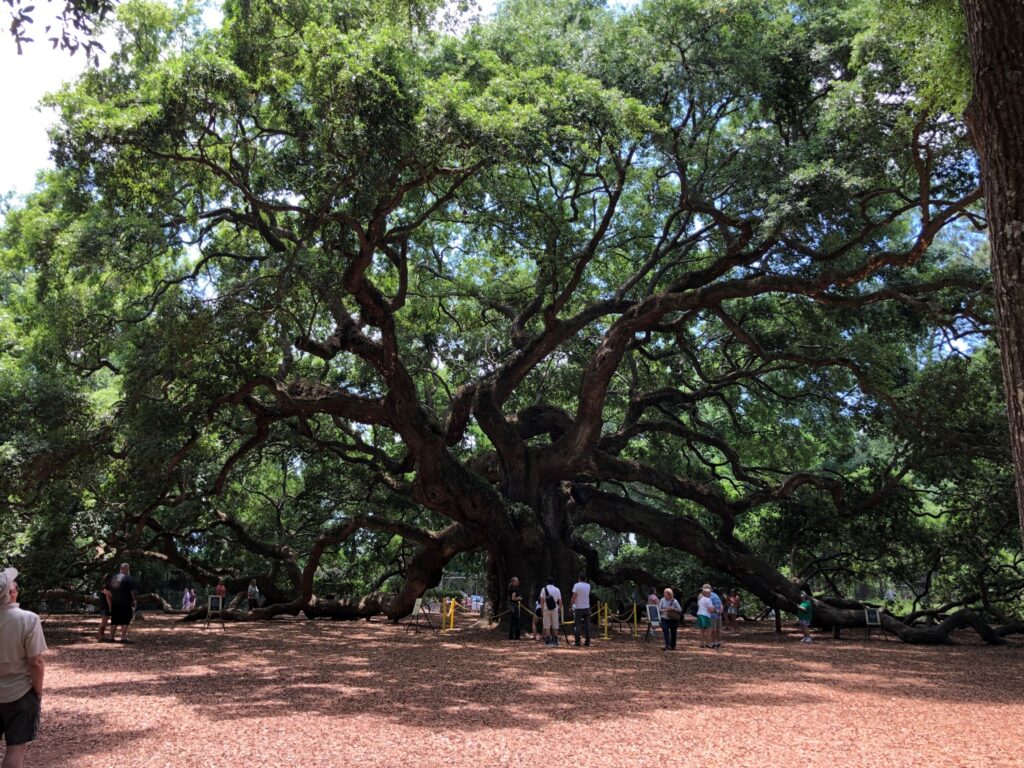
This sign told some info about the ancient Southern Live Oak tree.
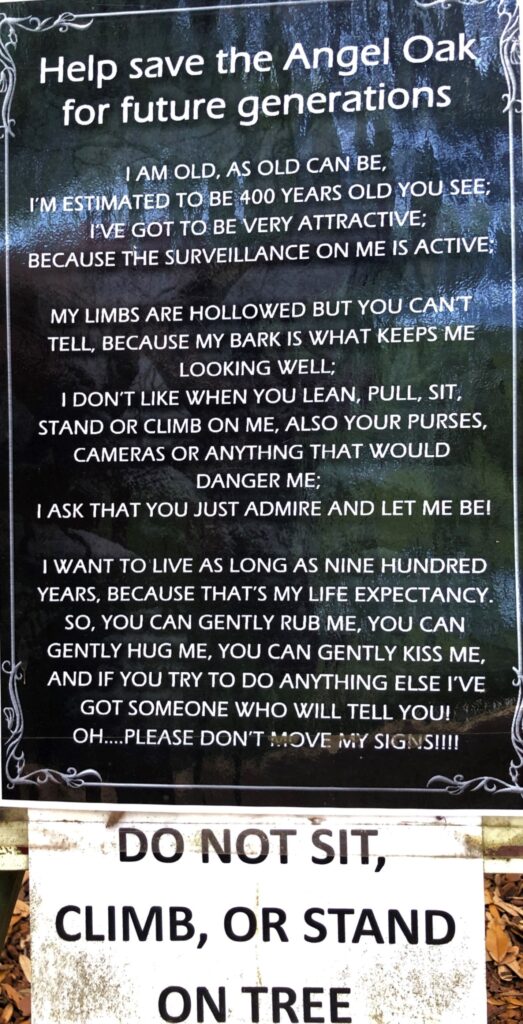
Much like the redwoods we saw out west, the trunk is HUGE!!
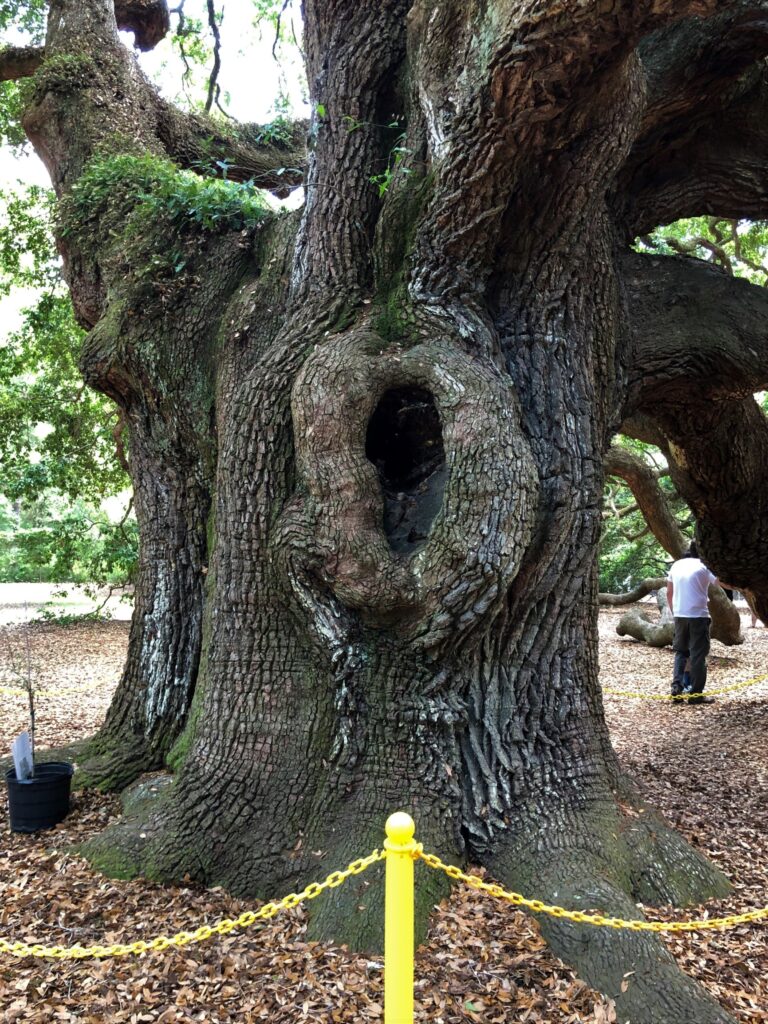
And the limbs grow upward AND along the ground!
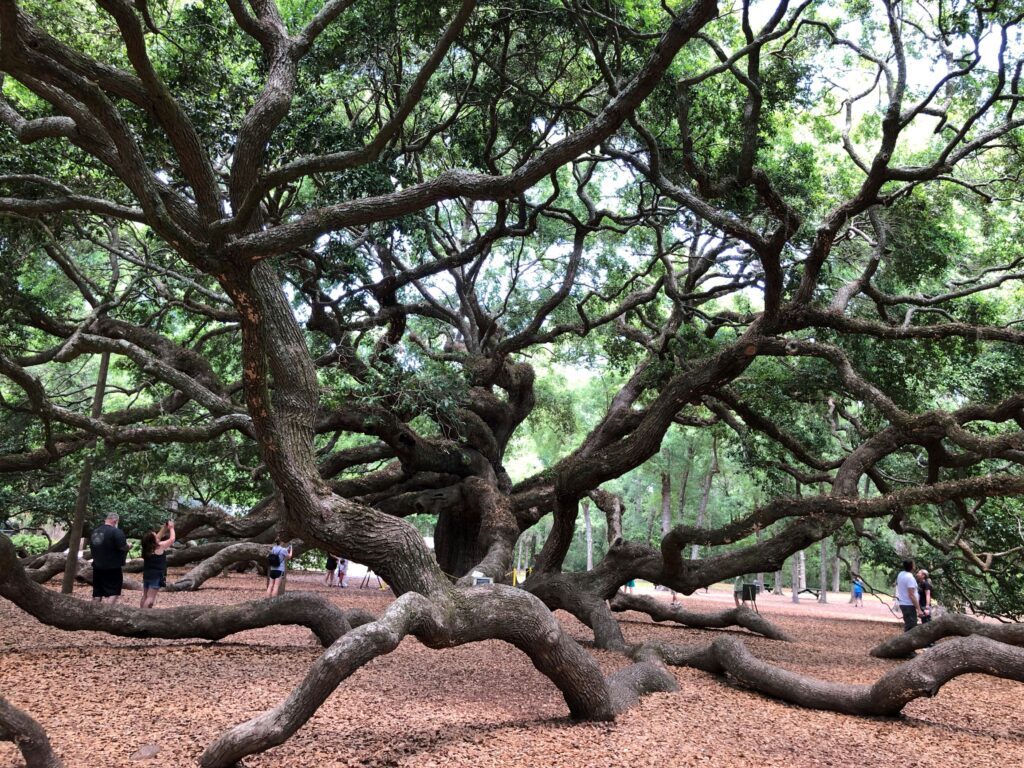
The Angel Oak Tree is estimated to be in about 400-500 years old, stands 66.5 feet tall, measures 28 feet in circumference, and produces shade that covers 17,200 square feet. From tip to tip Its longest branch distance is 187 feet.
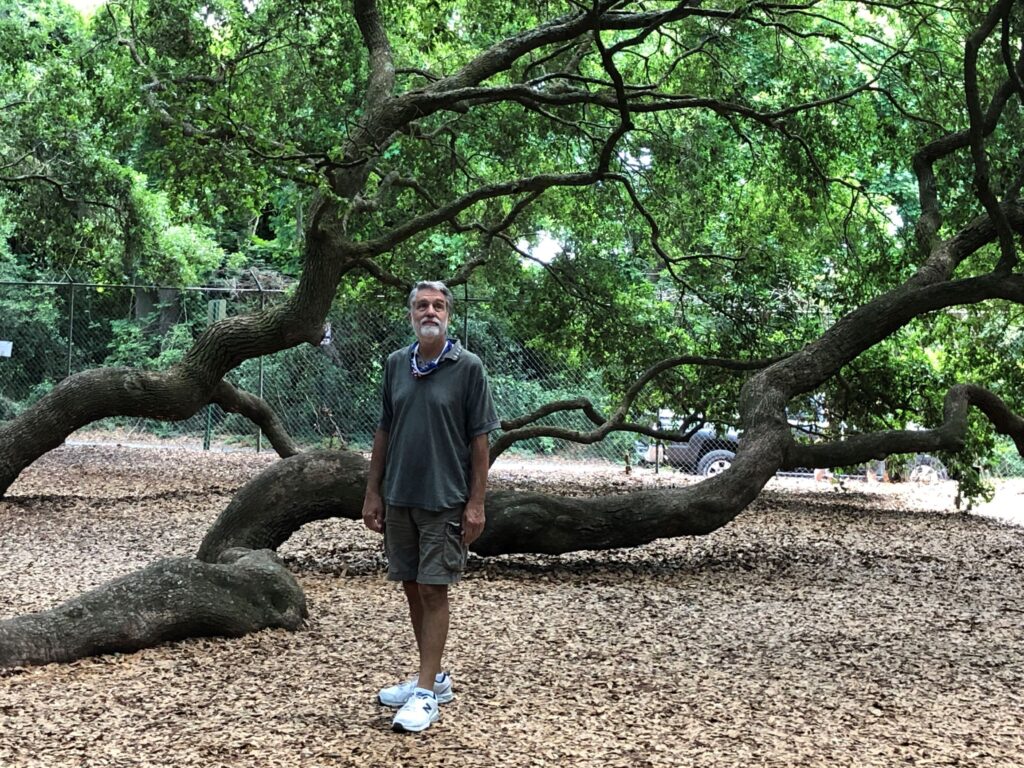
Before we headed to historic Charleston, we stopped for lunch at The Southern General. This portrait on the wall looked an awful lot like Bill Murray.
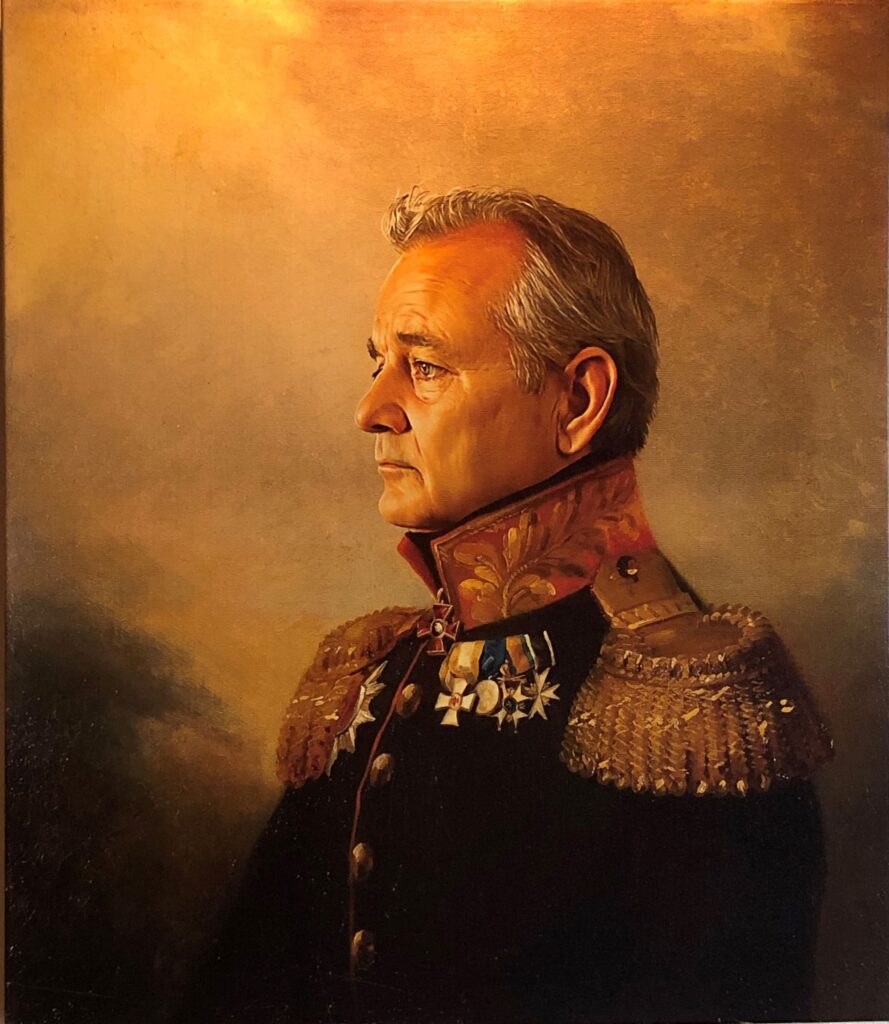
Turns out that it IS him! Apparently, Murray is part owner of several restaurants in the area and is part owner of the Charleston RiverDogs minor league baseball team.
We parked right along the waterfront – Hurricane Hugo hit here the night of September 21, 1989, with winds reaching 135 MPH and a storm surge of 15 feet swept over nearby McClellanville, the eye passing over Charleston at midnight. All was peaceful today!
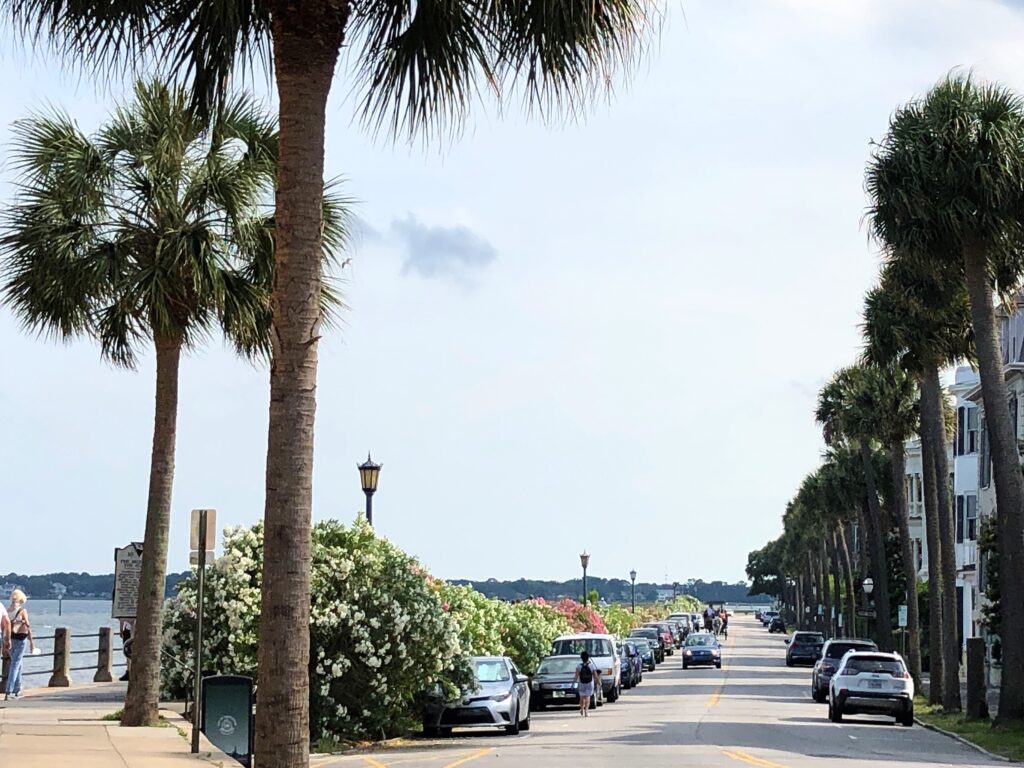
The pink, red and white oleander was in full bloom – beautiful!
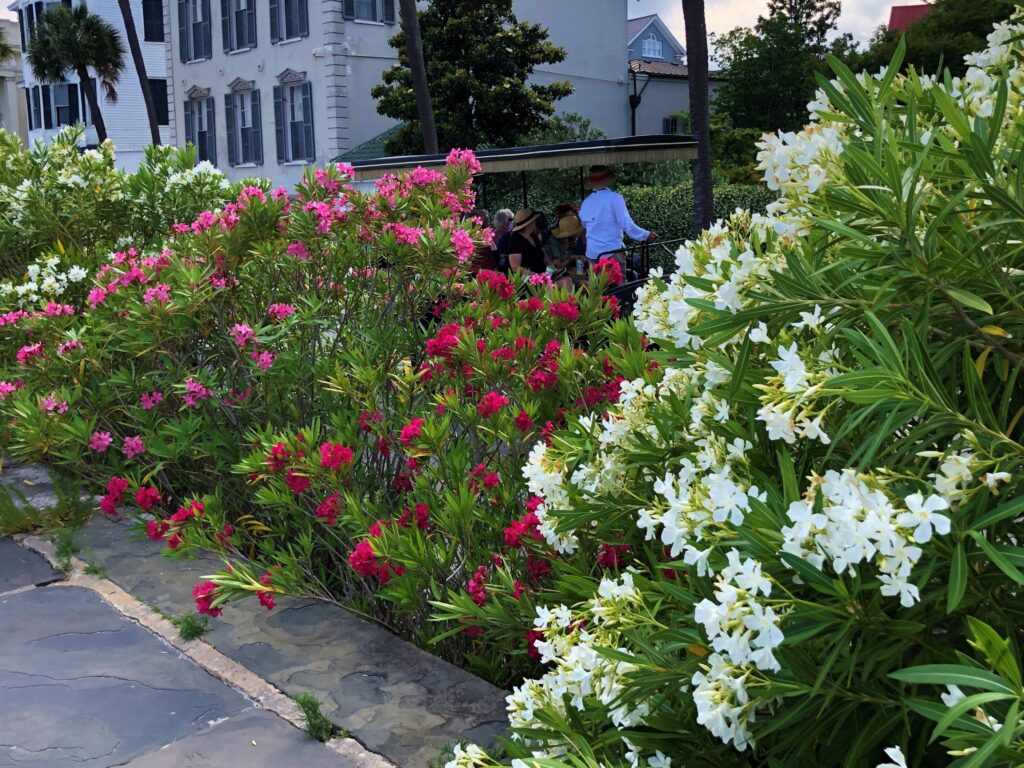
Beautiful buildings across from the waterfront.
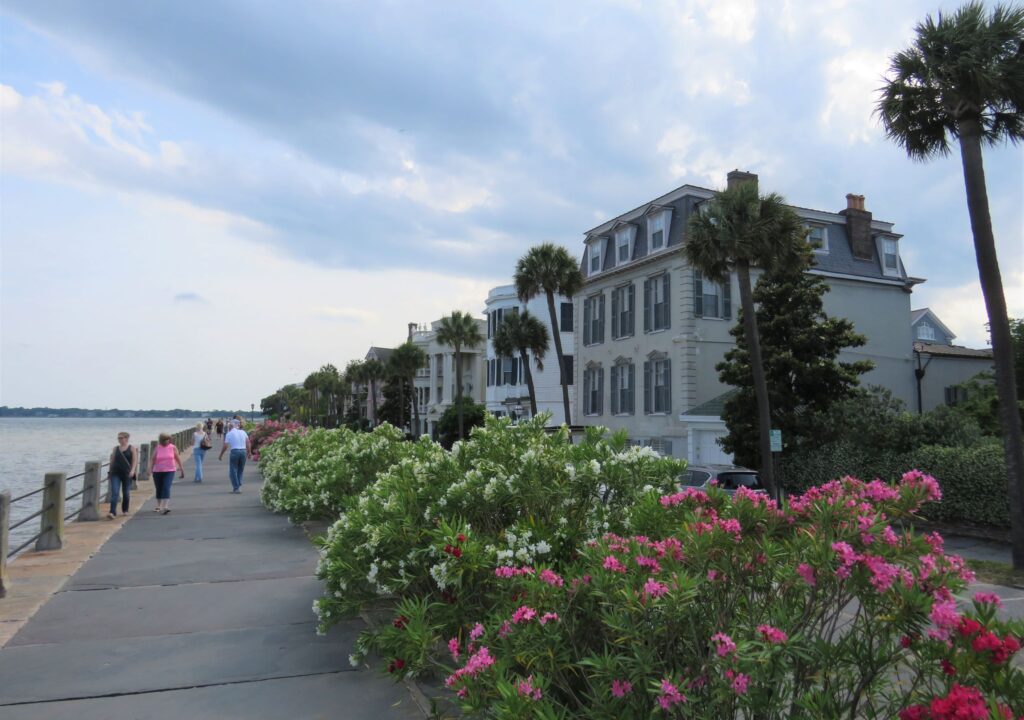
The cobblestone streets were pretty cool!
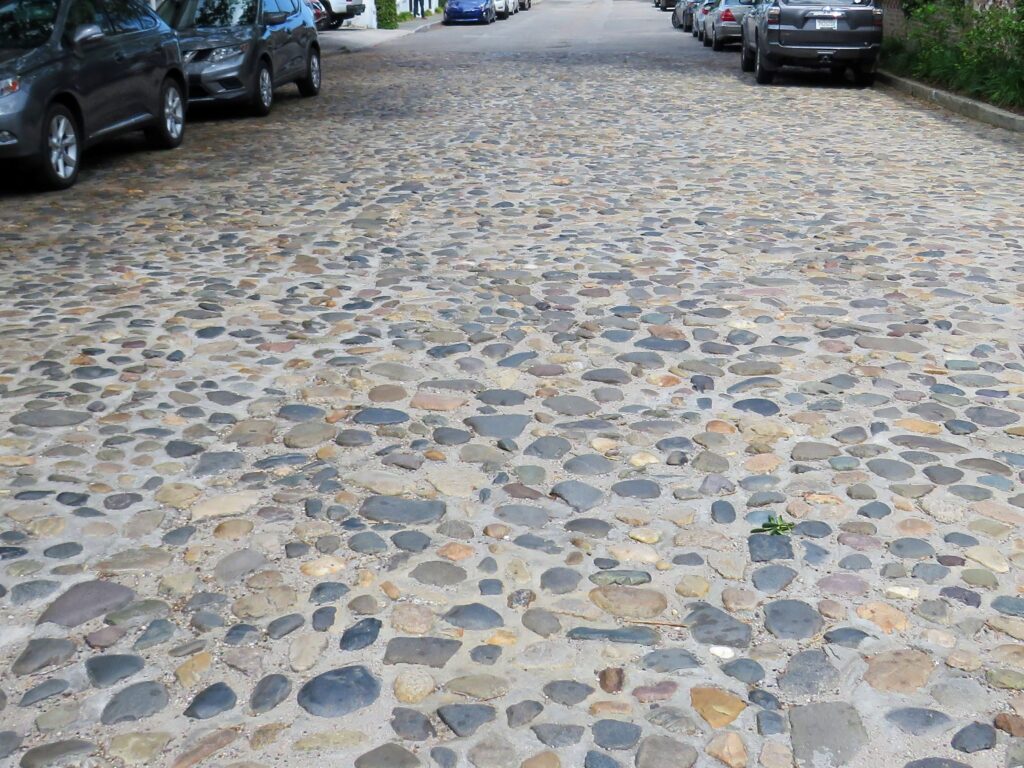
The sidewalks were made of large slabs of slate! Very interesting!
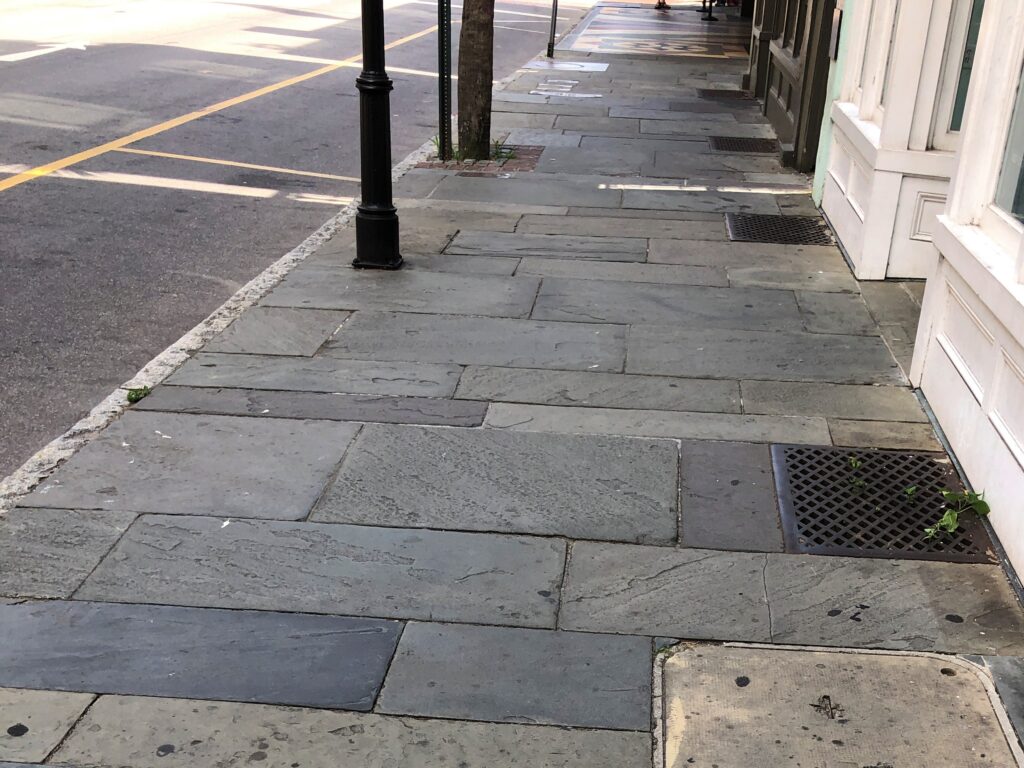
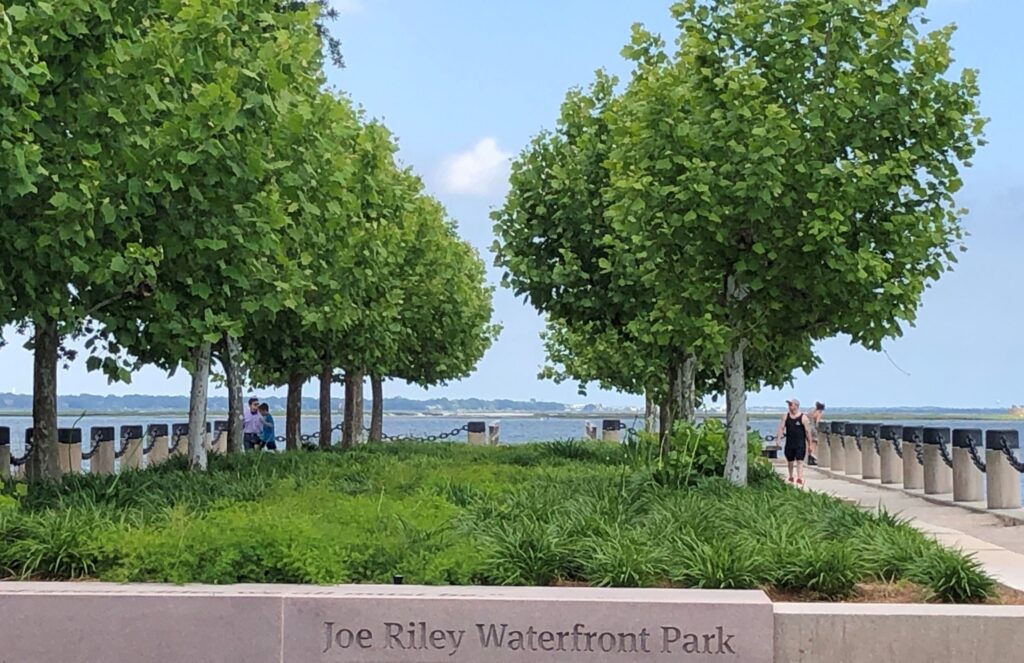
The Pineapple Fountain in the Waterfront Park was opened in 1990.
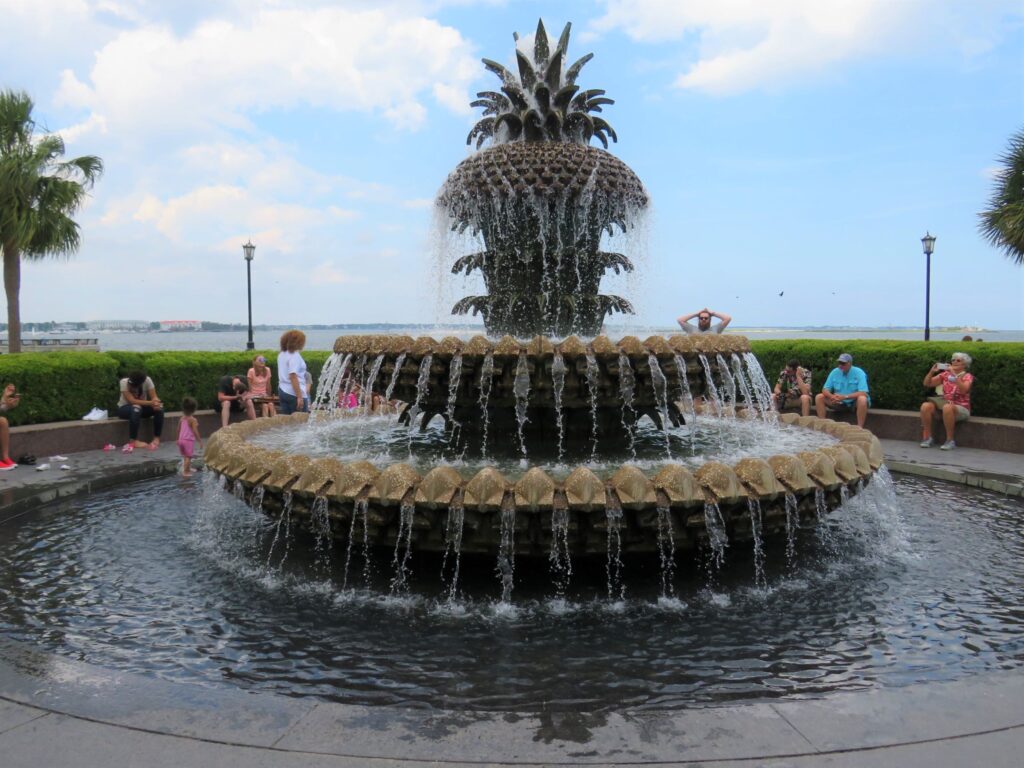
Across the bay, we could see the USS Yorktown – at Patriots Point – we’ll go see it another day.
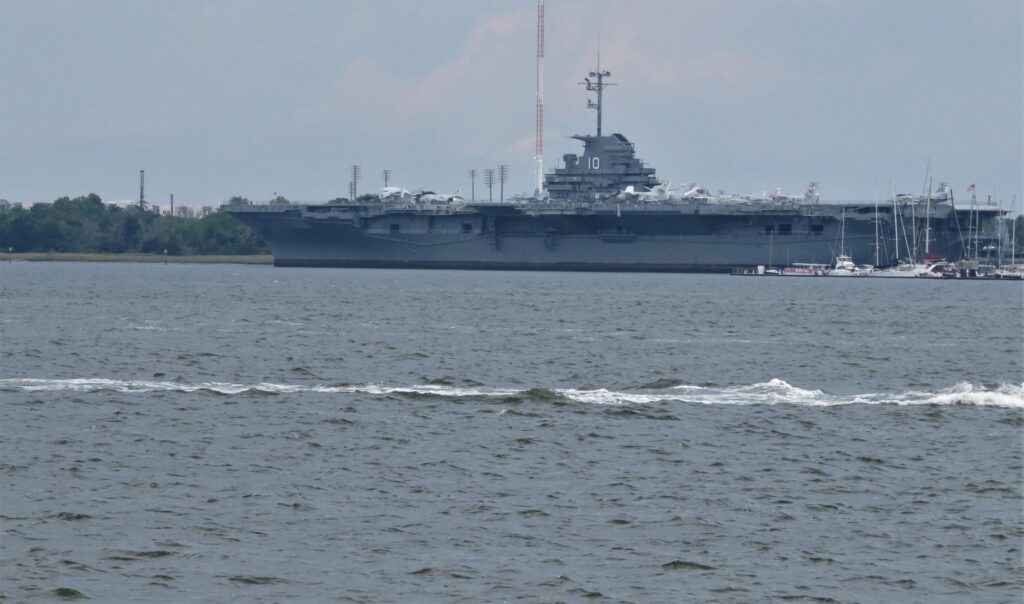
We walked over to see the Kahal Kadosh Beth Elohim Synagogue, but the gates were locked – from what we could see, it looked like an impressive building! From their website, “Founded in 1749, Kahal Kadosh Beth Elohim (KKBE) is one of the oldest congregations in America, and is known as the birthplace of American Reform Judaism. Our sanctuary is the oldest in continuous use for Jewish worship in America, but KKBE is more than just a house of worship. We are a vibrant, inclusive and caring congregational family.” …”while the present synagogue was being built in 1840, an organ was installed.”
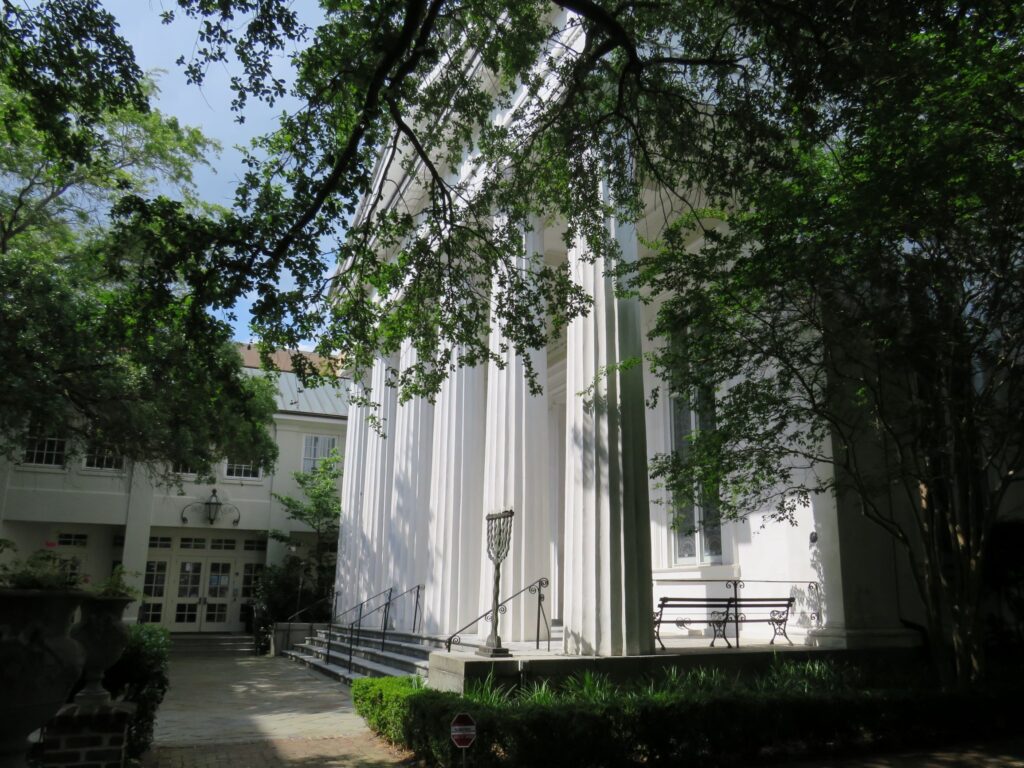
Just across from the synagogue was the Saint Mary of the Annunciation Roman Catholic Church, the oldest Catholic parish in the southeastern United States, founded in 1788. In April of 1838, Charleston endured the Great Fire, a conflagration that claimed nearly two-thirds of the city. St. Mary and its neighbor, Kahal Kadosh Beth Elohim Synagogue, were both totally destroyed. St. Mary’s was reopened for Divine Worship on June 9, 1839.
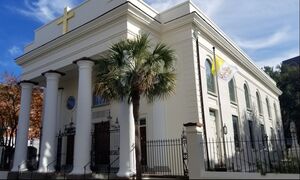
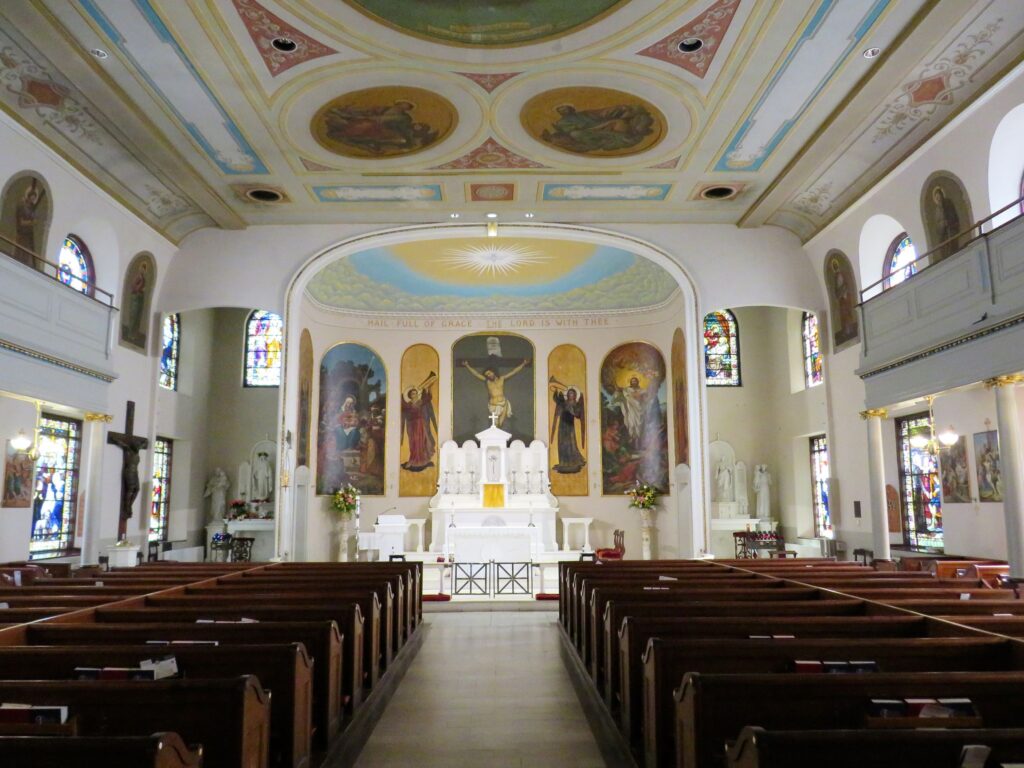
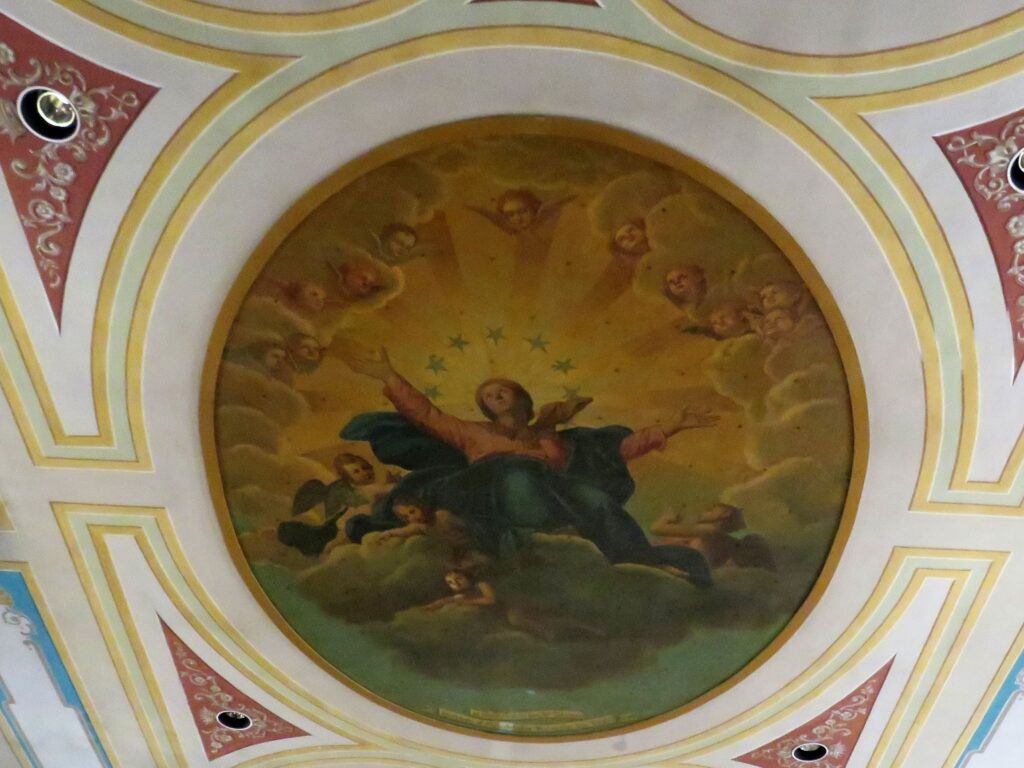
Colorful angel windows on the doors as we exited.
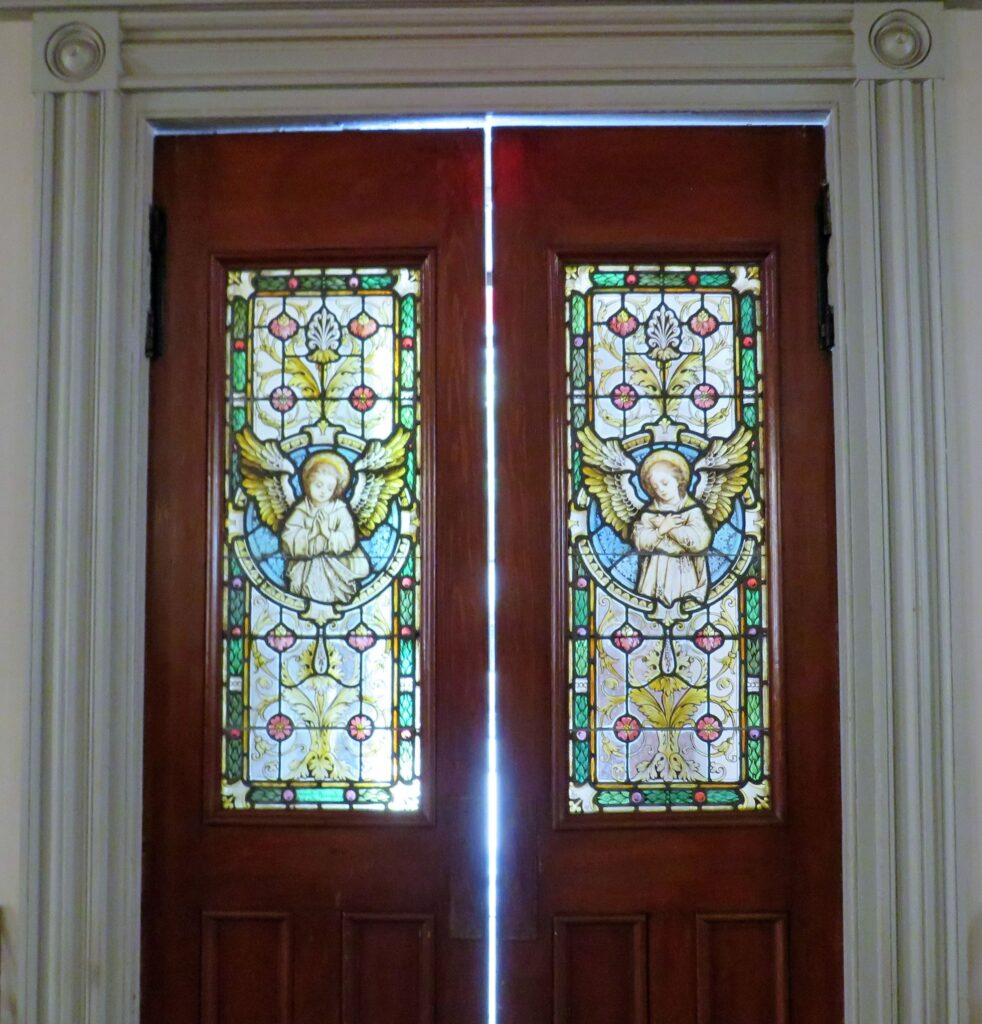
Though we didn’t stop in to eat, we thought this was a great name for a seafood place! Do you suppose they have oysters?!
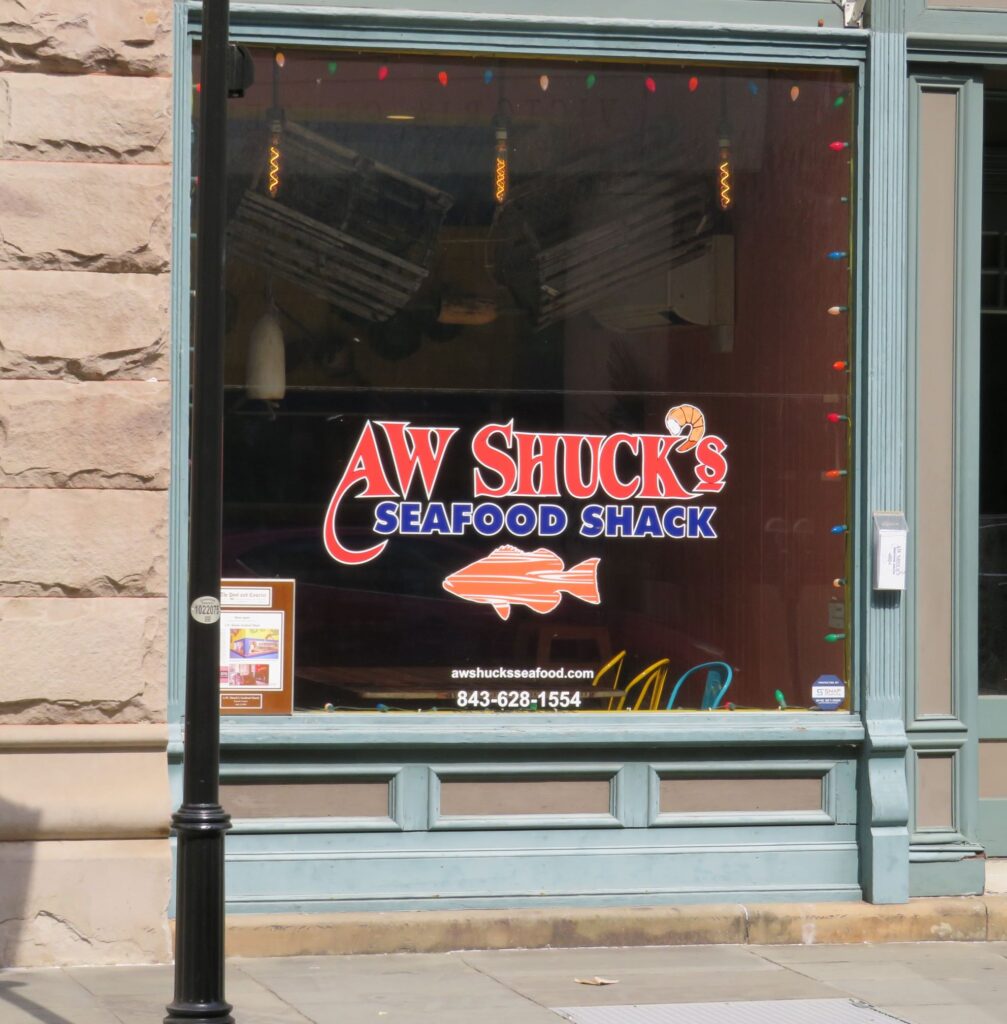
This was the home of Dr. John Lining.
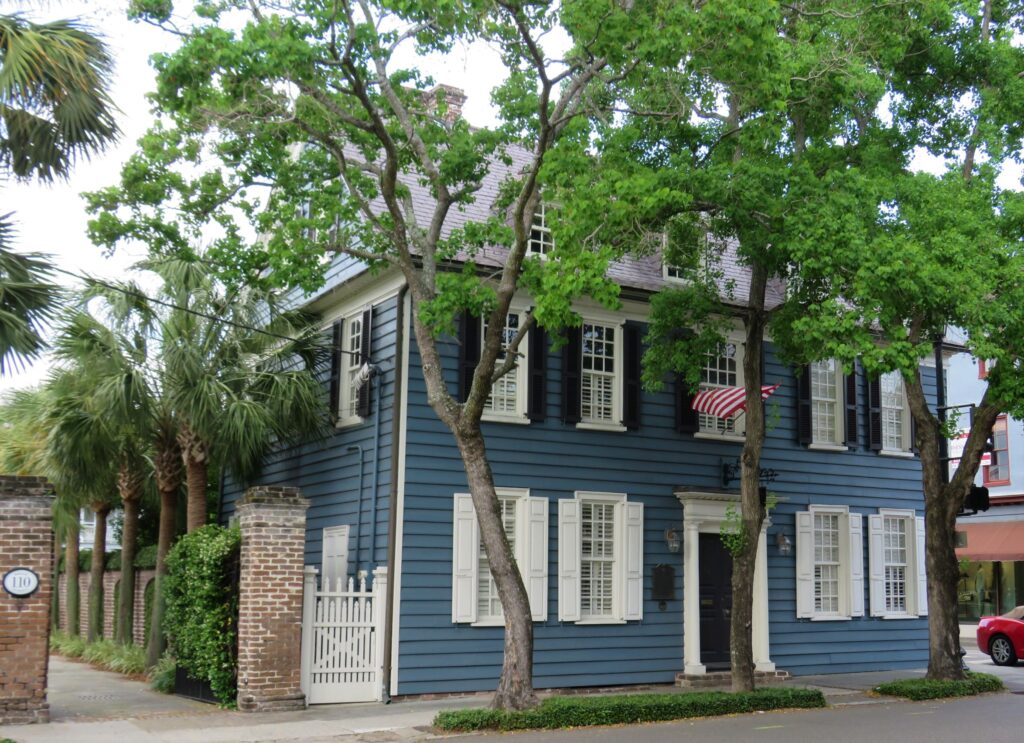
Next to the front door is this plaque.
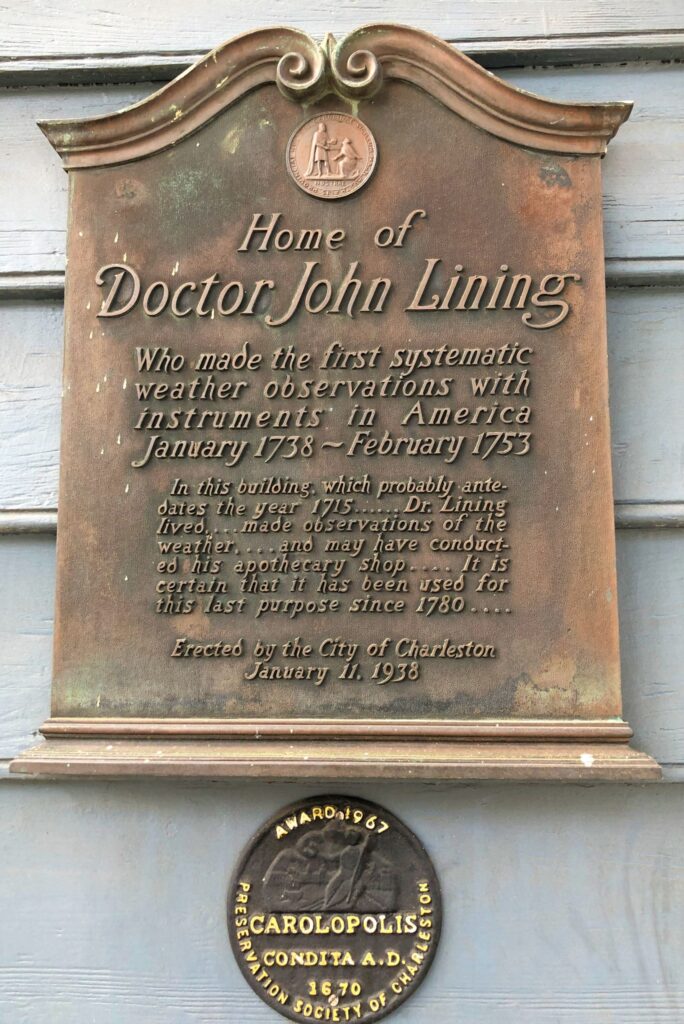
Our next stop was the Cathedral of Saint John the Baptist. The cornerstone for the present cathedral was laid in January of 1890, built on the foundation of the 1854 cathedral that was destroyed by fire in December of 1861. The structure is of Connecticut tool-chiseled brownstone.
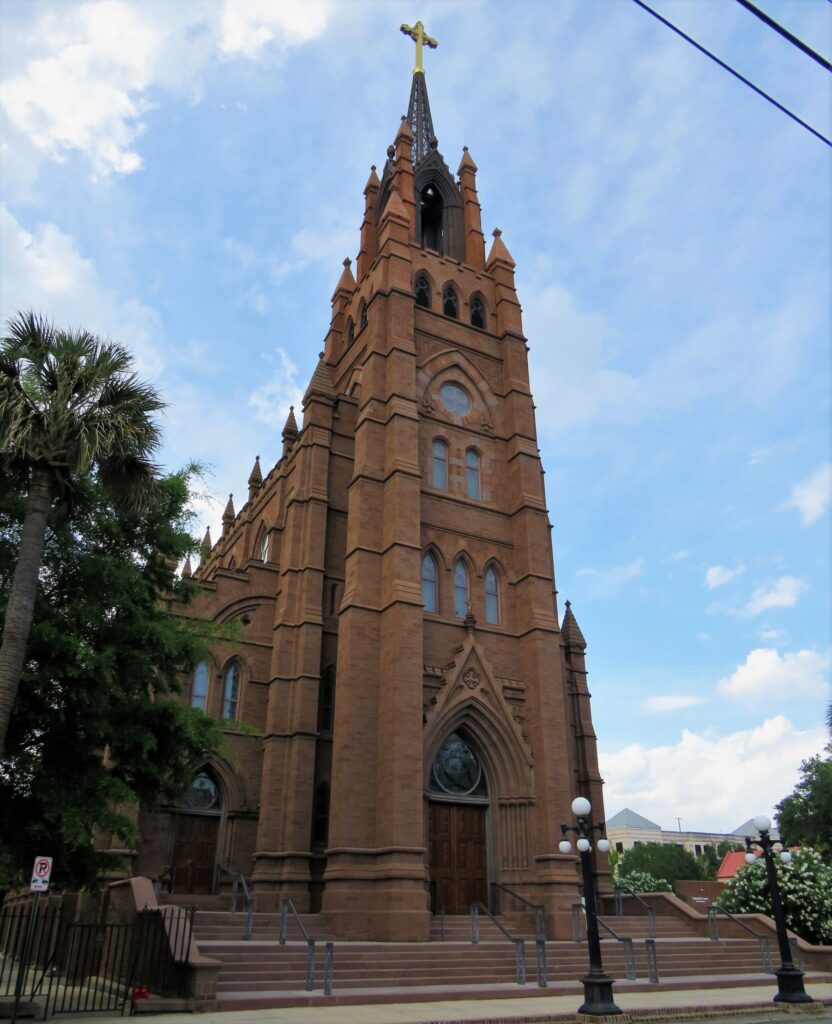
Above the high altar is a five-light window copied from Leonardo DaVinci’s “Last Supper.” The rose window above it is the Baptism of Jesus by St. John the Baptist.
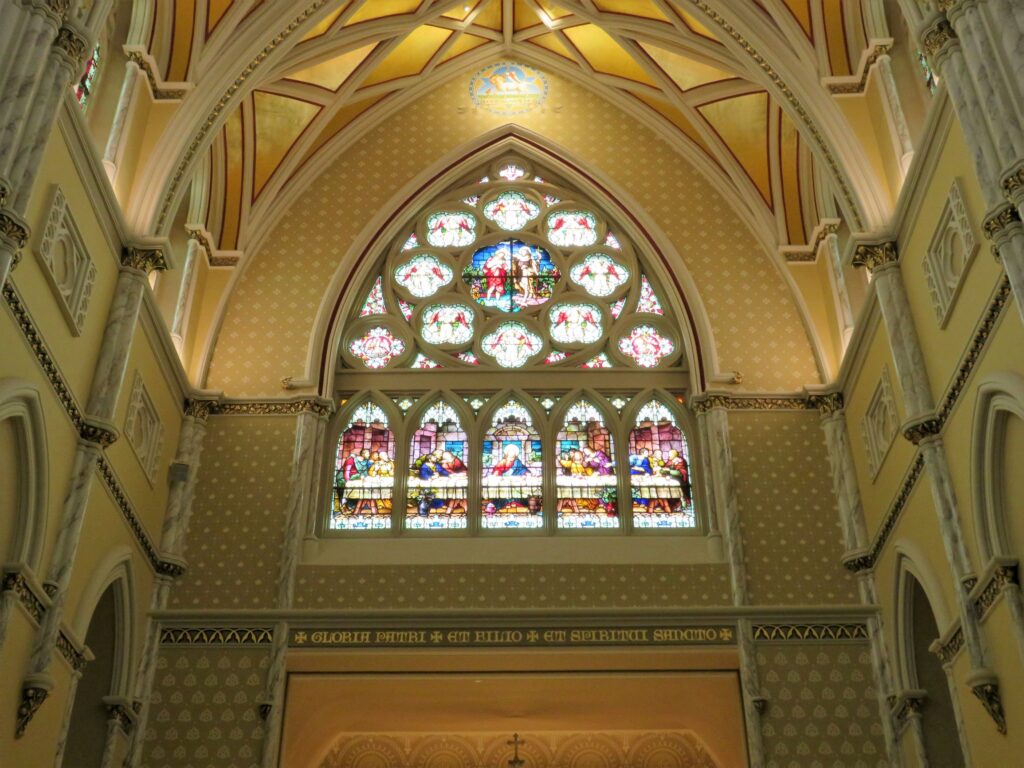
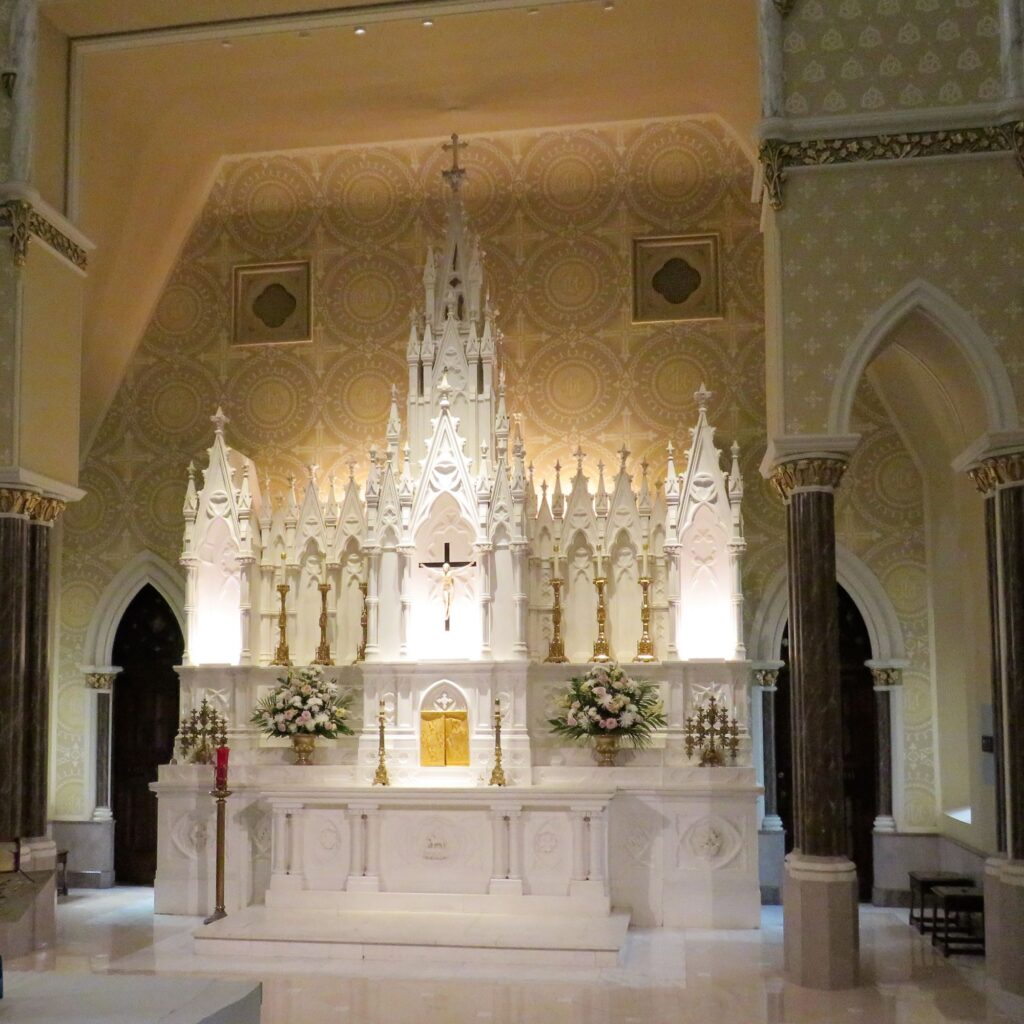
We were told the ceiling was just recently painted – stars on a dark blue background.
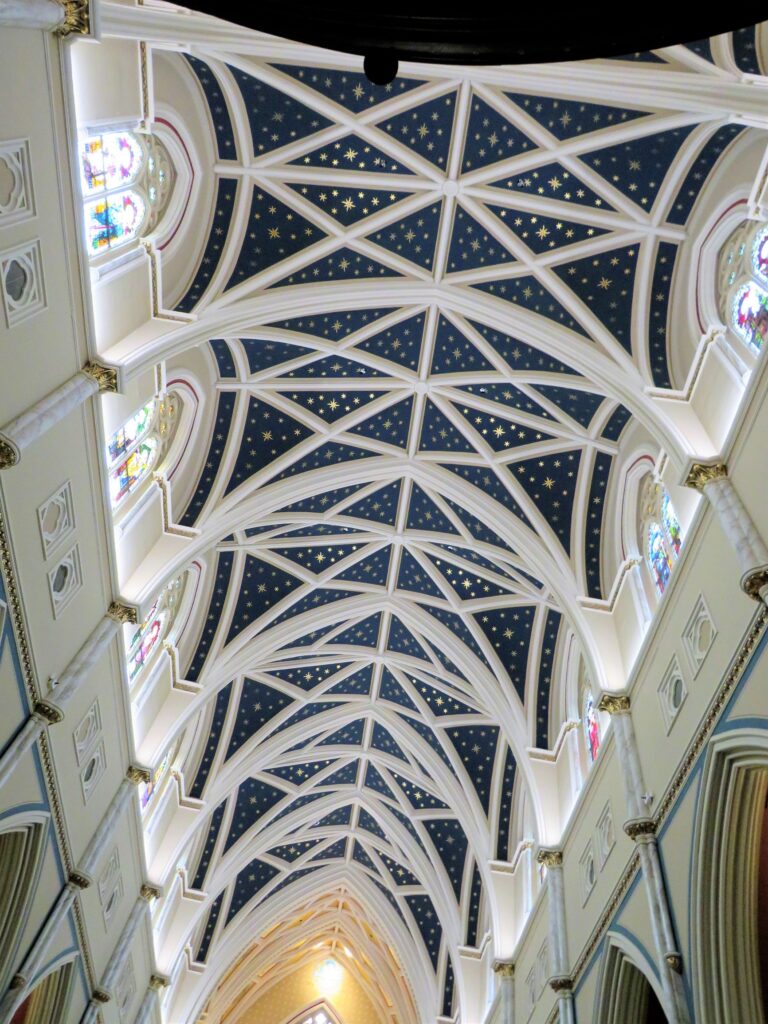
The organ at the back of the sanctuary is a 31-rank French Romantic pipe organ, Bedient Opus22, and was purchased from the Episcopal Christ Church Cathedral in Louisville, KY in 1995.
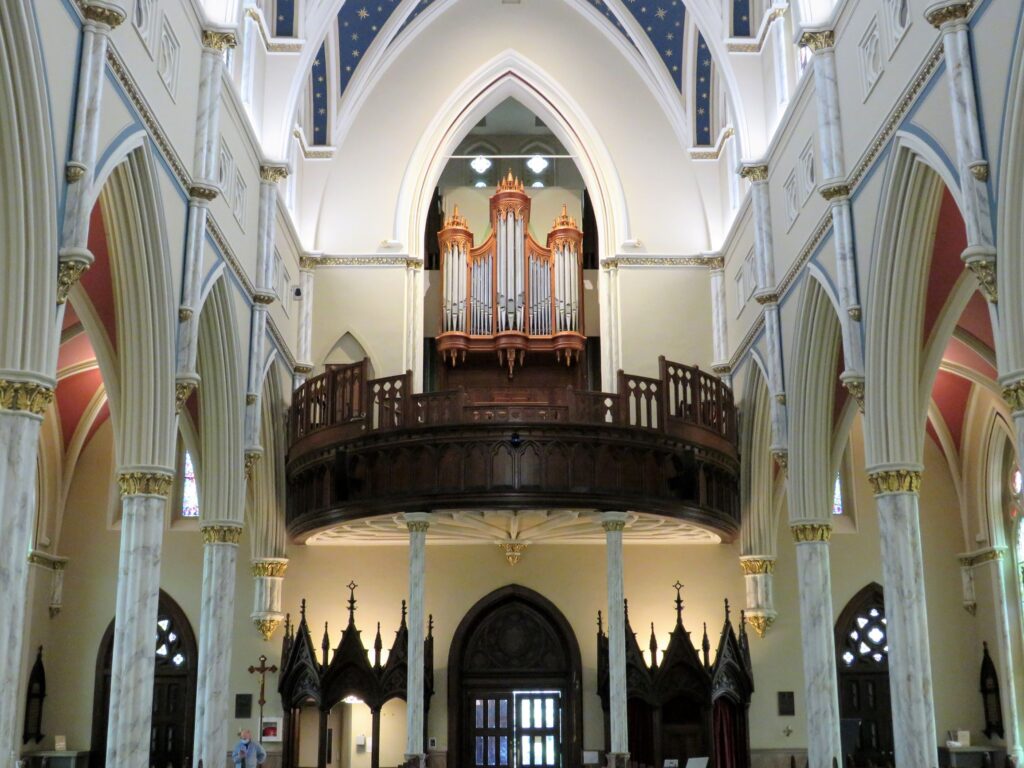
Ted’s birthday is on Saturday – we mailed his card from the historic Post Office in Charleston!
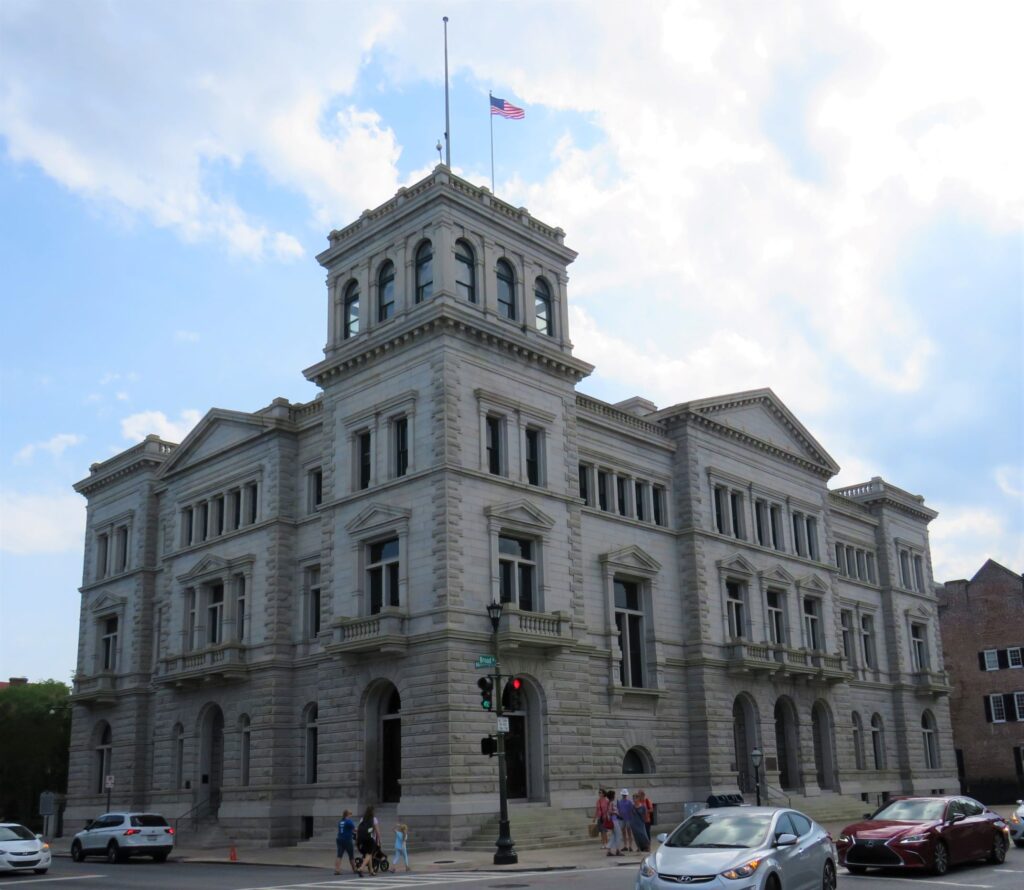
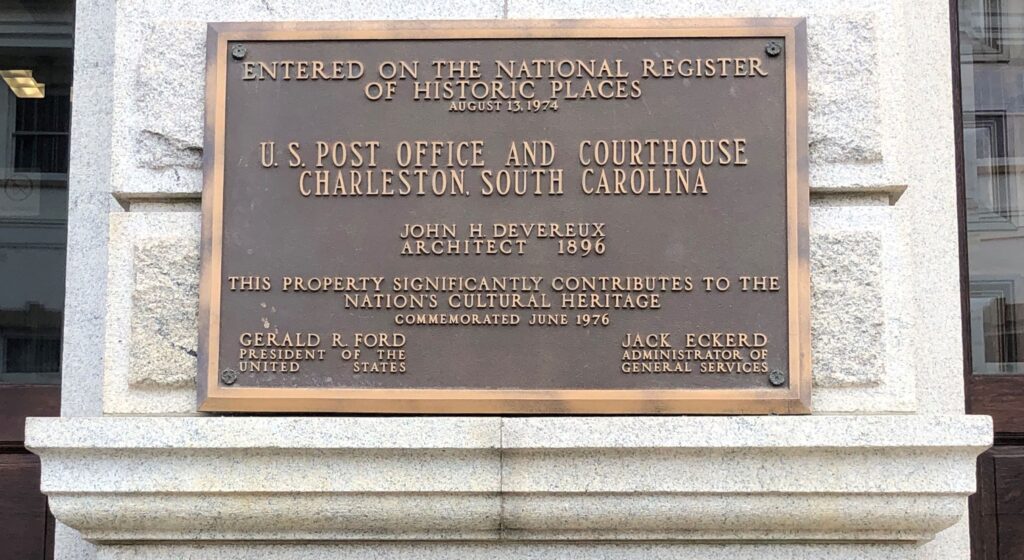
St. Michael’s Episcopal Church was the next building down the street. You can read about the history of the church here.
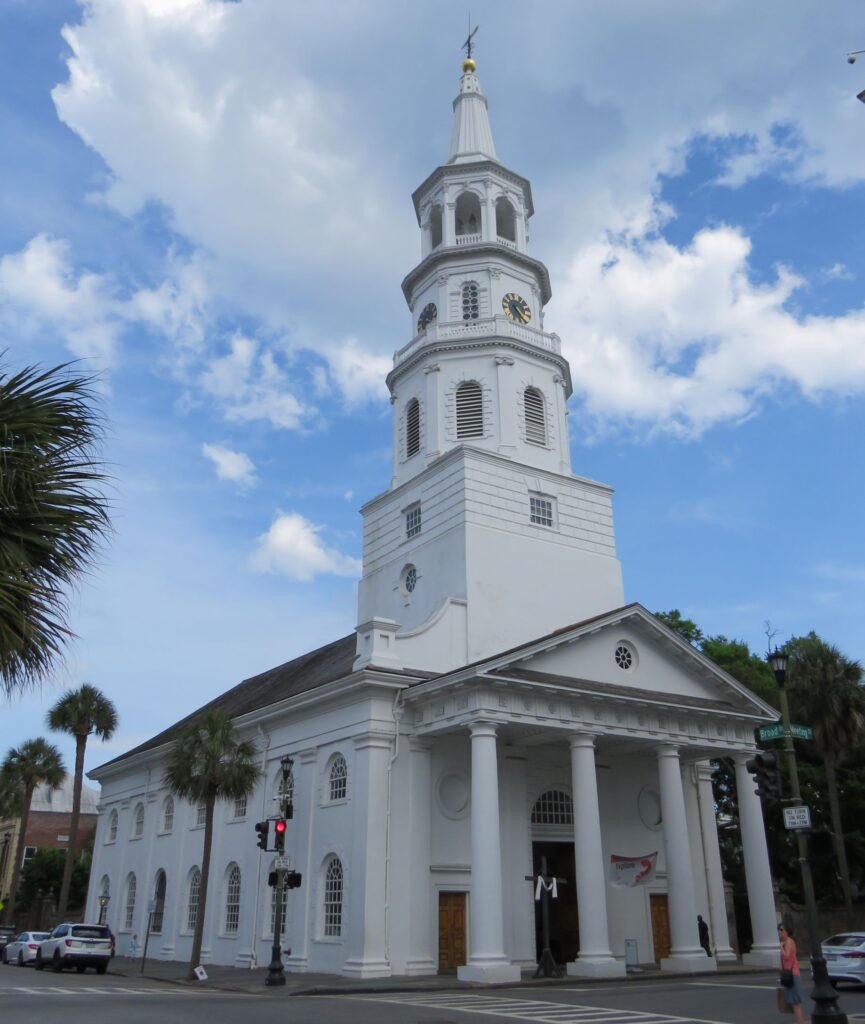
Beautiful stained glass!
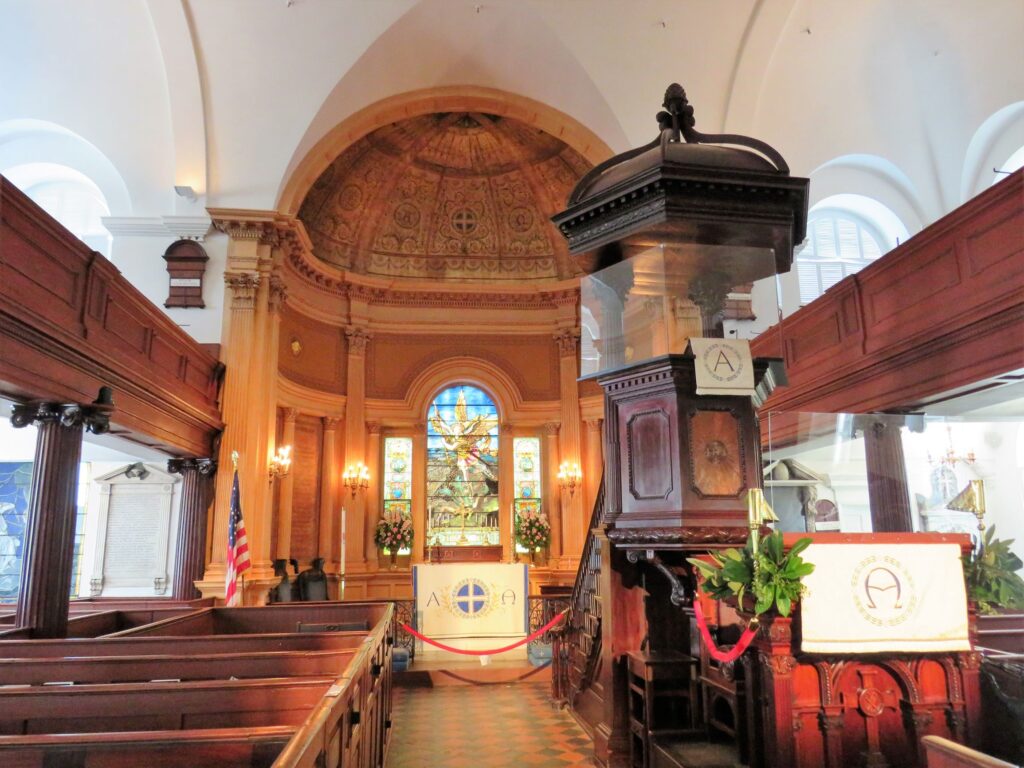
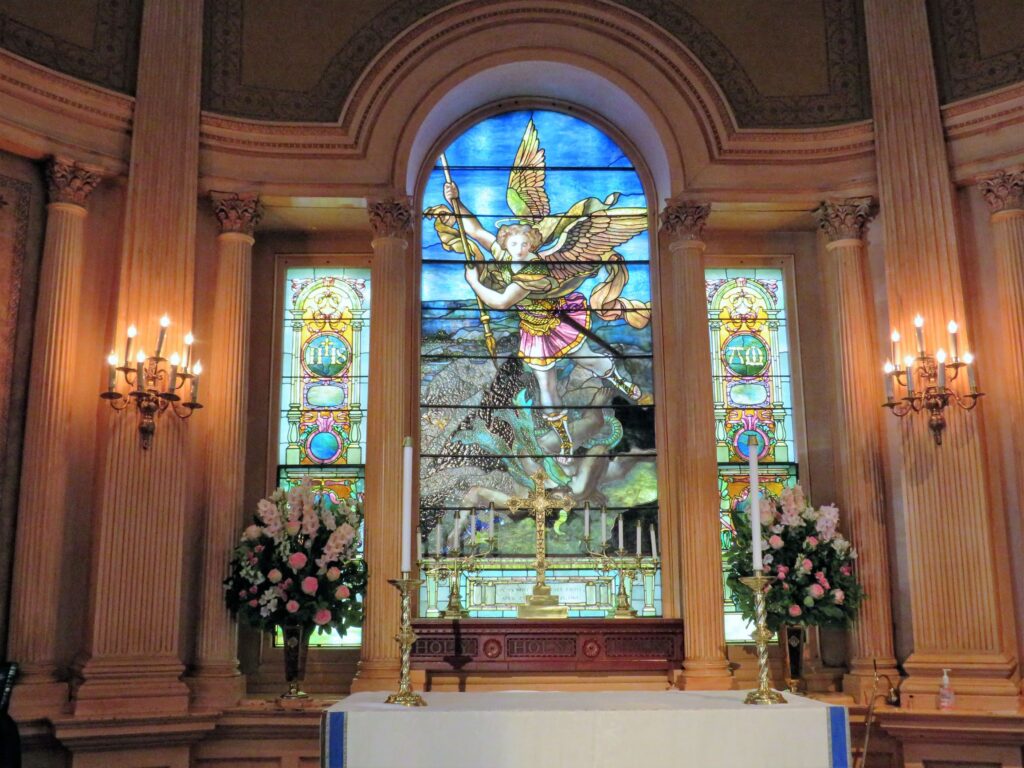
…and more at the exit!
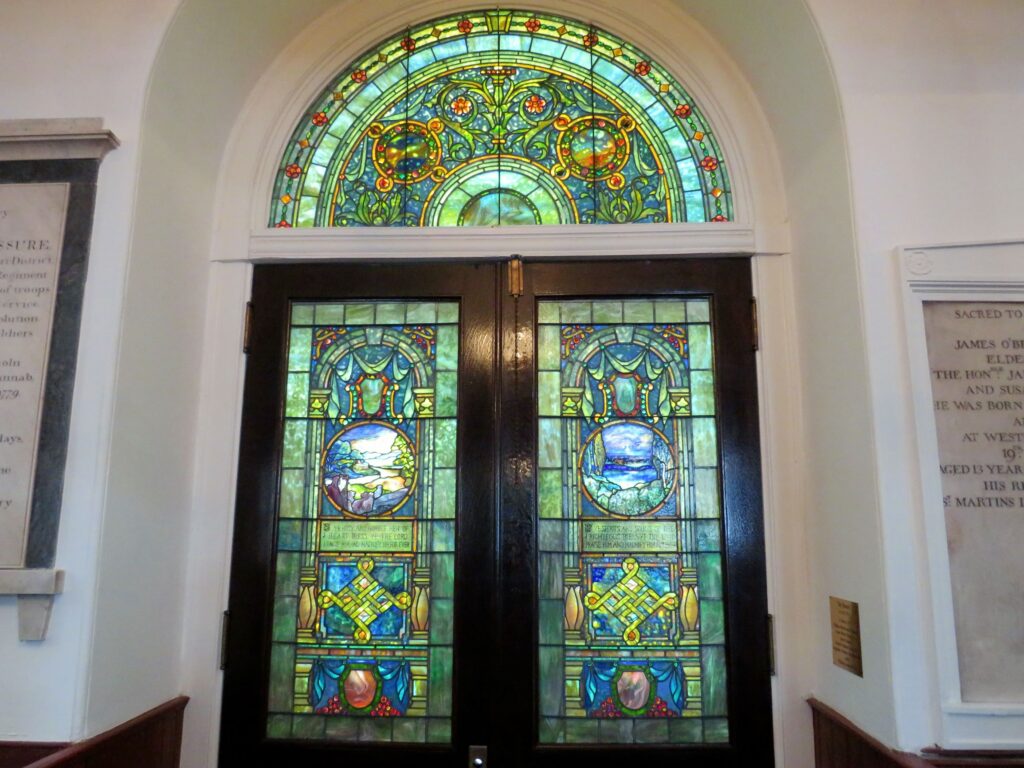
Hmmmm… Wonder why this is called “Rainbow Row“?!

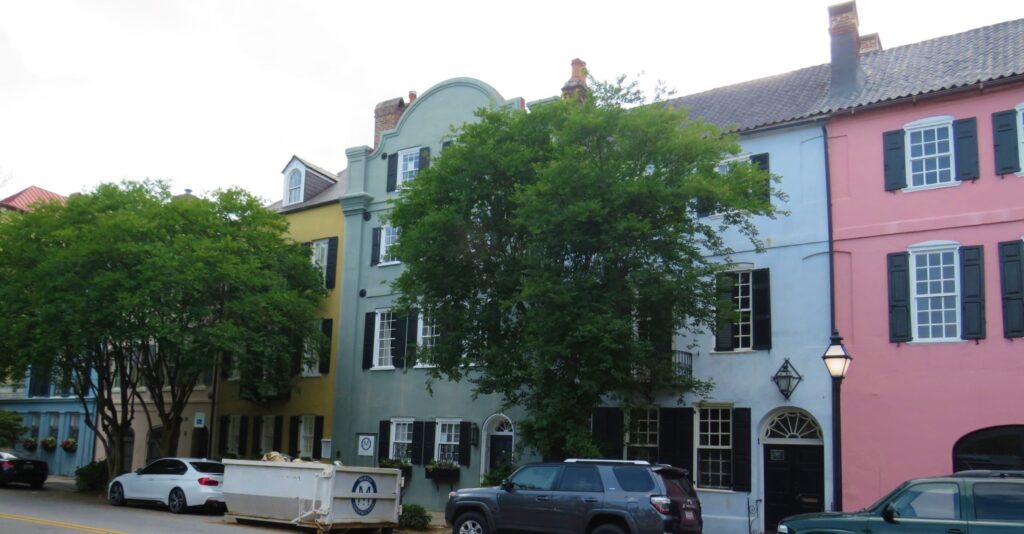
We had our last stop back near the waterfront at White Point Garden – a large green space shaded by beautiful old oak trees. There was a display of several Civil War cannons , and many revolutionary monuments and statues.
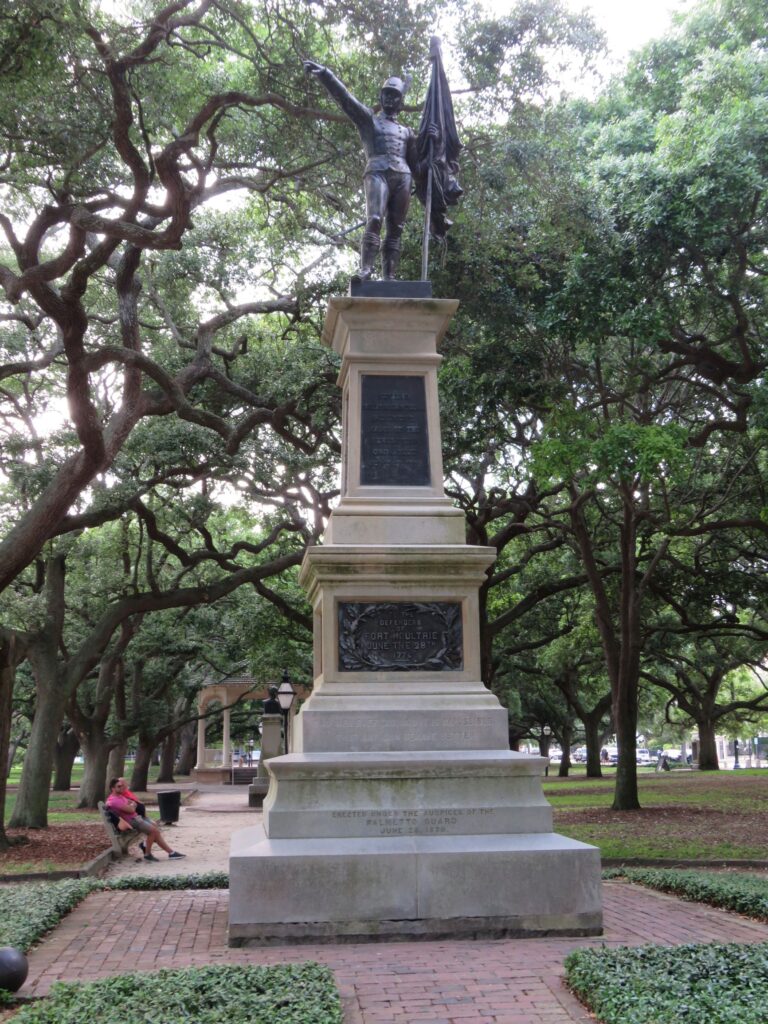
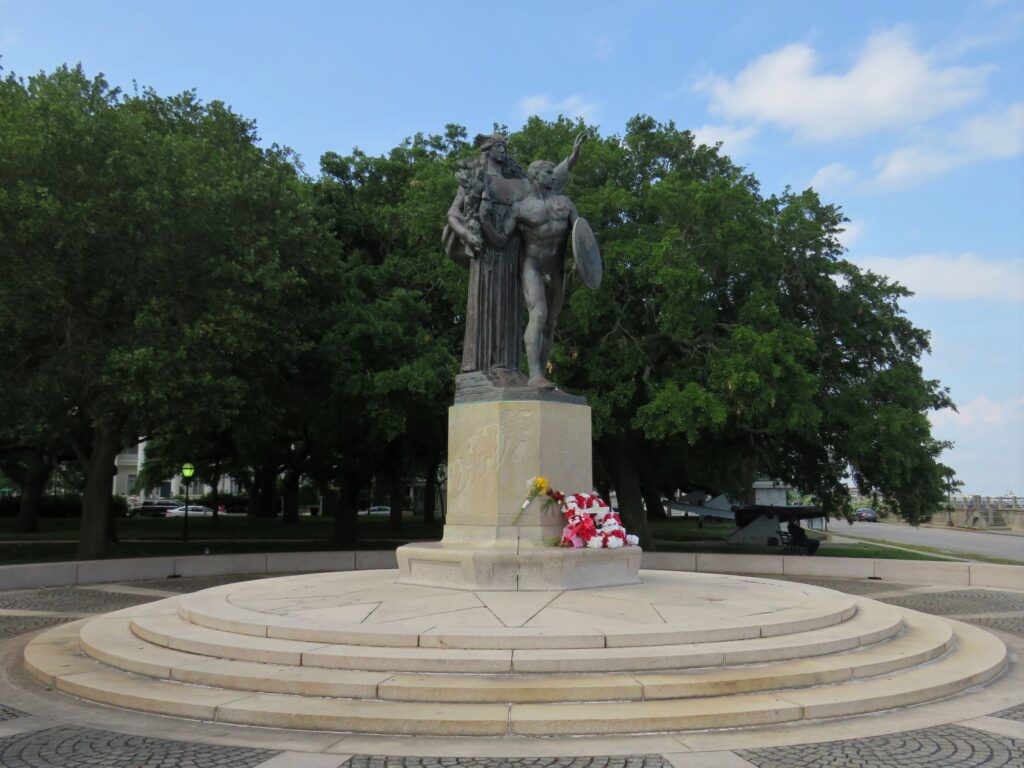
William Moultrie was a general in the American Revolutionary War.
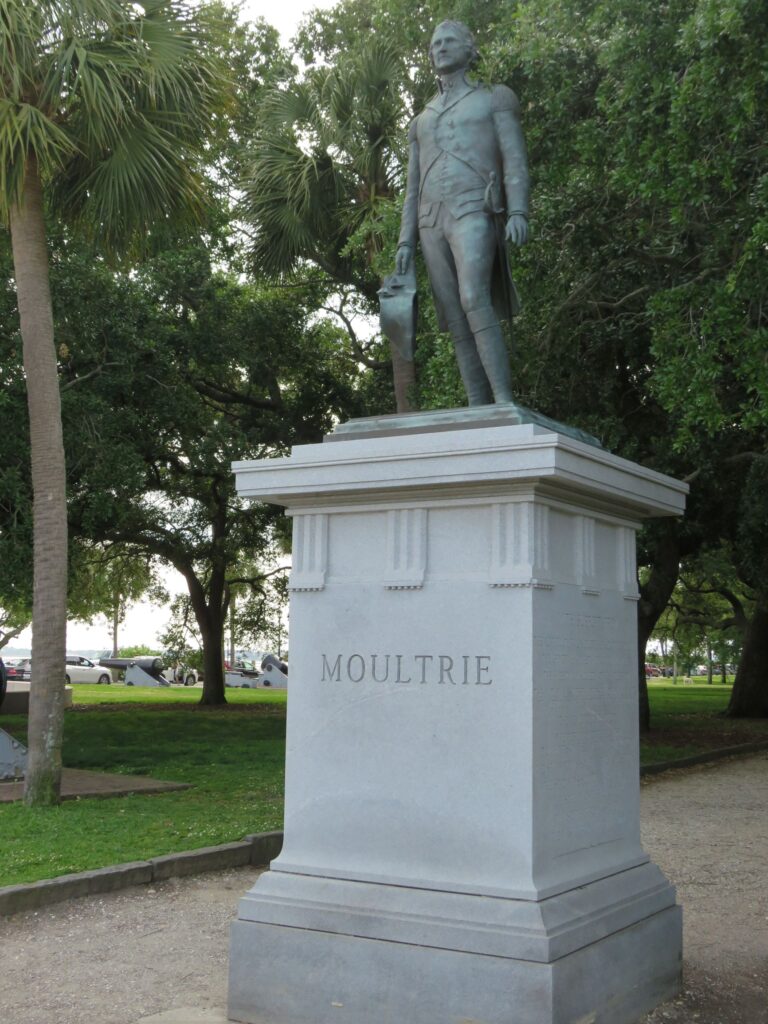
Ten-Inch smooth bore Columbiad Cannon – This cannon has been identified as one of Fort Sumter’s “three gun battery” of October, 1863.
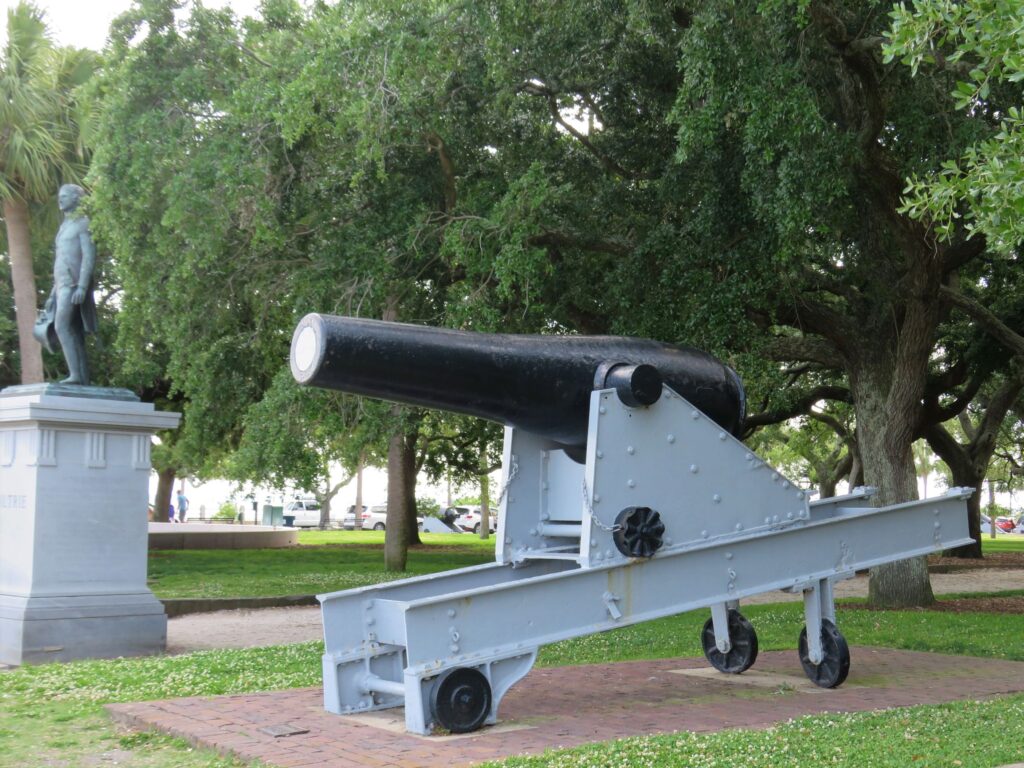
There were 4 of these Thirteen-inch Mortars at the park – they were first used by the Federal troops for the bombardment of Fort Sumter in October, 1863. These 4 may well form the world’s largest collection of this type weapon!
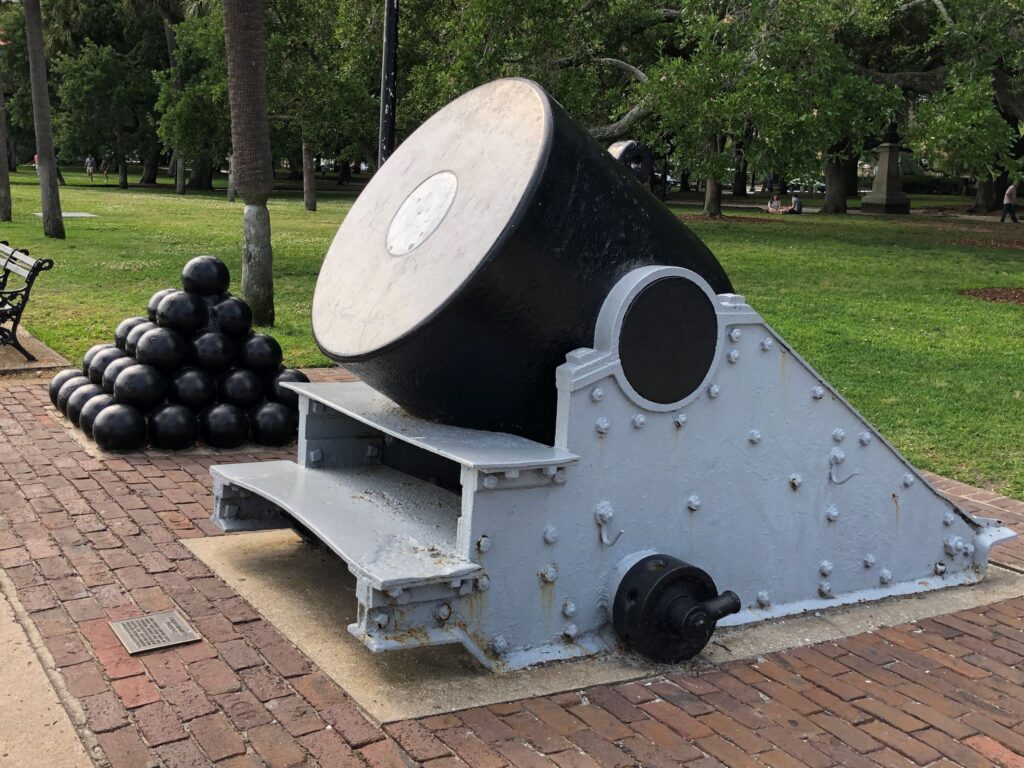
Thursday we went to ride our bikes at the Pickney Island National Wildlife Refuge; AllTrails indicated there was a paved trail, but it was dirt and gravel and grass – and lots of folks were walking the trails. We saw this blue heron in one of the ponds.
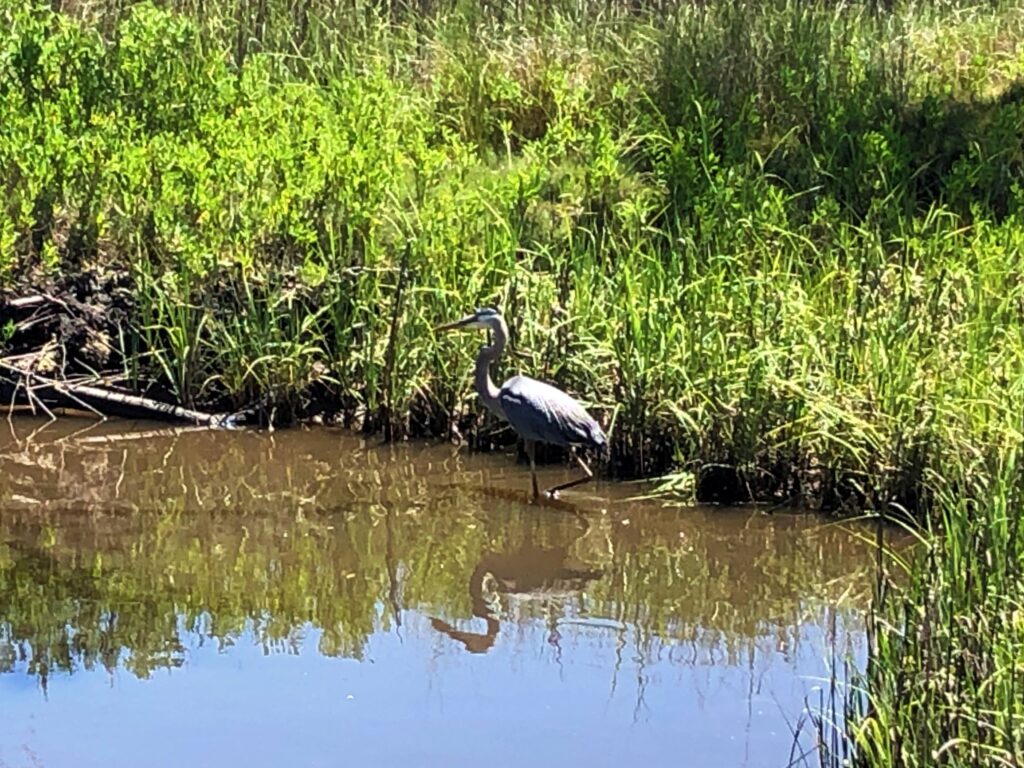
We decided this area was not really suited for our kind of biking. After about 2 miles, we turned around; we rode 4 1/2 miles there, and drove on to Hilton Head Island where there are many miles of paved bike paths!
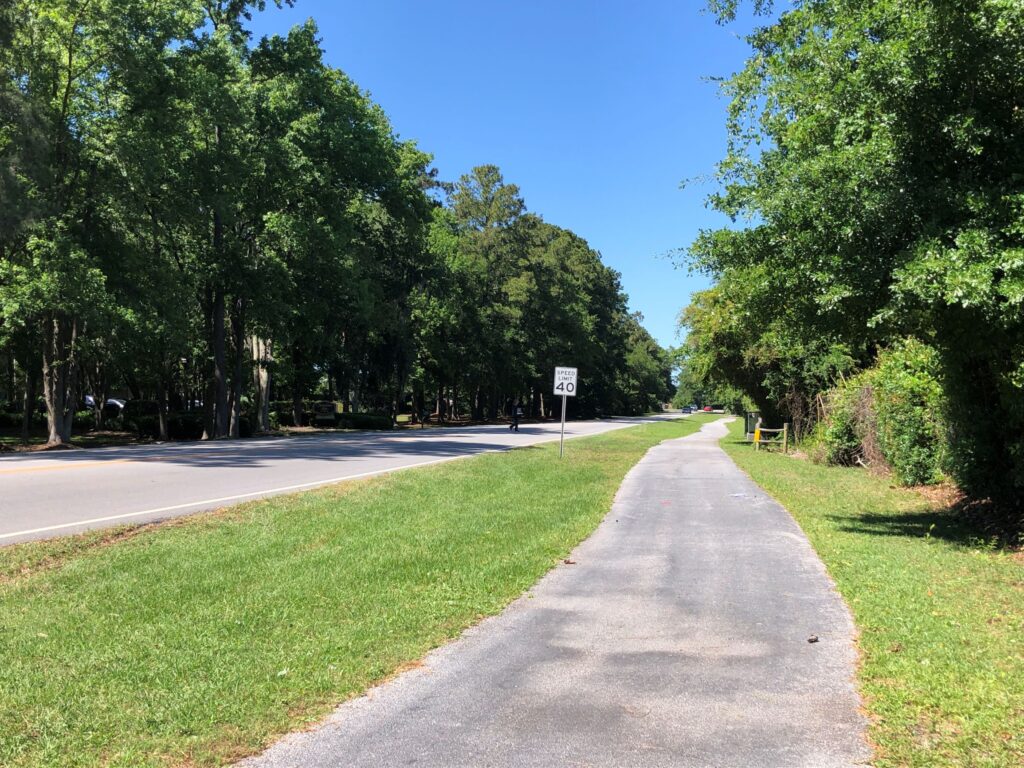
As we came to a bridge, several people were looking over the side, so we stopped to take a look – there was a gator in the water!
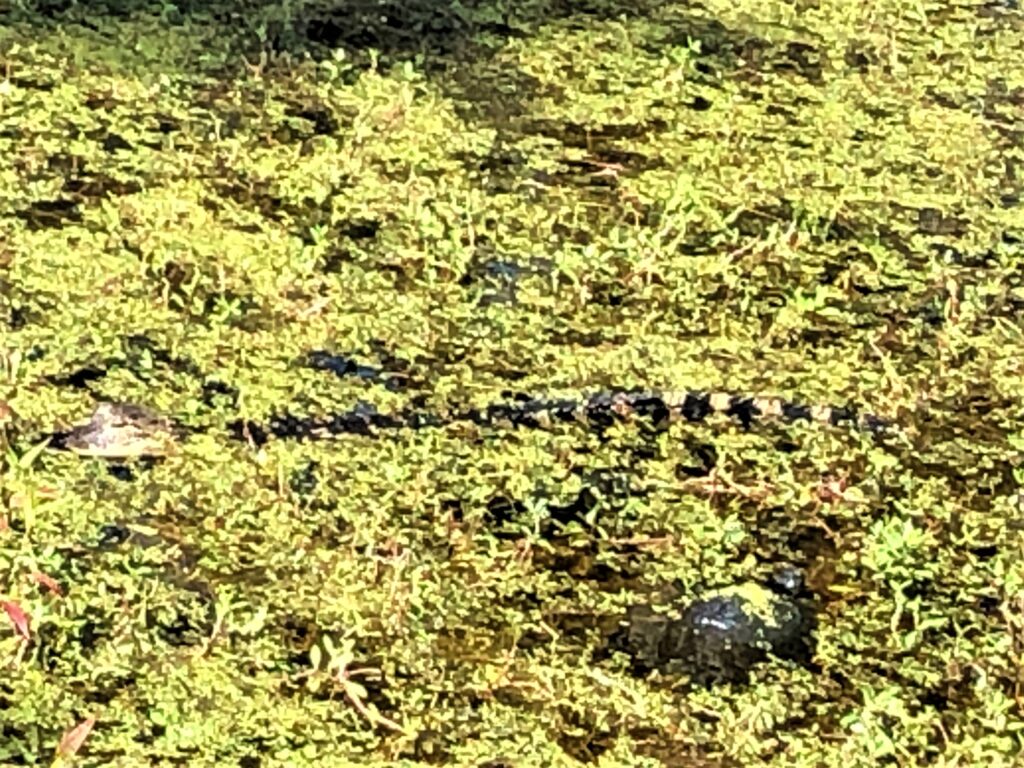
We rode out to the beach – what a beautiful day!
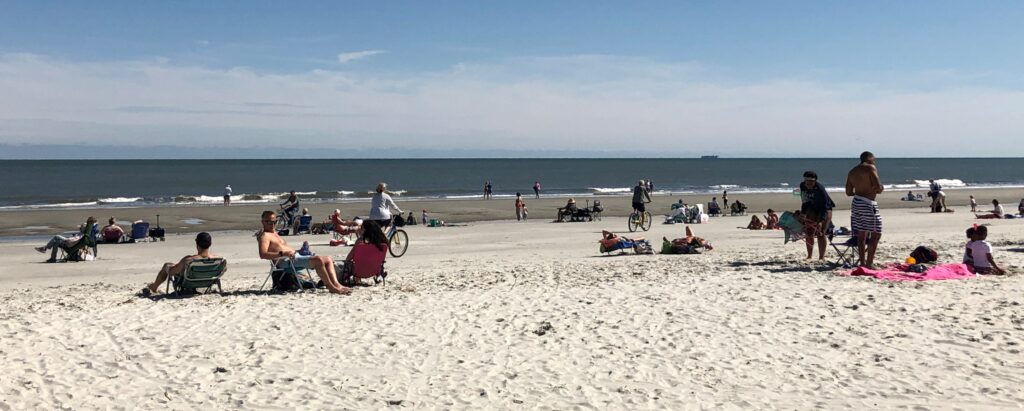
We rode about 20 miles around Hilton Head.
On Friday, we finished working on the tax return. Since we owe money this year, we had put it off… but Tax Day is Monday, so we need it done!
We went to Savannah GA on Saturday, and as we got to the river, we crossed the Talmadge Memorial Bridge, a cable-stayed bridge. It reminded us of the Sunshine Skyway bridge in Tampa.
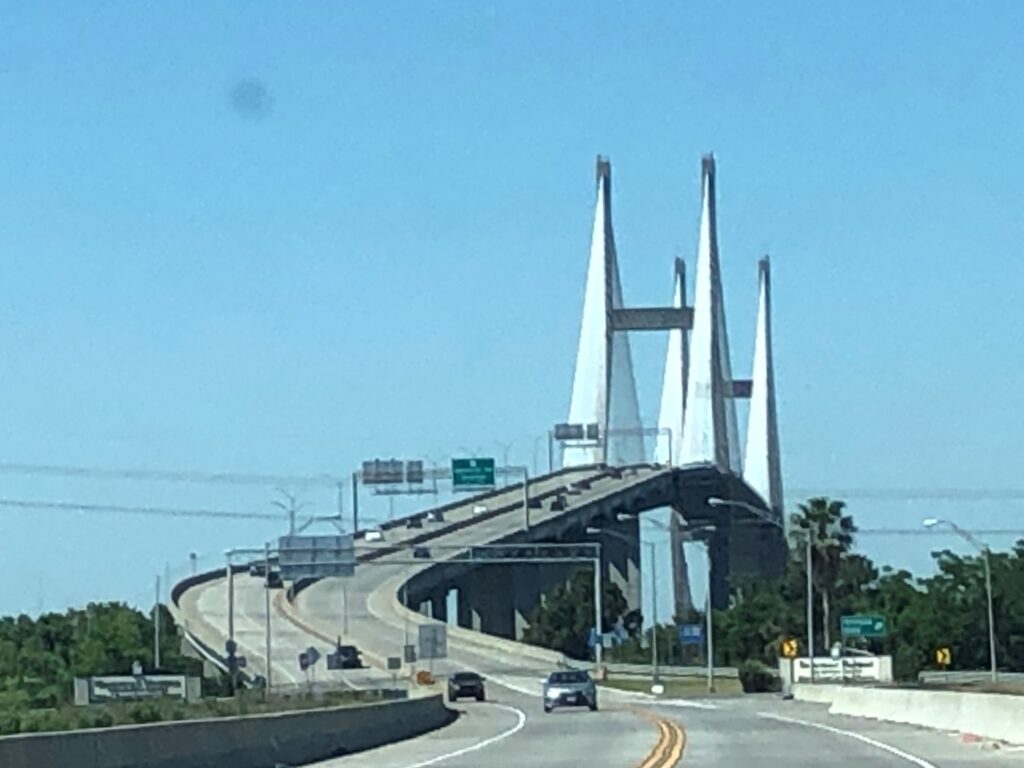
Savannah is the oldest city in Georgia, established in 1733 and was the first state capital of Georgia. Lots of history here! There are 22 squares – small parks that differ a bit from each other. Oglethorpe Square was the first one we came to – named for the founder of the colony of Georgia, in what was then British America, James Oglethorpe (1696-1785). He was also the founder of the city of Savannah and mapped out Savannah’s many squares, which he envisioned as tiny communities. Upper New Square, as it was originally known, was laid out in 1742 and was later renamed in honor of General Oglethorpe.
The Colonial Park Cemetery was the burying ground for the city from about 1750 until 1853 and became a city park in 1896. It covers about six acres and has over 9,000 graves.
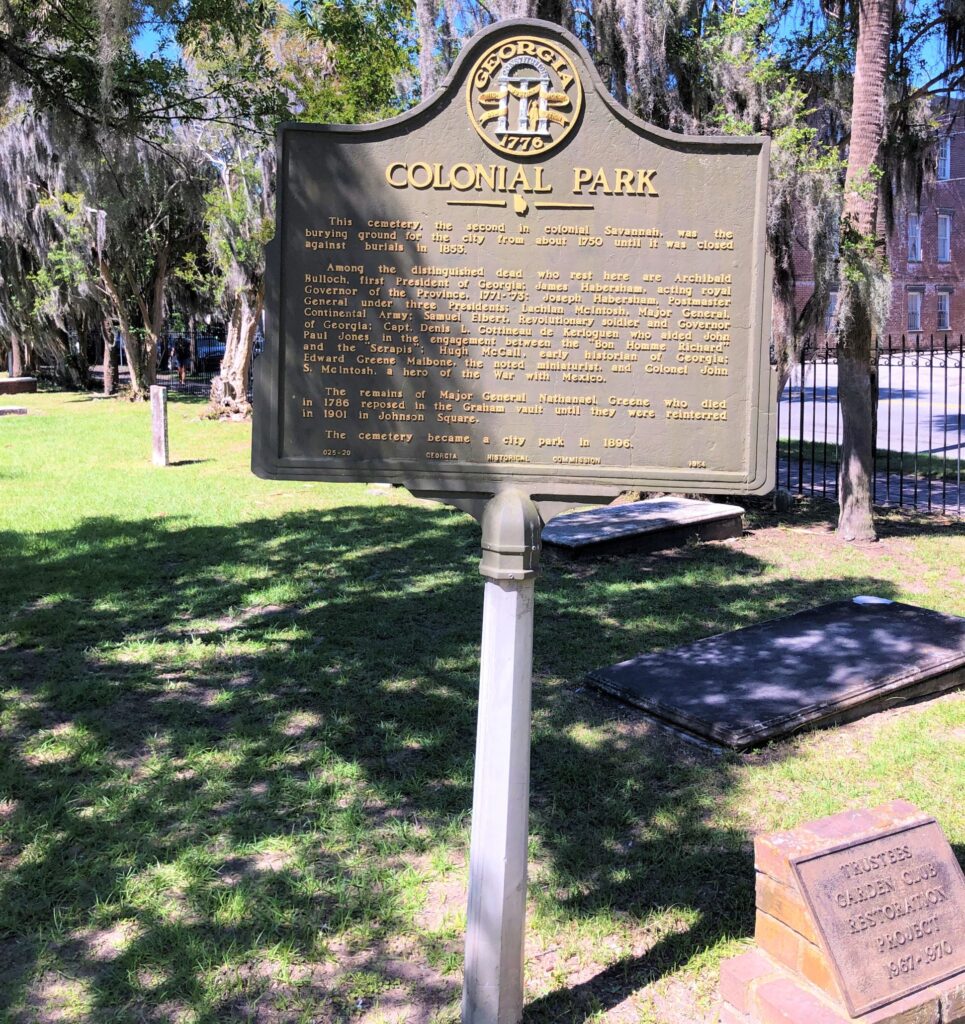
One of the first epitaphs we saw – for Anne Guerard – was really something!
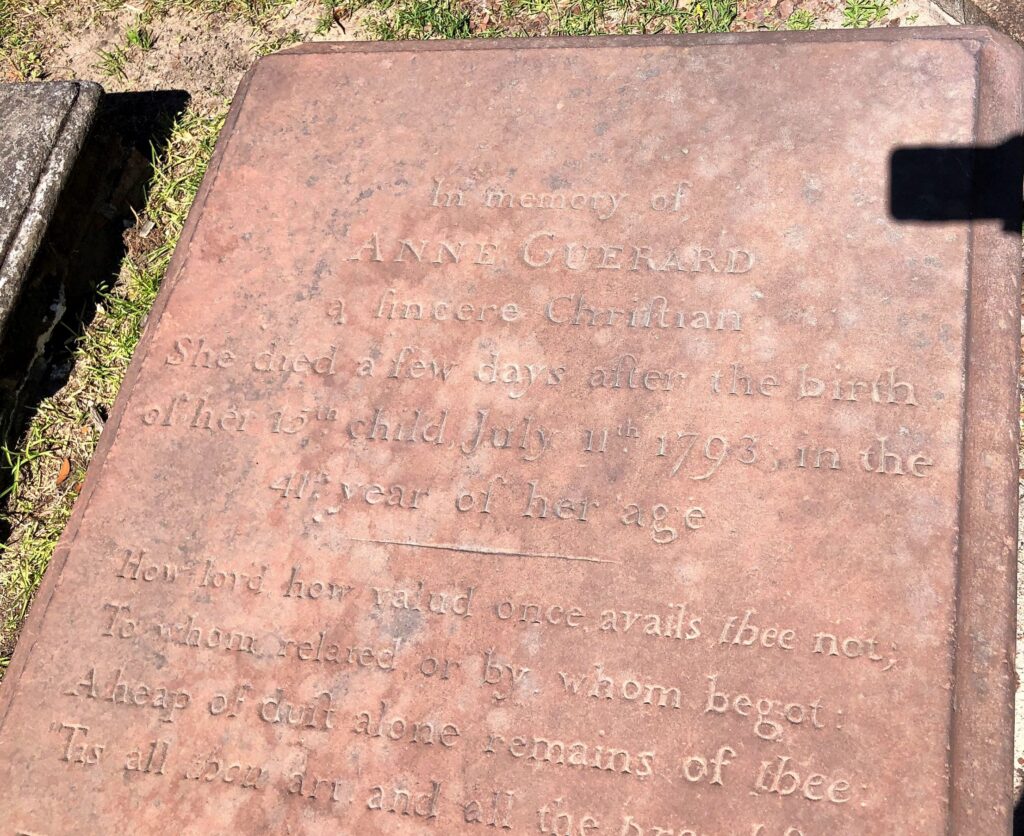
Among some of the famous people buried here was Edward Greene Malbone, said to be among the greatest painter of miniatures.
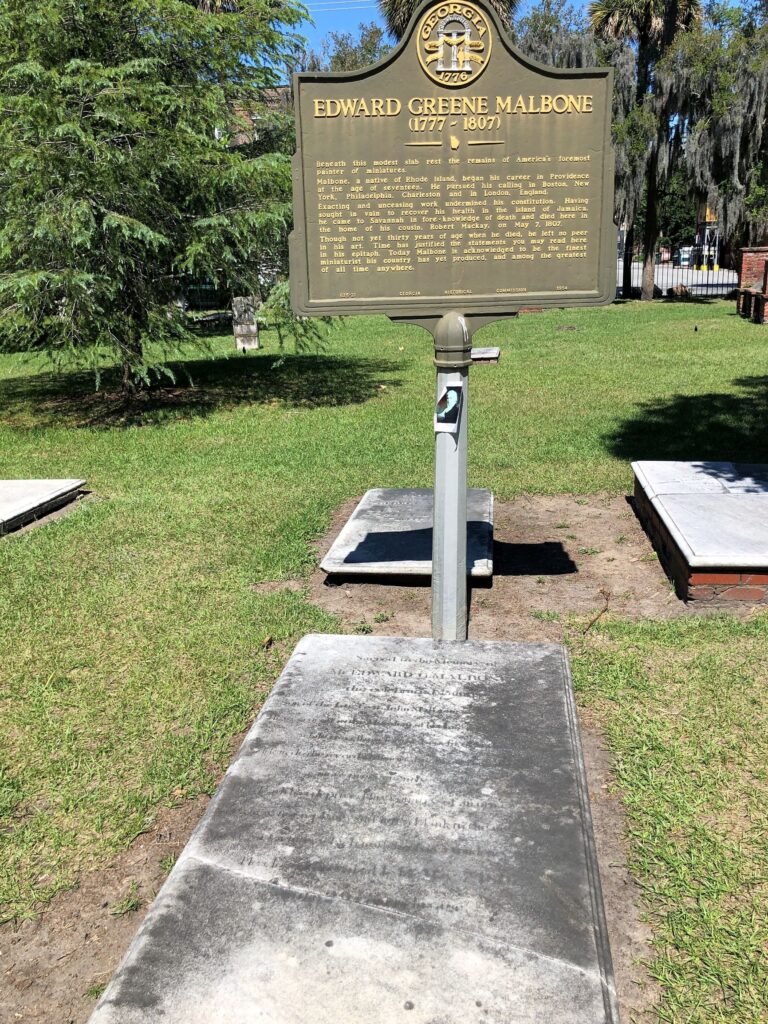
William Scarbrough who was instrumental in sending the first steamship across the Atlantic Ocean in 1819.
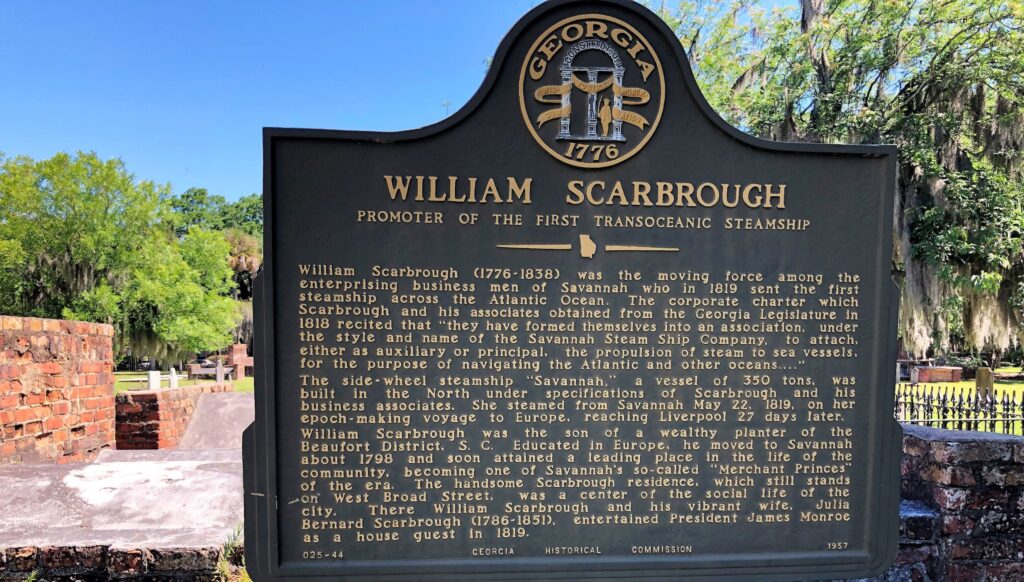
The Cathedral Basilica of St. John the Baptist is a Roman Catholic cathedral and, according to Wikipedia, “was the first building in Georgia constructed of brick. It features 81 stained glass windows, 16 gargoyles, is 214 feet tall with a roof height of 96 feet, took over 90,000 copper nails and 45,000 slates to construct.”
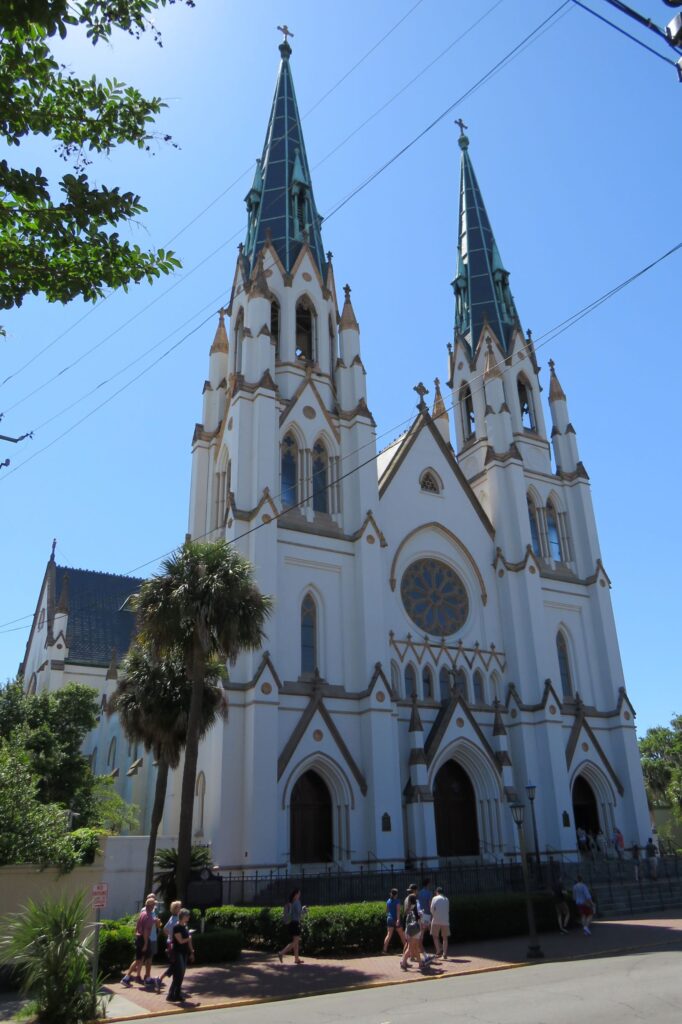
The ceiling inside was quite ornate.
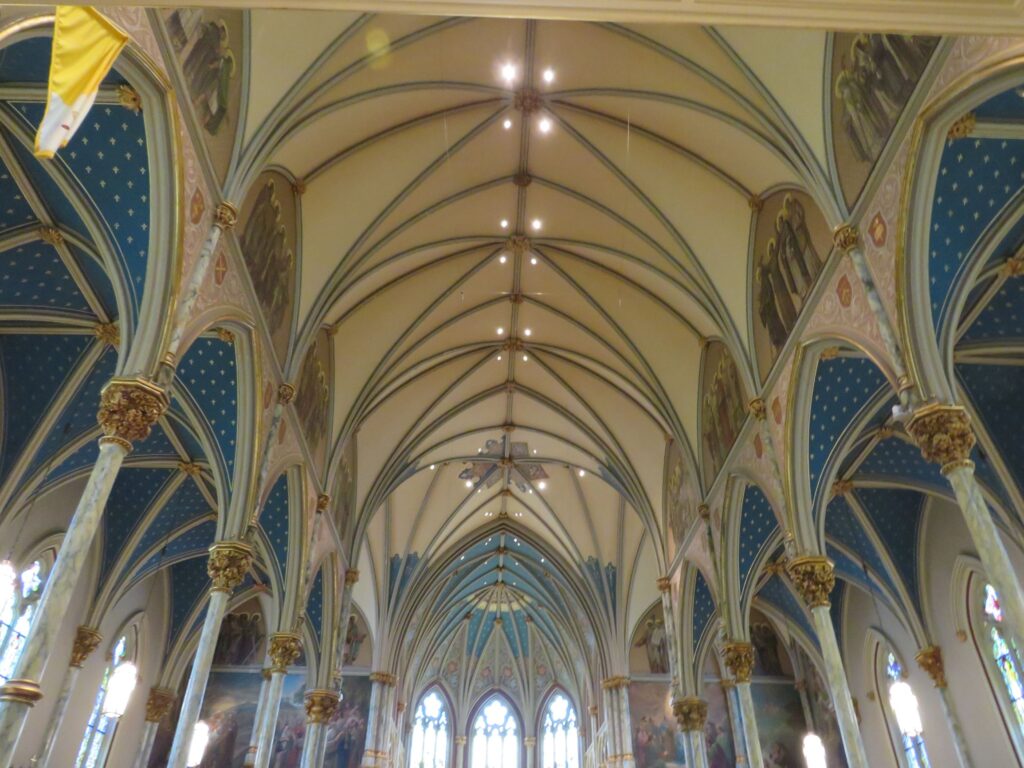
Beautiful gospel scenes depicted in stained glass.
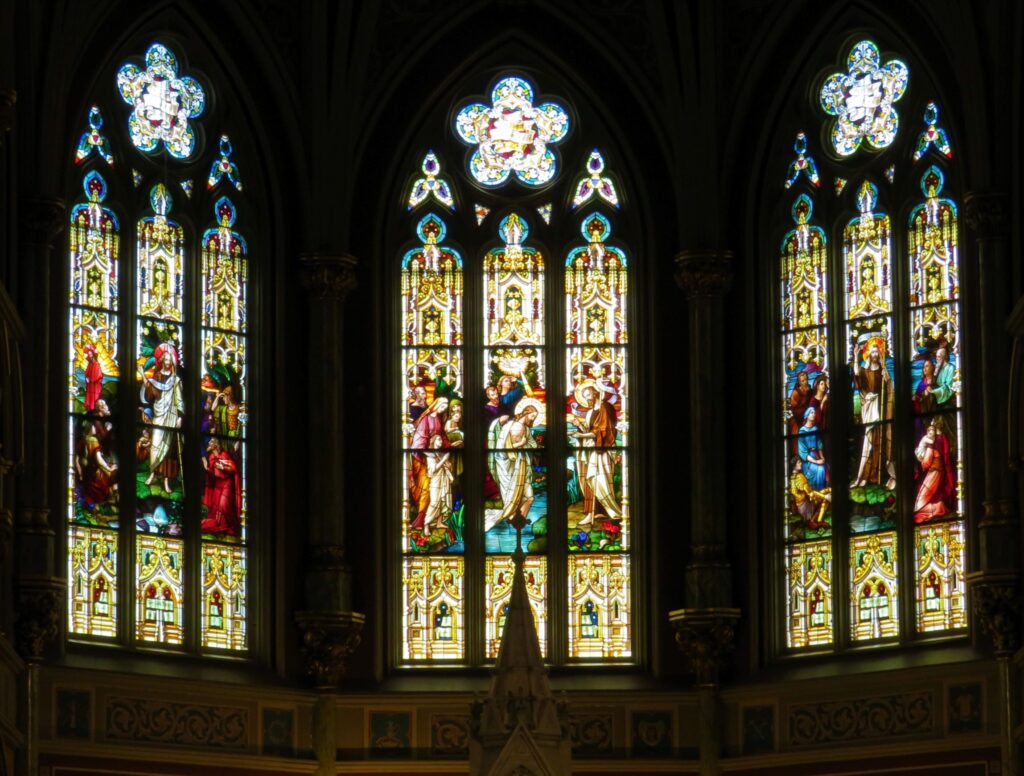
A very worshipful setting.
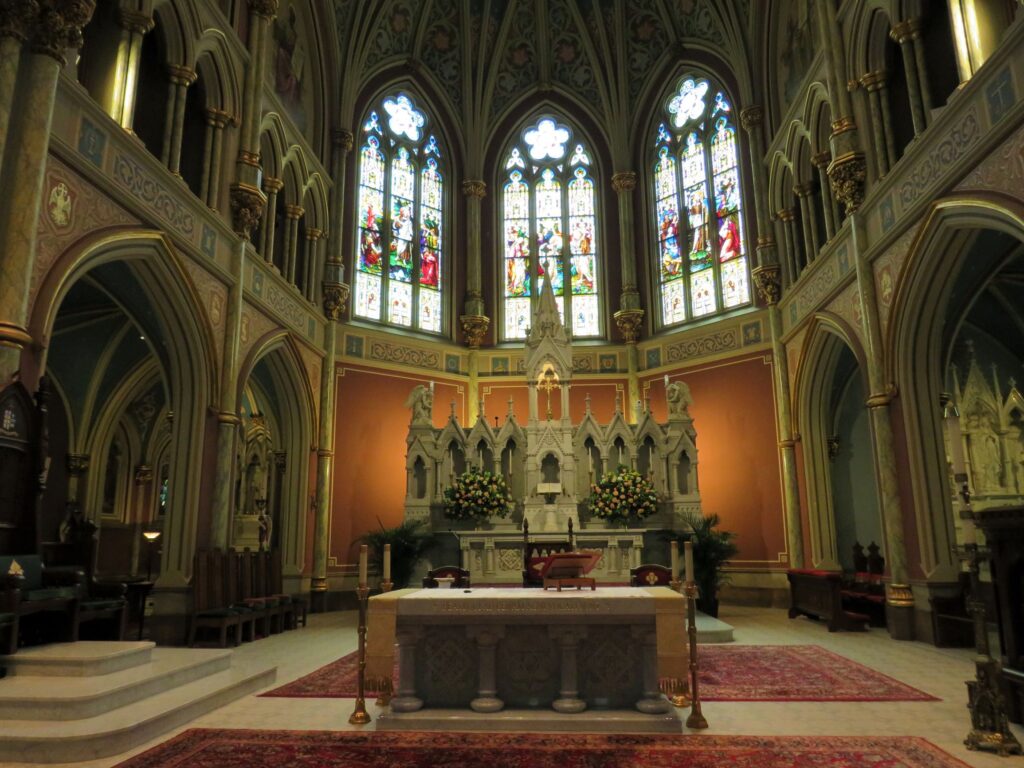
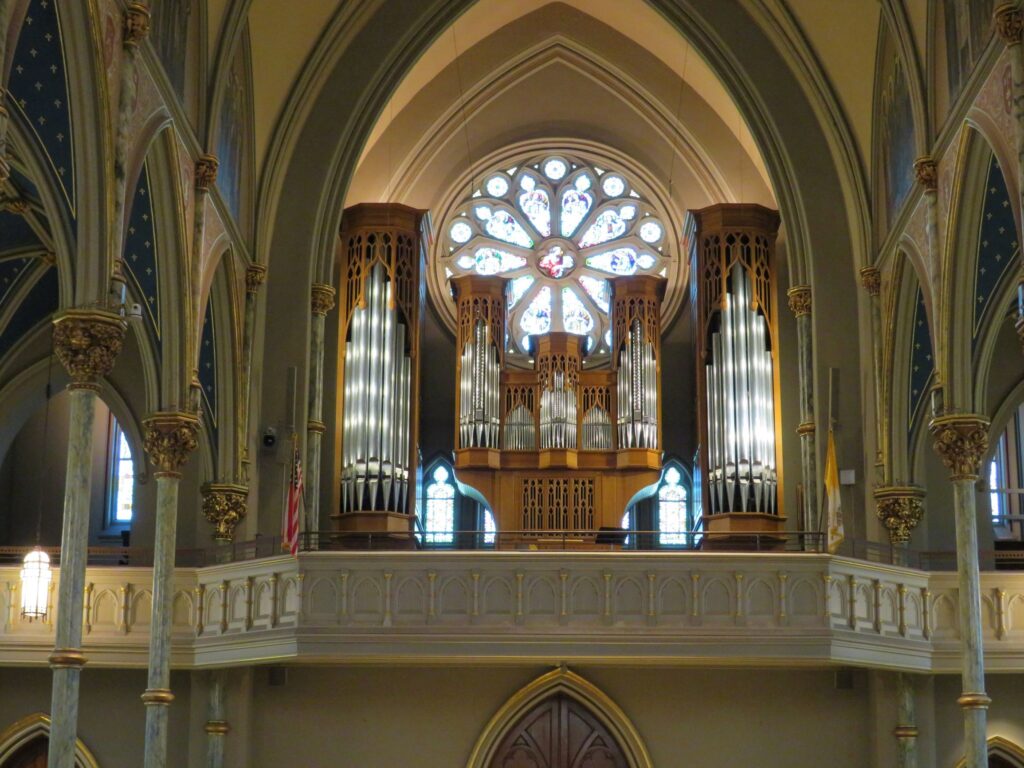
We walked through a few more squares and found Chippewa Square.
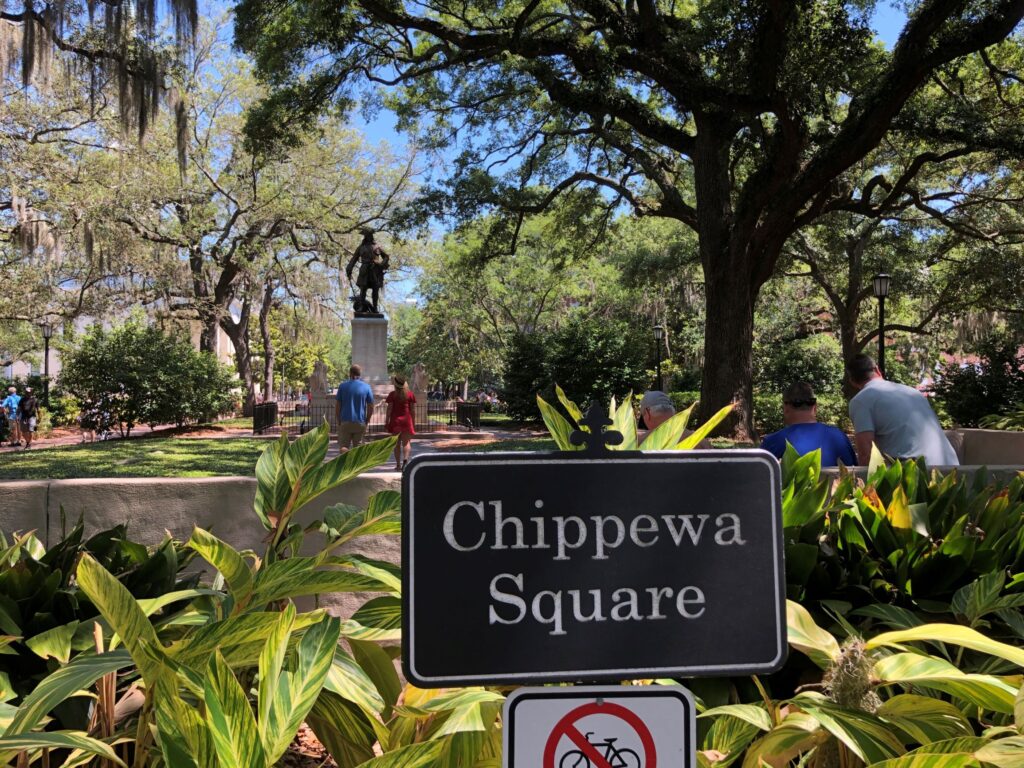
The statue of James Oglethorpe.
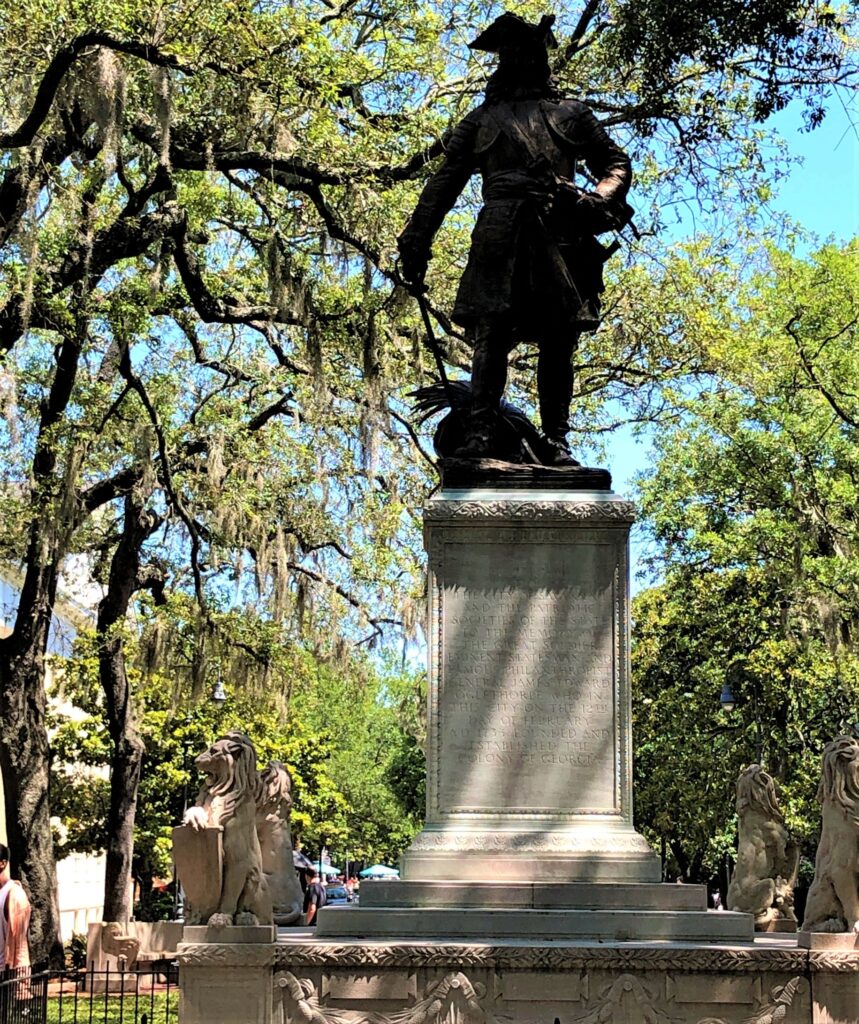
You may recognize the base of this statue from Forrest Gump – where Forrest sits on a bench (that was placed by the road for the movie) and tells his life story to other bench occupants. A few changes have occurred since the film was made in 1993-4.

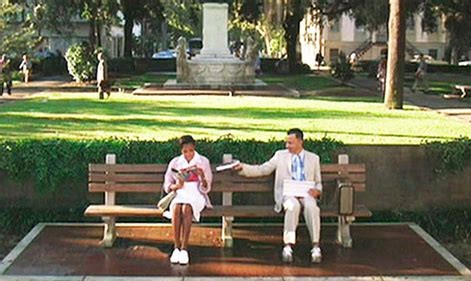
Forsyth Park is the largest park in the historic district, covering 30 acres. The city’s famous fountain was installed in 1858, modeled after the fountains at the Place de la Concorde in Paris.
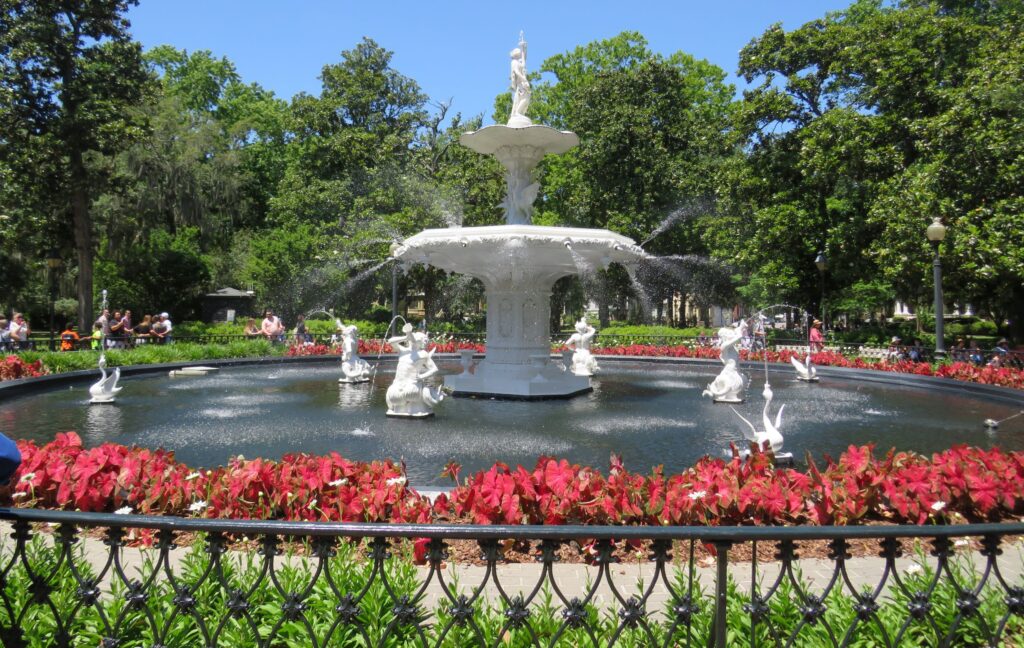
We walked in the park and saw a trumpeter, a violinist and a saxophone player – folks selling artwork and jewelry – many folks in the park enjoying the day! This Confederate Monument is the largest and the oldest of the monuments found in the park dedicated to Savannah’s war dead.
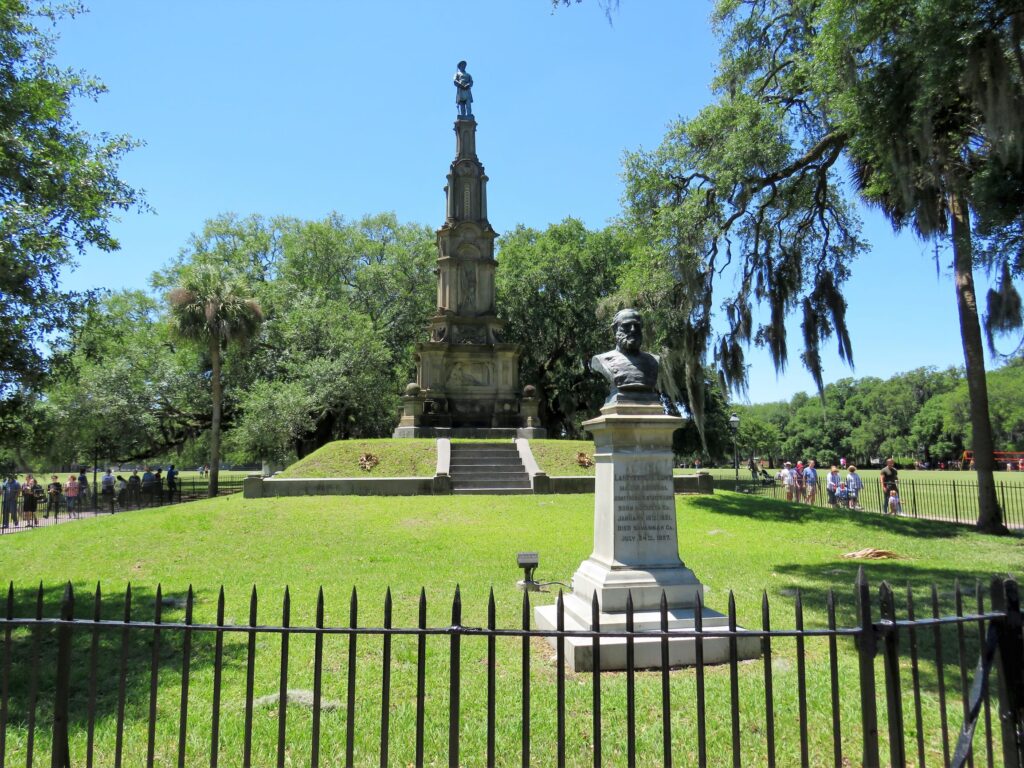
We saw the Juliette Gordon Lowe Birthplace; Low was born Juliette Magill Kinzie Gordon on October 31, 1860, in Savannah, Georgia. Her biography is quite interesting! Read it here. After the death of her millionaire husband, Low met William Baden-Powell, founder of the Boy Scouts, which inspired her to create the Girl Scouts of the United States of America in 1912. Following a battle with breast cancer, she died in Savannah in 1927.
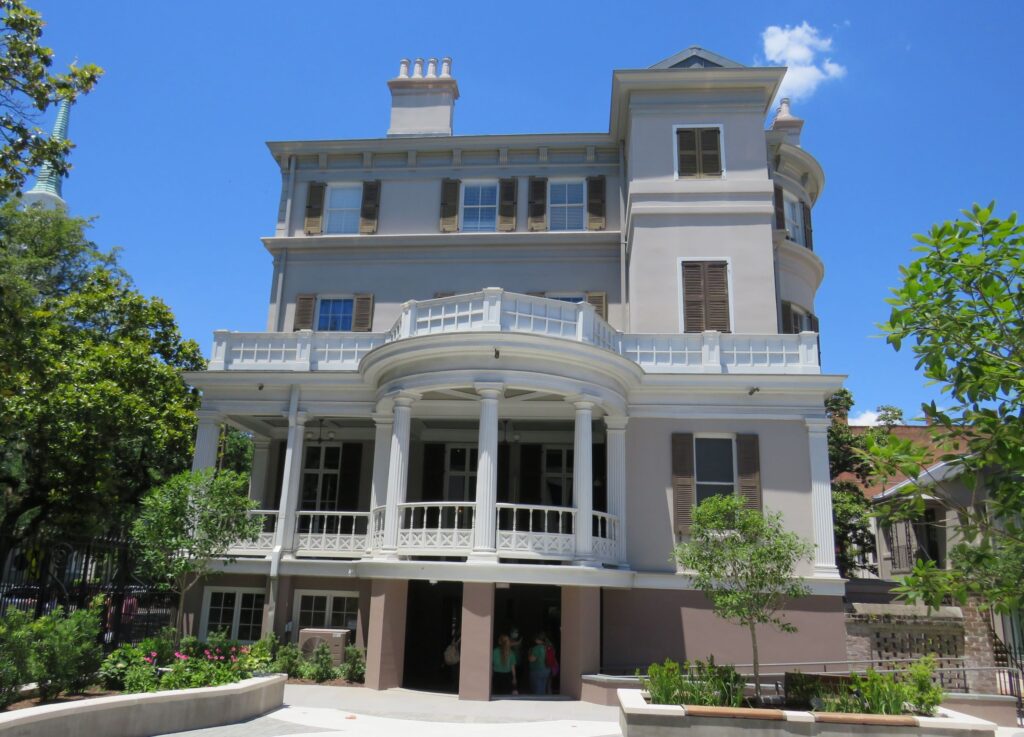
Here’s Linda with Juliette and her dog!
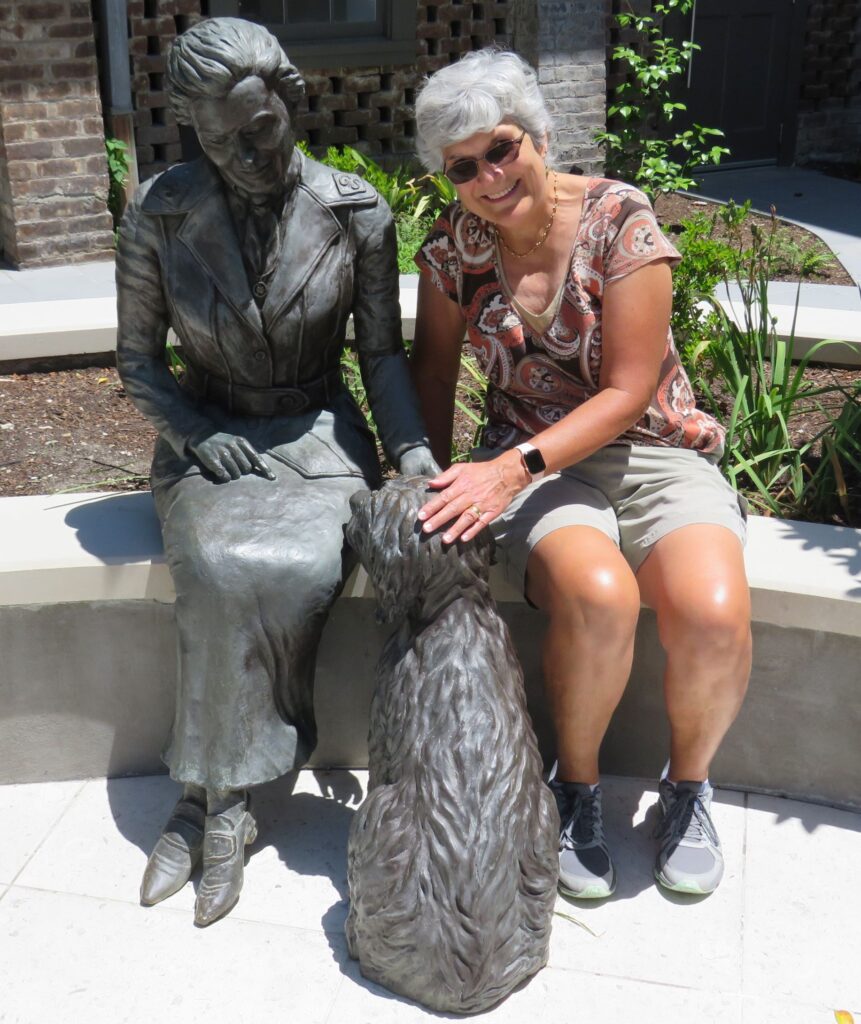
On our way to the riverfront, we spotted the City Hall with its gold dome.
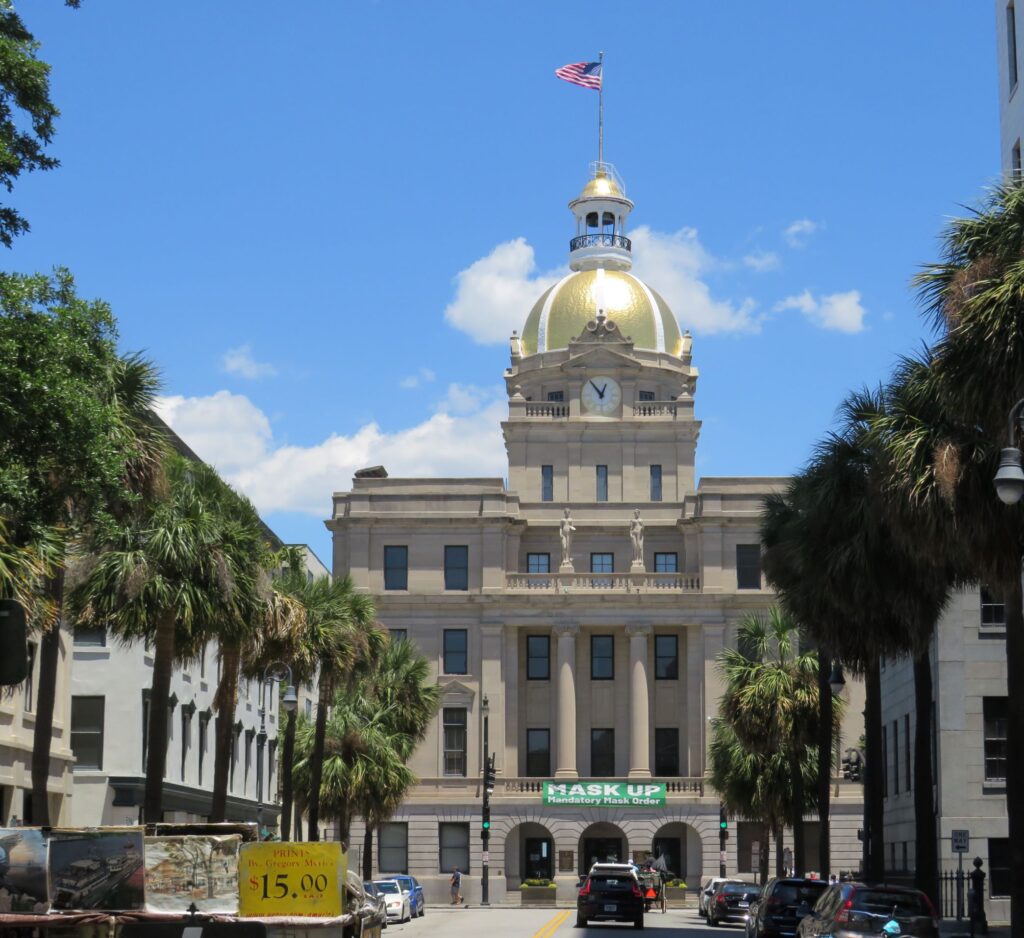
We stopped for lunch at the Old Pirates House.
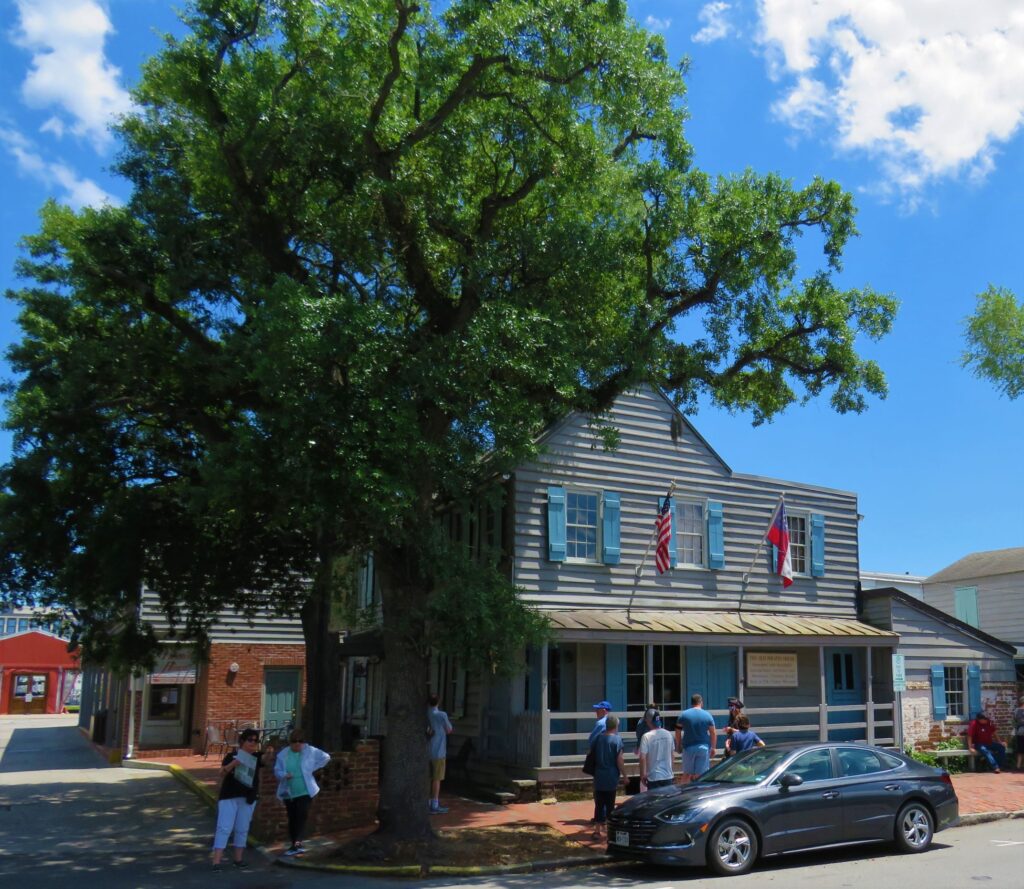
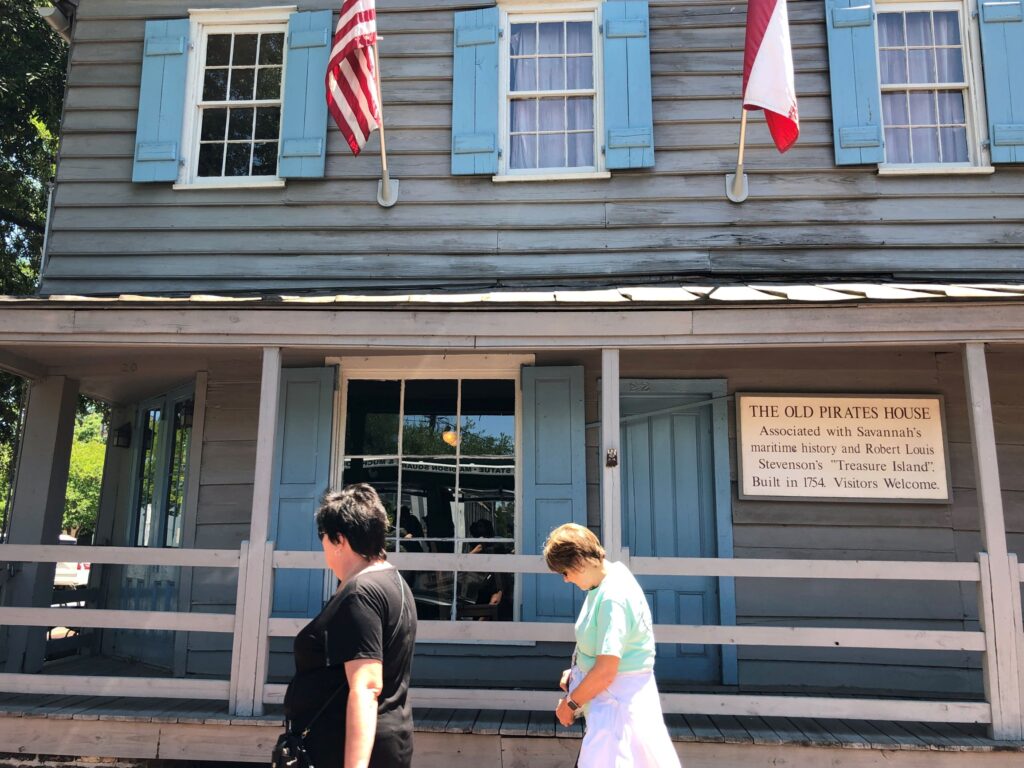
As we came down to the river, we saw the 1996 Olympic Yachting Cauldron – for the summer Olympic games in Atlanta.
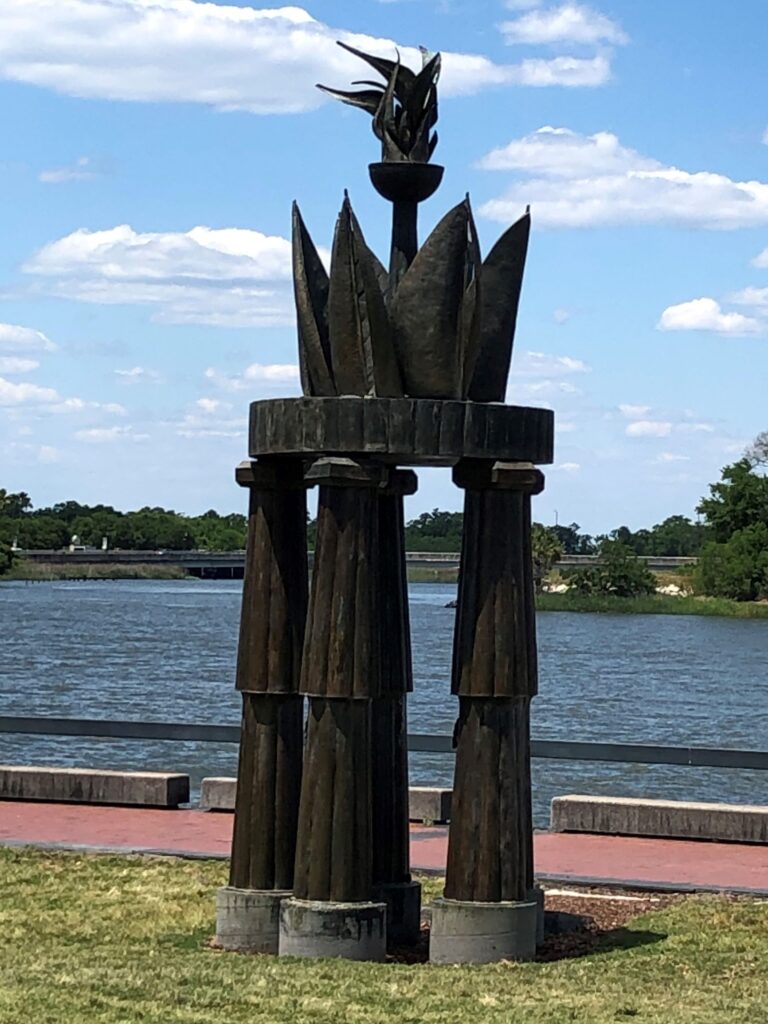
The Waving Girl Statue – in 1958 a historical marker was erected that told this story: “For 44 years, Florence Martus (1868-1943) lived on nearby Elba Island with her brother, the lighthouse keeper, and no ship arrived for Savannah or departed from 1887 to 1931 without her waving a handkerchief by day or a lantern by night. Throughout the years, the vessels in return watched for and saluted Florence. Few people ever met her yet she became the source of romantic legends when the story of her faithful greetings was told in ports all over the world. After her retirement, the Propeller Club of Savannah sponsored a celebration on Cockspur Island in honor of her seventieth birthday in 1938. A Liberty ship, built in Savannah in 1943, was named for her.”
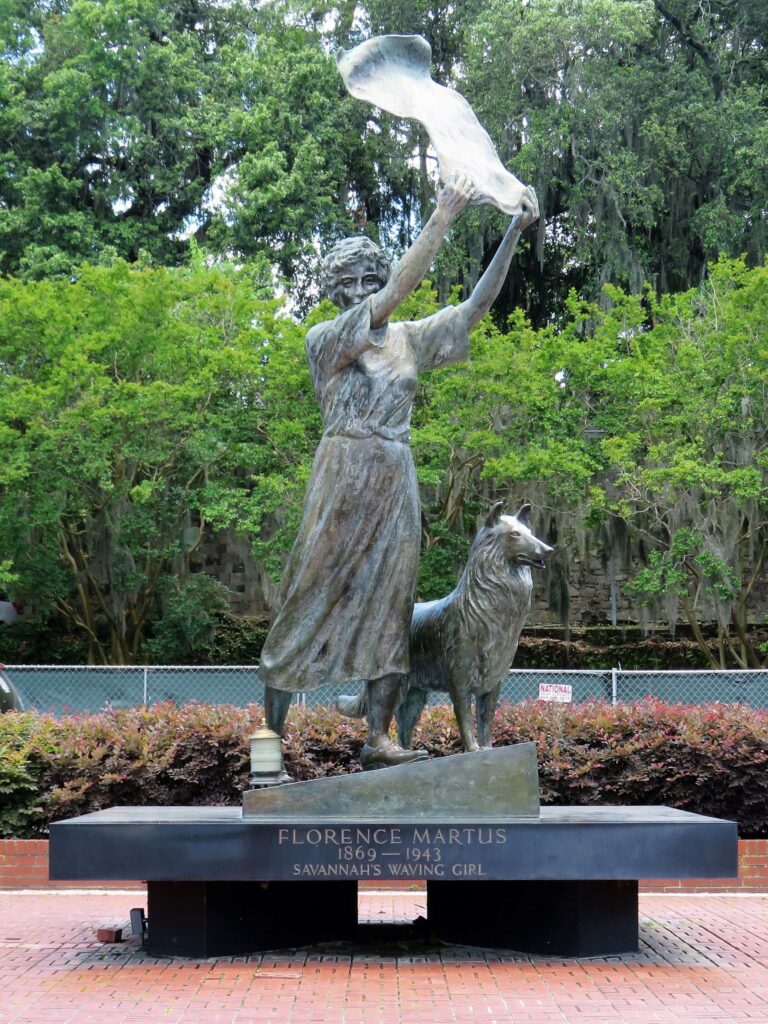
Interesting information about Savannah’s cobblestones; they came from ship ballast!
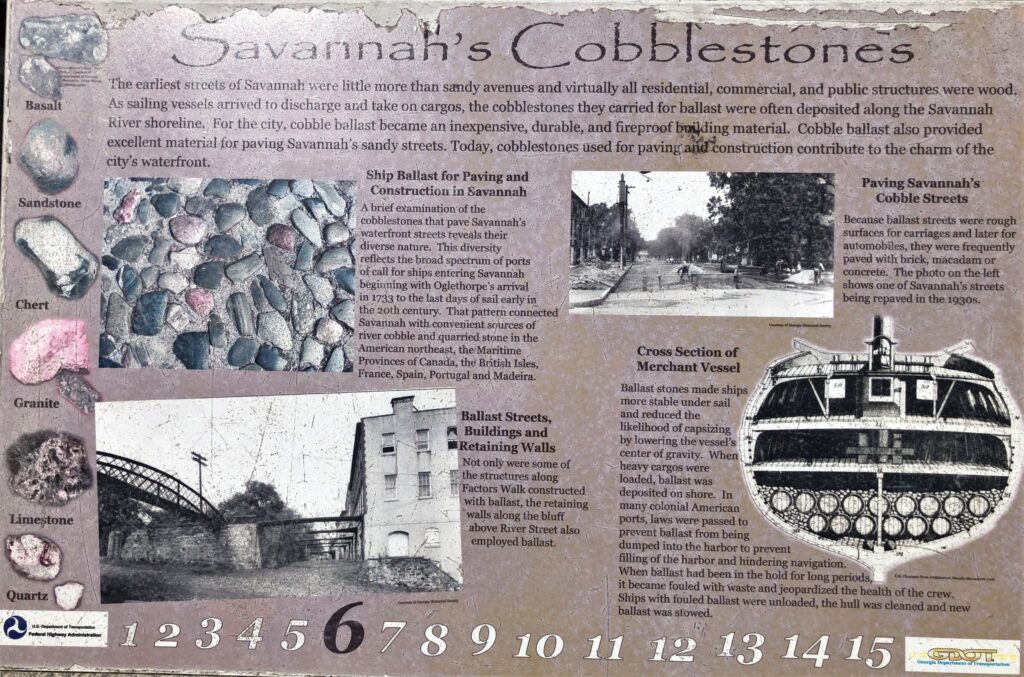
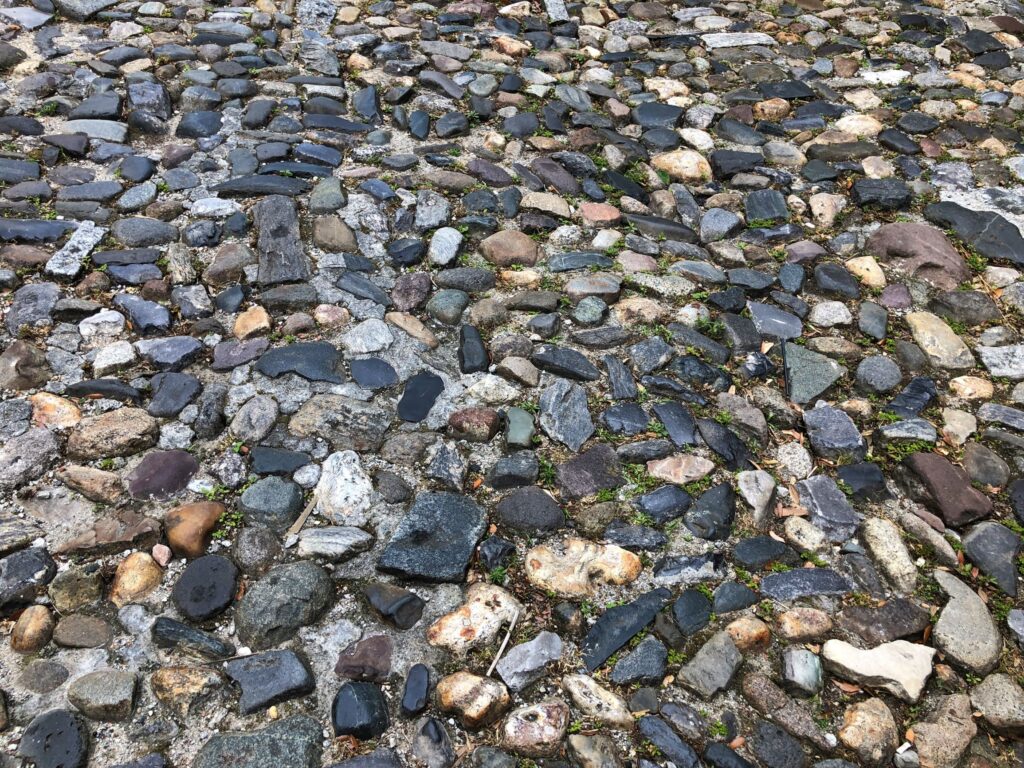
We had a pretty full day in Savannah and enjoyed seeing so many interesting places!
Sunday, as we usually do, we zoomed with our Sunday School Class and worshipped via You Tube with our home church in Nashville – Stephens Valley Church. After lunch, we set out to see some of the sites in nearby Beaufort where several scenes in Forrest Gump were filmed. One example of the magic of movie production and CGI was the use of this Art Center as the setting for the “Gump Medical Center”
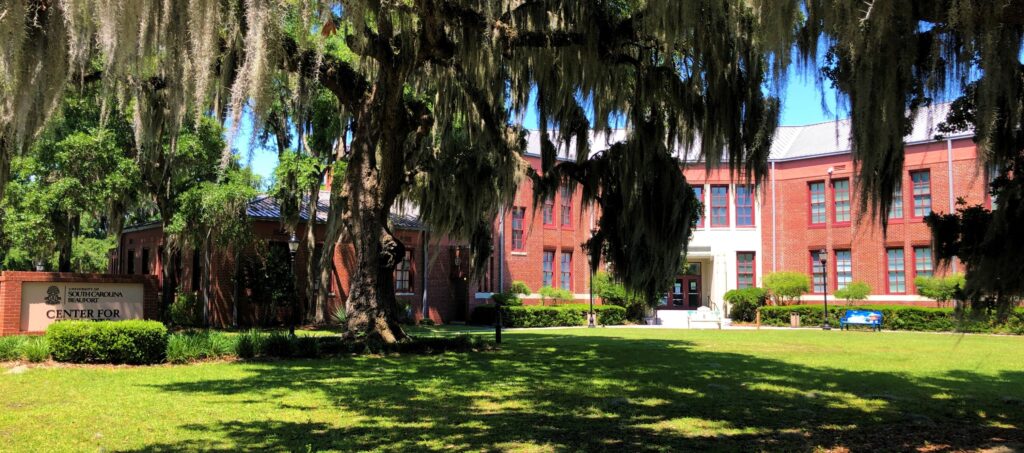
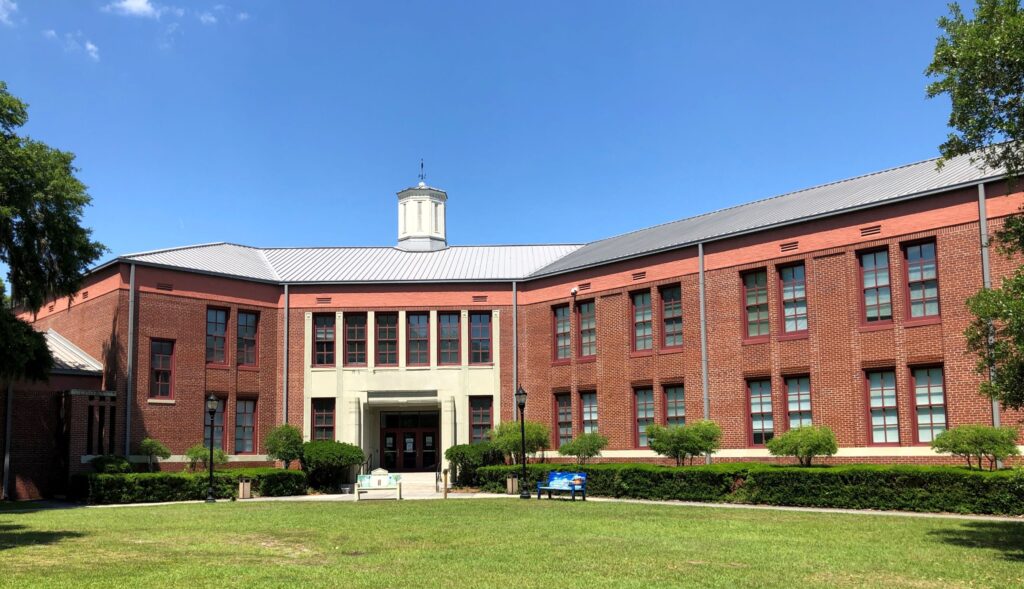
Computer generated imagery changed the sign!
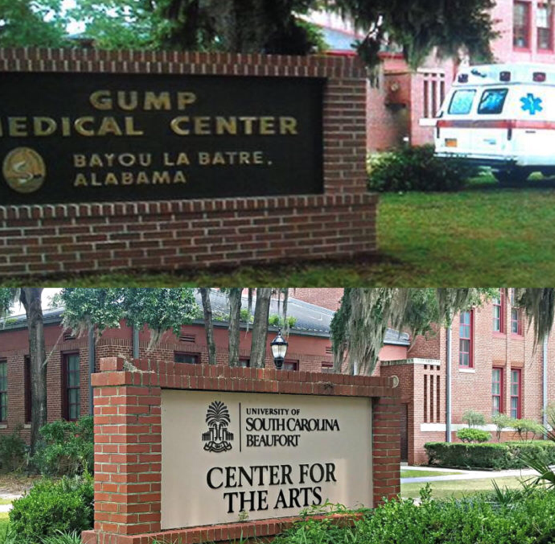
The Woods Memorial Bridge was used for the scene where Forrest “ran across the Mississippi” – it was really the Beaufort River.
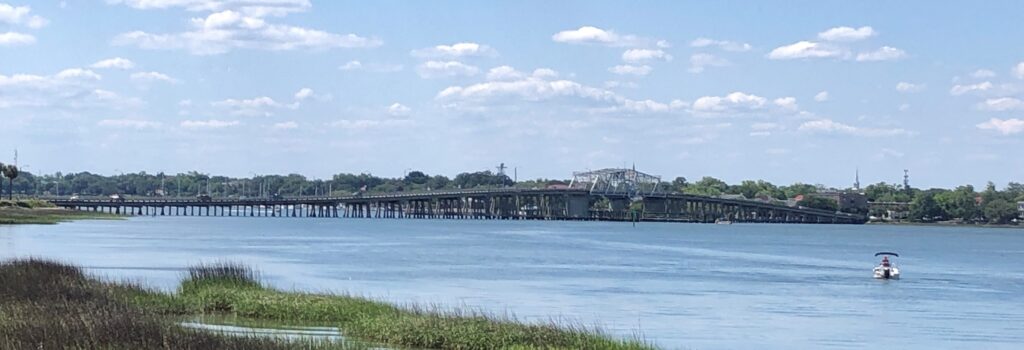
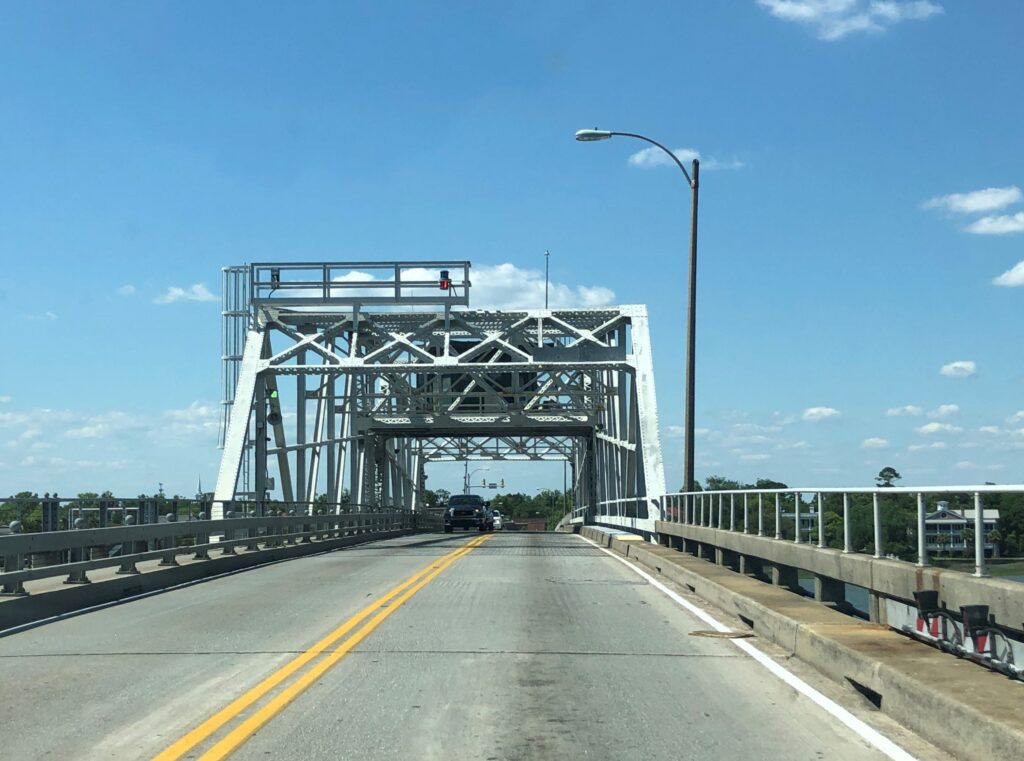
This small bridge over Cowen Creek was also featured but there was no place to stop for a better photo from the side.
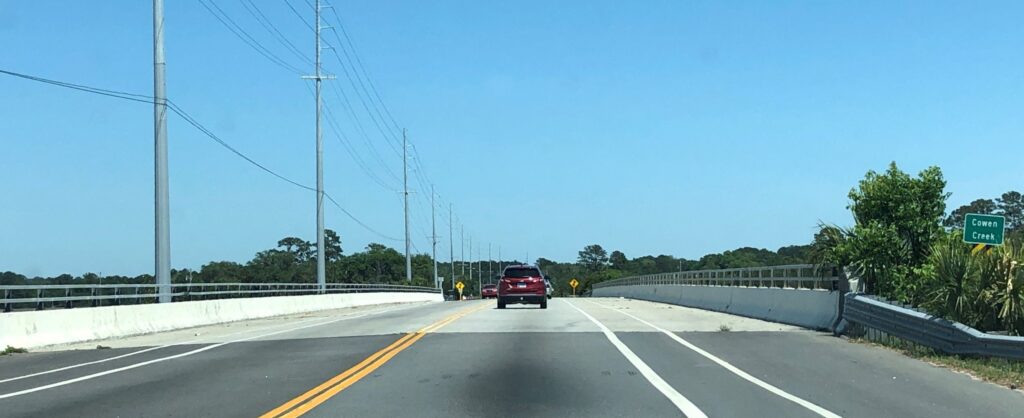
Forrest cut the grass at the Basil Green Sports Complex, not the university…

The McPhersonville Church was also featured in the movie – it does not appear to be in use today, but was definitely an appropriate structure for the film!
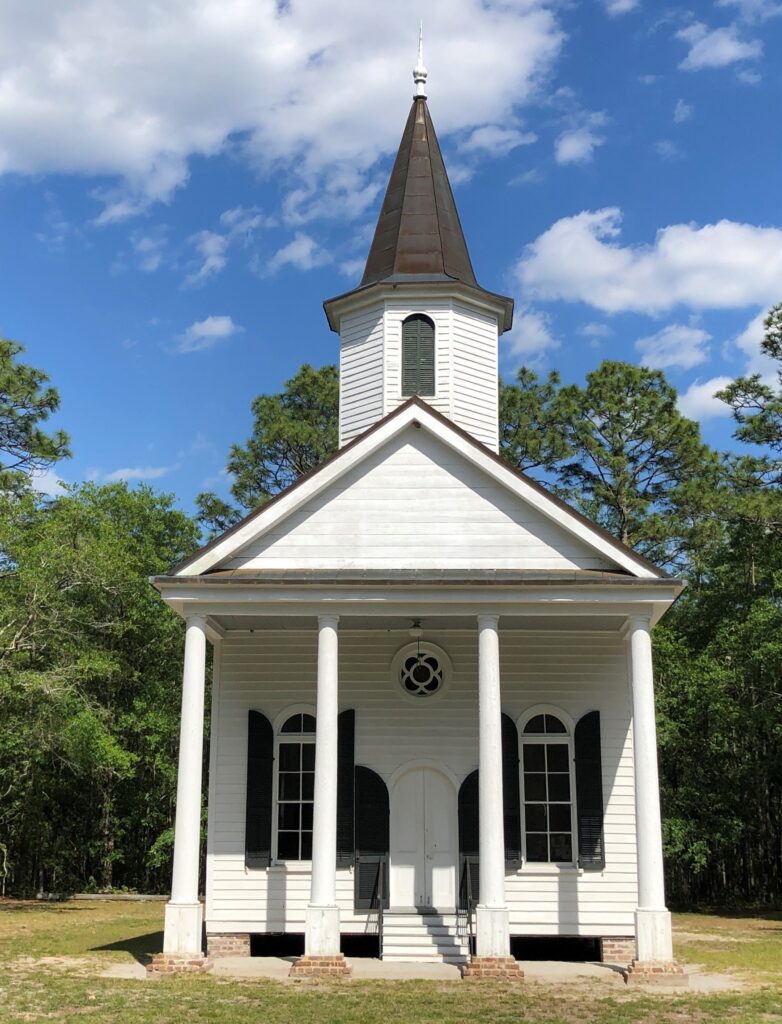
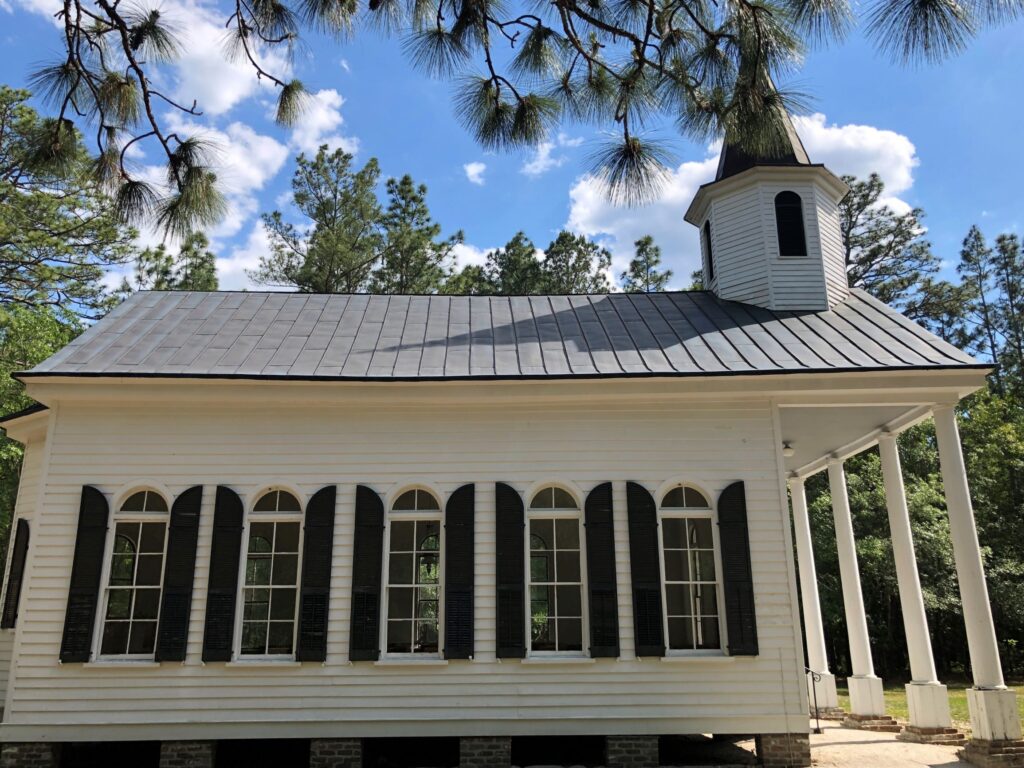
The building was locked, but we could see in the windows!
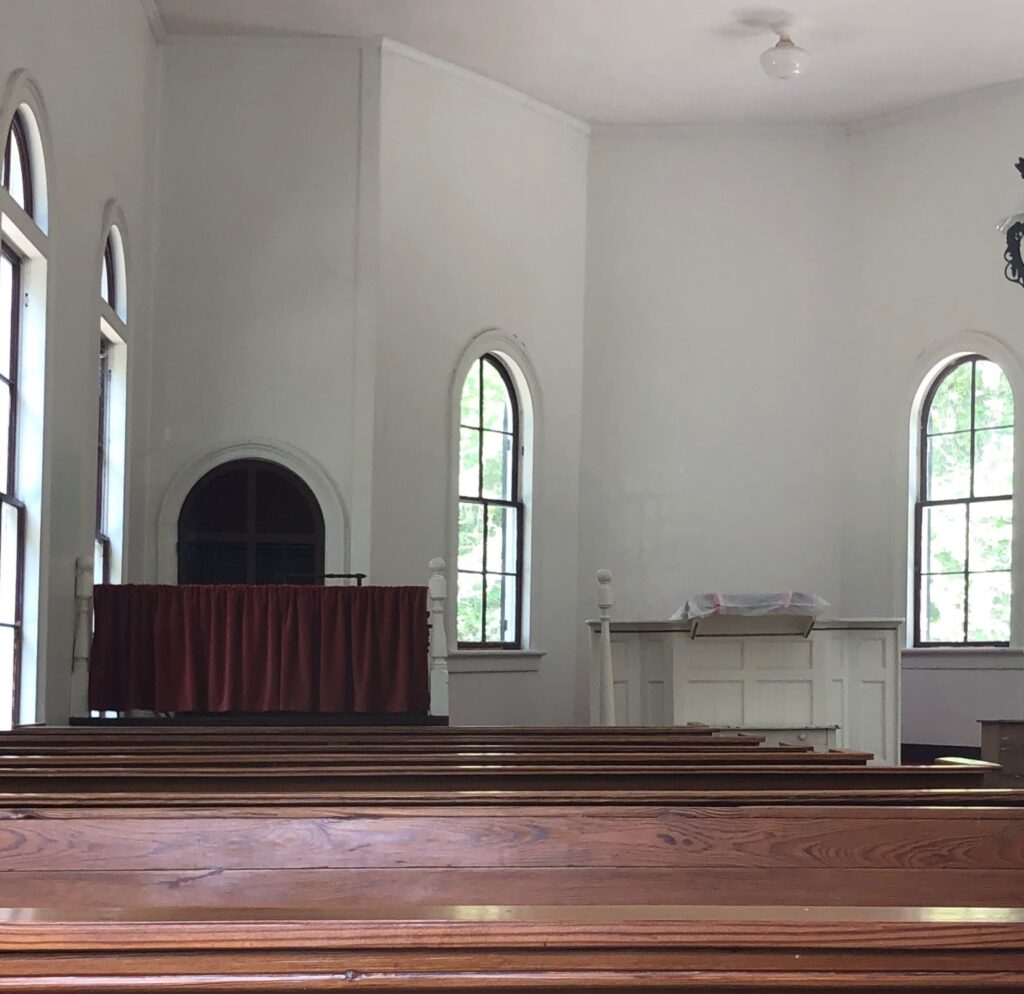
It was fun finding these places where Forrest Gump was filmed – and we found out that scenes from several other movies were filmed in and around Beaufort: “The Big Chill,” “Prince of Tides,” “G.I. Jane,” “A Perfect World,” “The Jungle Book,” “The Fugitive,” “Full Metal Jacket” (filmed at Parris Island) and “The Great Santini.”
On Monday, we rode our bikes 20 miles on the Spanish Moss Trail, and on Tuesday we returned to Charleston to visit Patriots Point. We crossed over the Arthur Ravenel, Jr. Bridge, which has eight travel lanes (the Talmadge Memorial Bridge in Savannah has just four lanes) plus a dedicated bike/pedestrian lane. Completed in 2005, the clearance under the cable-stayed Ravenel Bridge (186 feet) is actually only one foot taller than that of the Talmadge Bridge. As for the span (the space between the towers) of the bridges, the Ravenel Bridge is 1,546 feet. The Talmadge Bridge is 1,100 feet. The Ravenel Bridge opened in 2005.
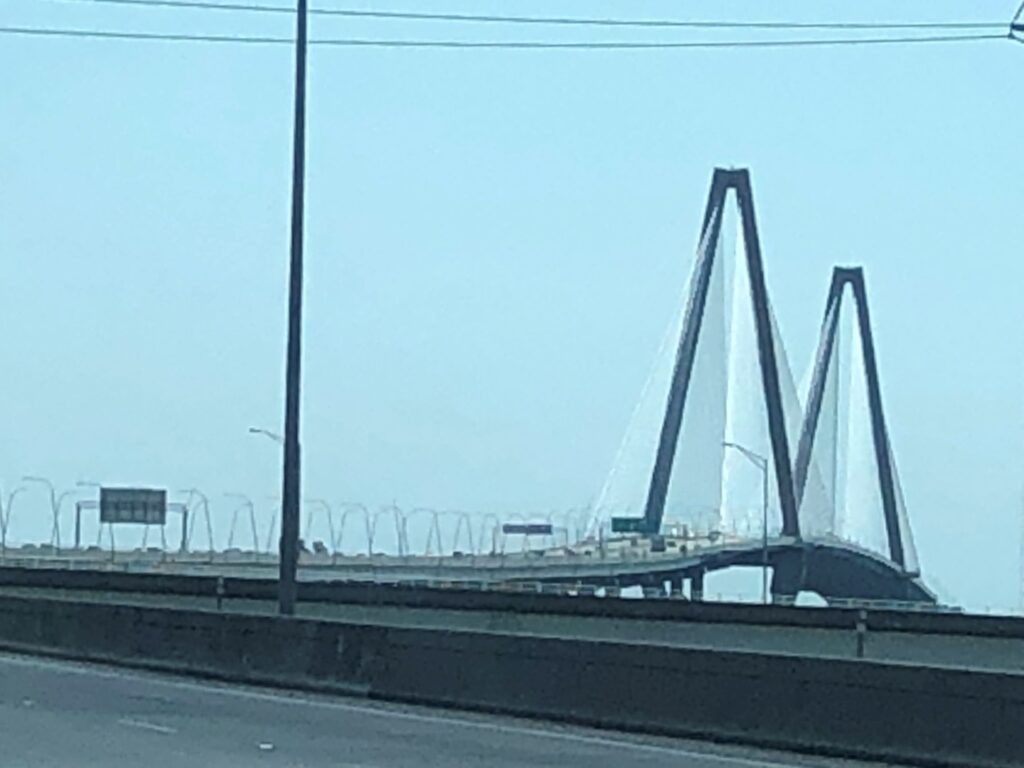
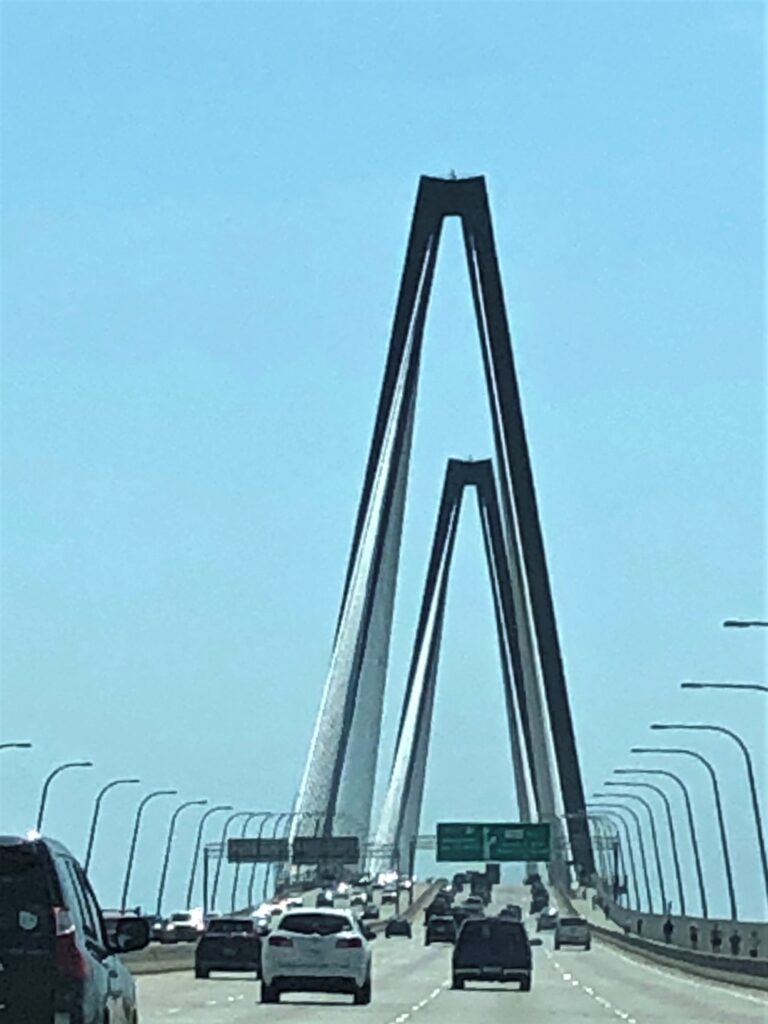
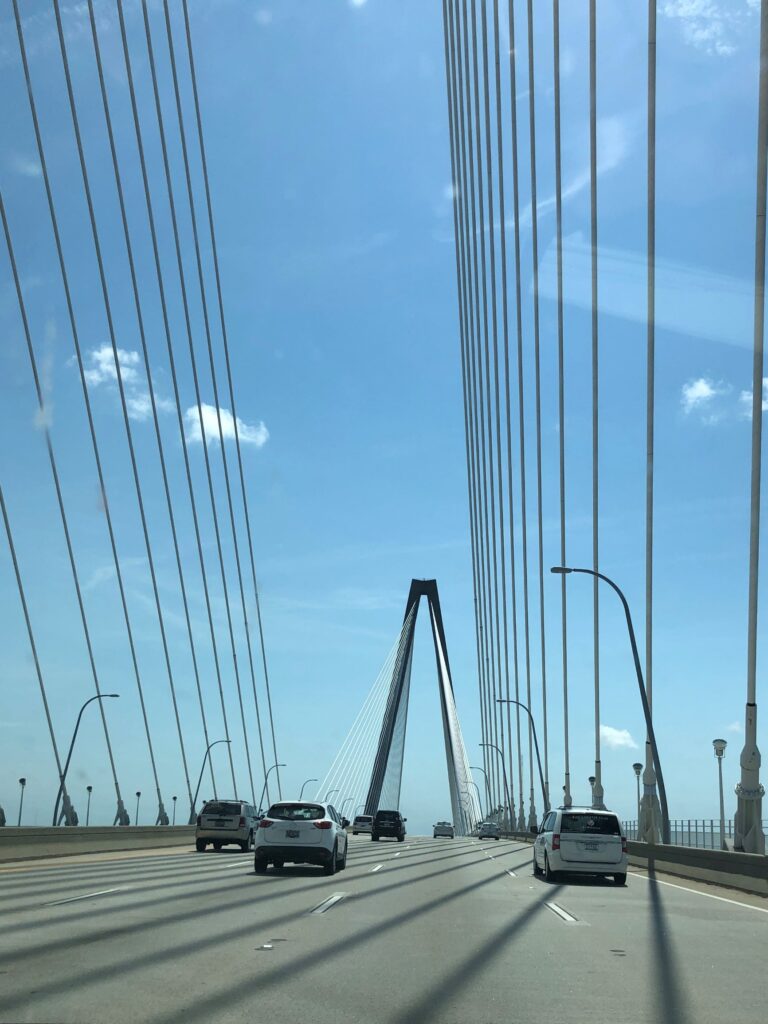
Patriots Point is home to the the World War II aircraft carrier, USS YORKTOWN, and opened in 1976. It also features the USS Laffey Destroyer, the USS Clamagore submarine, some aircraft, the Vietnam Experience and a Medal of Honor Museum.

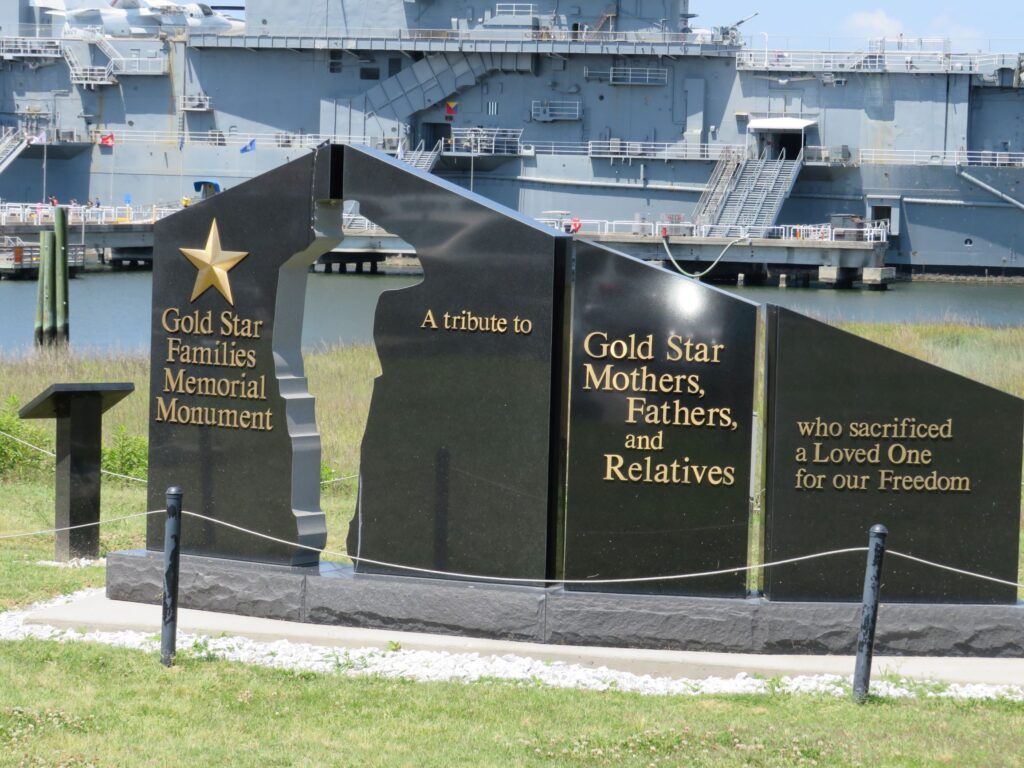
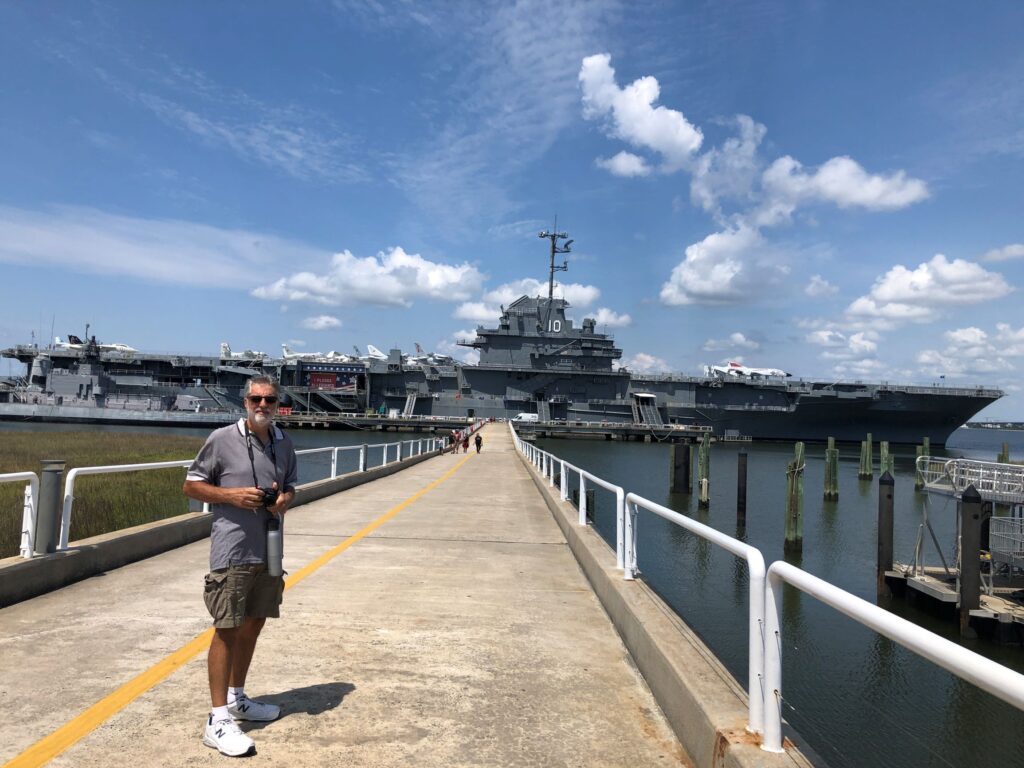
We couldn’t see everything in one day, but you can read more here! We started our visit by coming aboard the USS Laffey (DD-724).
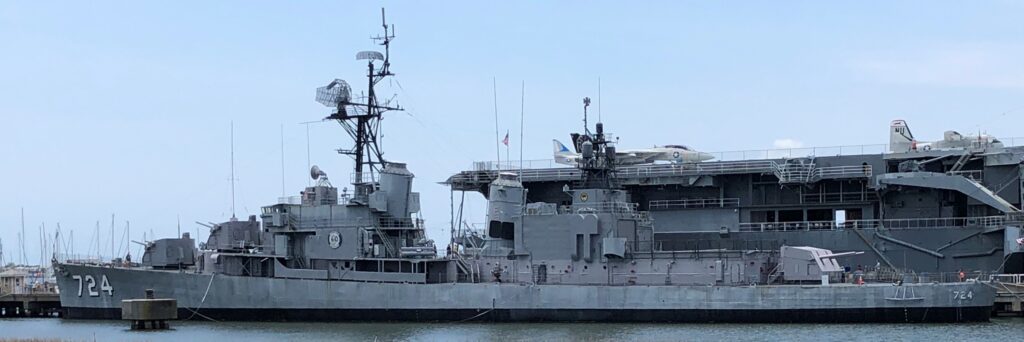
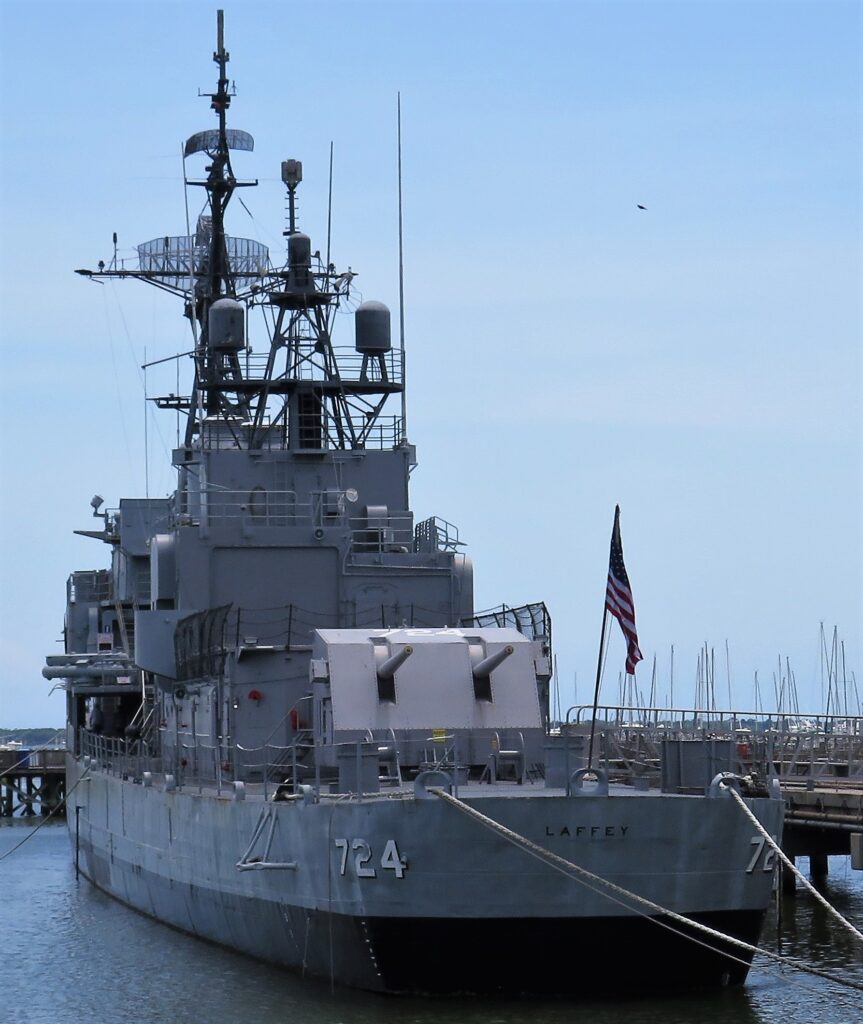
The docent told us the story of the bombing that destroyed this gun mount on the stern of the ship when the ship was attacked by 22 Japanese aircraft – conventional bombers and kamikazes – on April 16. 1945. The Laffey survived the attack and was nicknamed ‘The Ship That Would Not Die.’
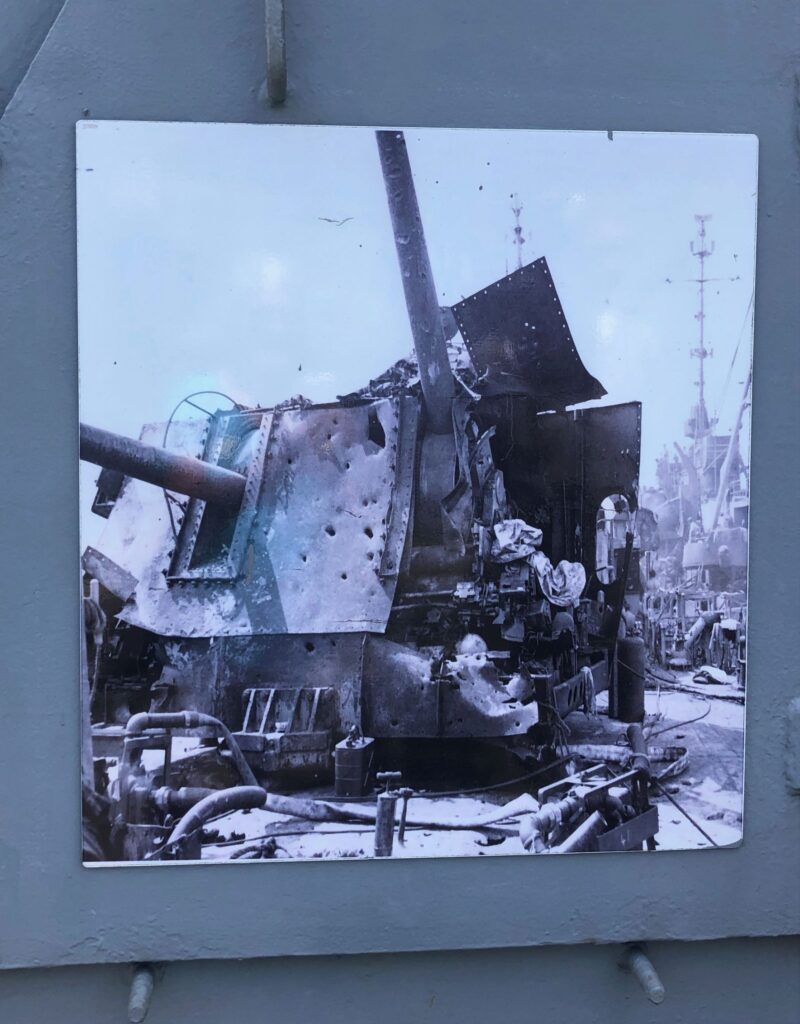
On the deck, we found a Depth Charge.
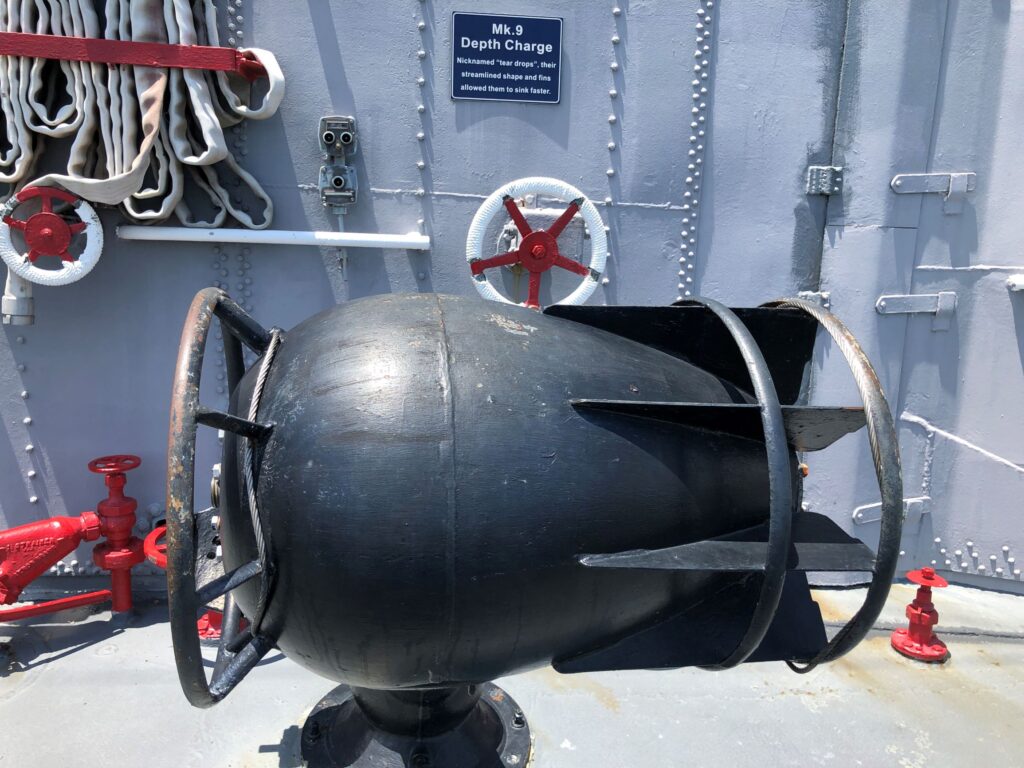
It was interesting to climb around and explore this ship that served from 1944 to 1975; in WWII, the Korean War and the Cold War – Laffey was declared a National Historic Landmark in 1986, at which time she was recognized as the only remaining US-owned Sumner-class destroyer, and for her spirited survival of the kamikaze attack.
Then we came aboard the USS Yorktown (CV-10), one of 24 Essex-class aircraft carriers built during World War II. Nicknamed “The Fighting Lady” she was commissioned in April 1943, it served in WWII, the Korean War, the Vietnam War and also as a recovery ship for the Apollo 8 space mission. She was used in the films Tora! Tora! Tora! and The Philadelphia Experiment. Yorktown was decommissioned in 1970 and in 1975 became a museum ship here at Patriots Point.

We were excited to see a model of an LSM (Landing Ship Medium) – Linda’s father served as a Quartermaster on LSM 178 in WWII.
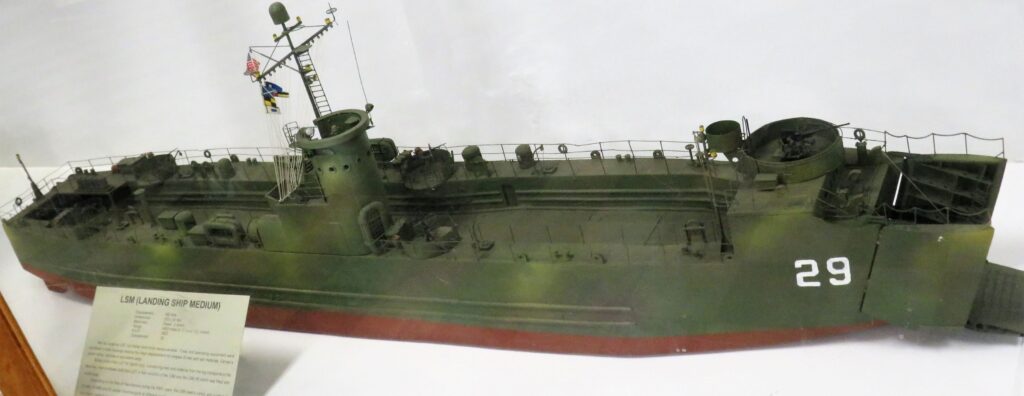
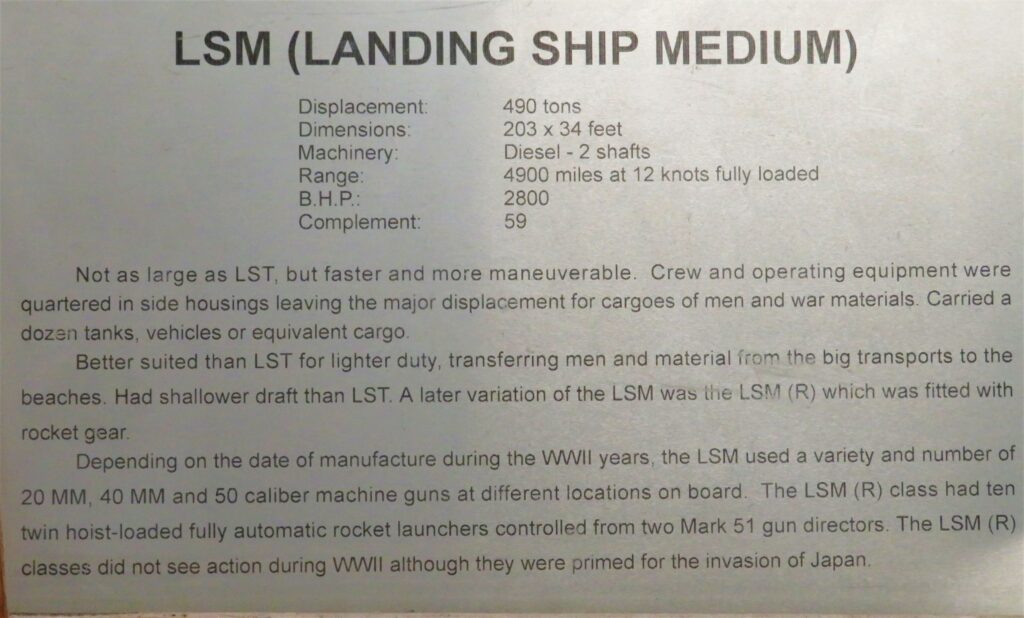
A photo of Linda’s Dad’s ship loaded to the gills – and Dad!
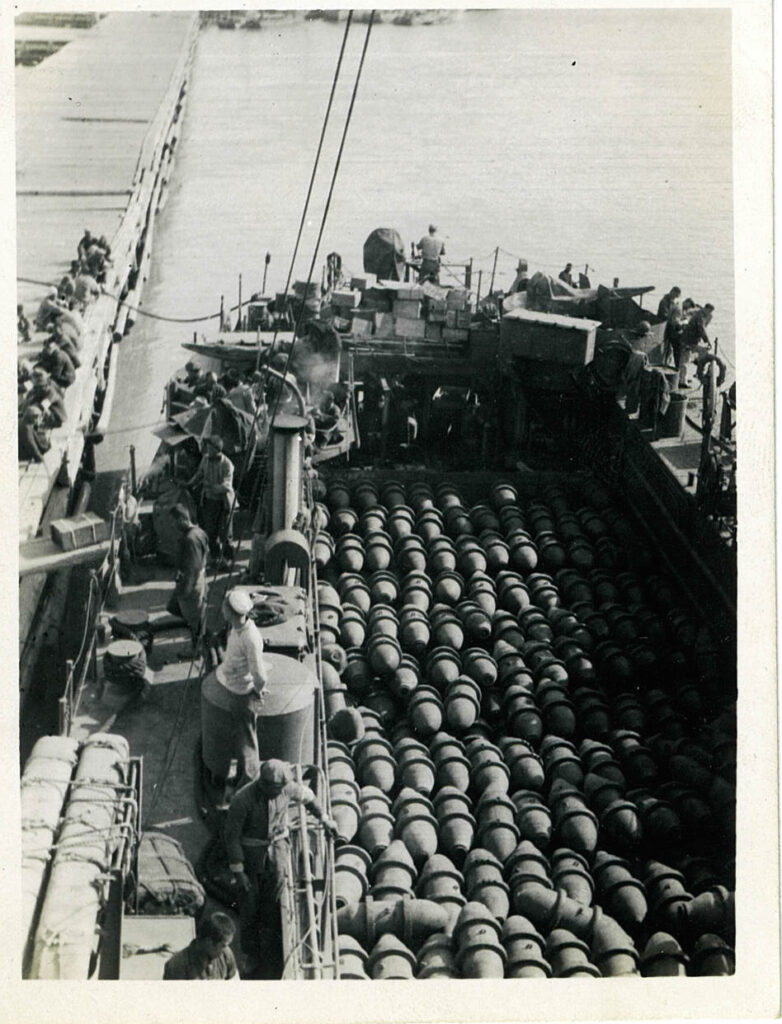
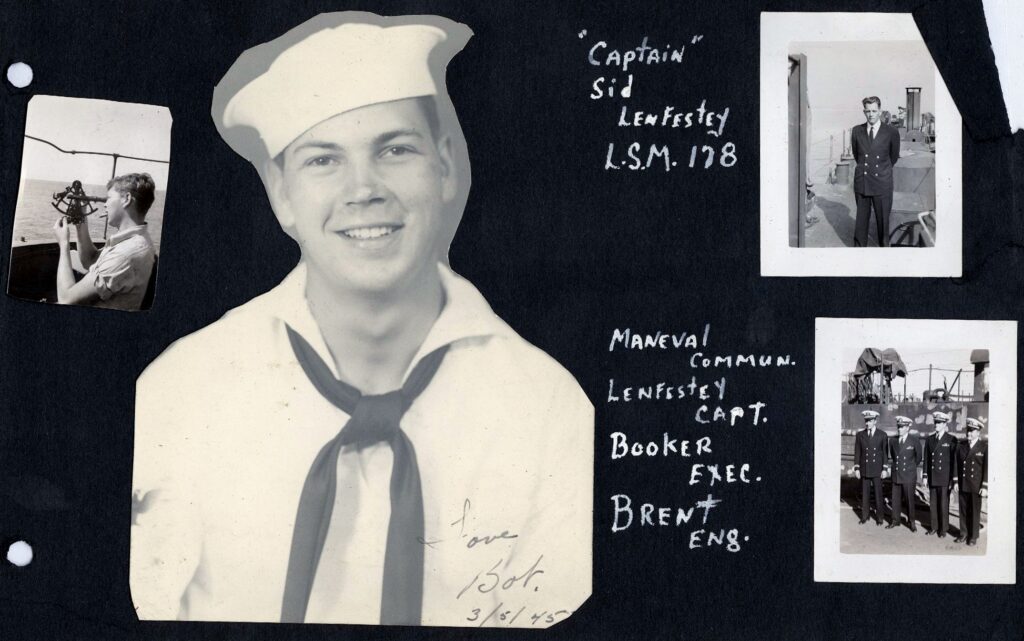
The bakery had an interesting display of the recipe and ingredients to make 10,000 chocolate chip cookies!
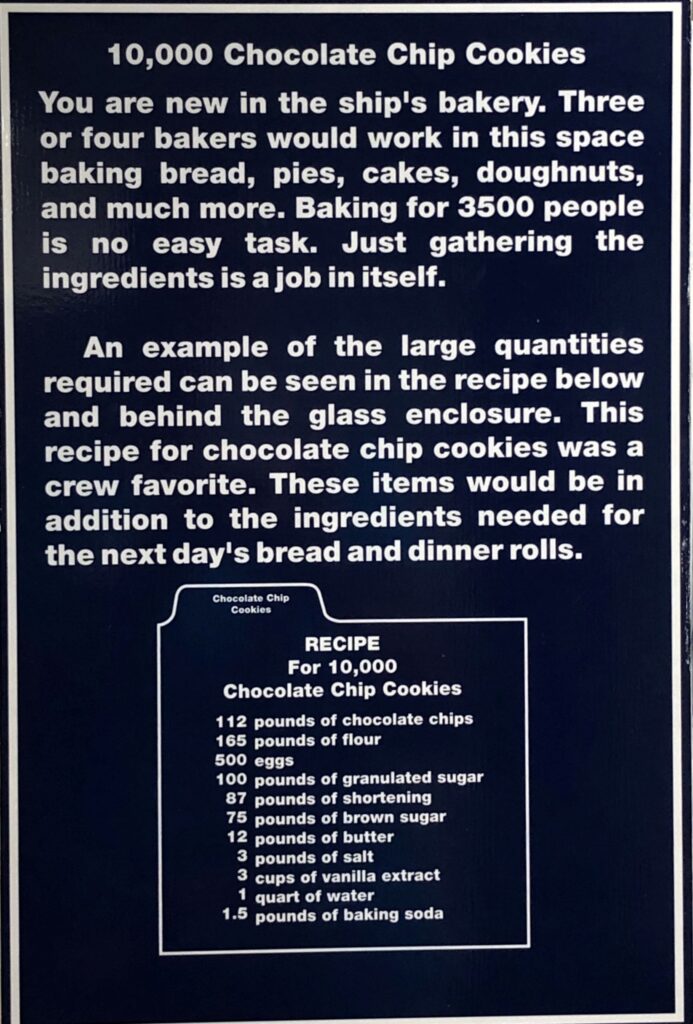

We saw a dental suite with 5-6 dental chairs, a medical clinic and sick bay, the Brig with 6 cells with bunk beds. Sleeping quarters were all over the ship – 3 bunks hanging on chains. It was really interesting to explore the ship! We went down into the engine room and all the way up to the Bridge! There were several different aircraft on the flight deck.
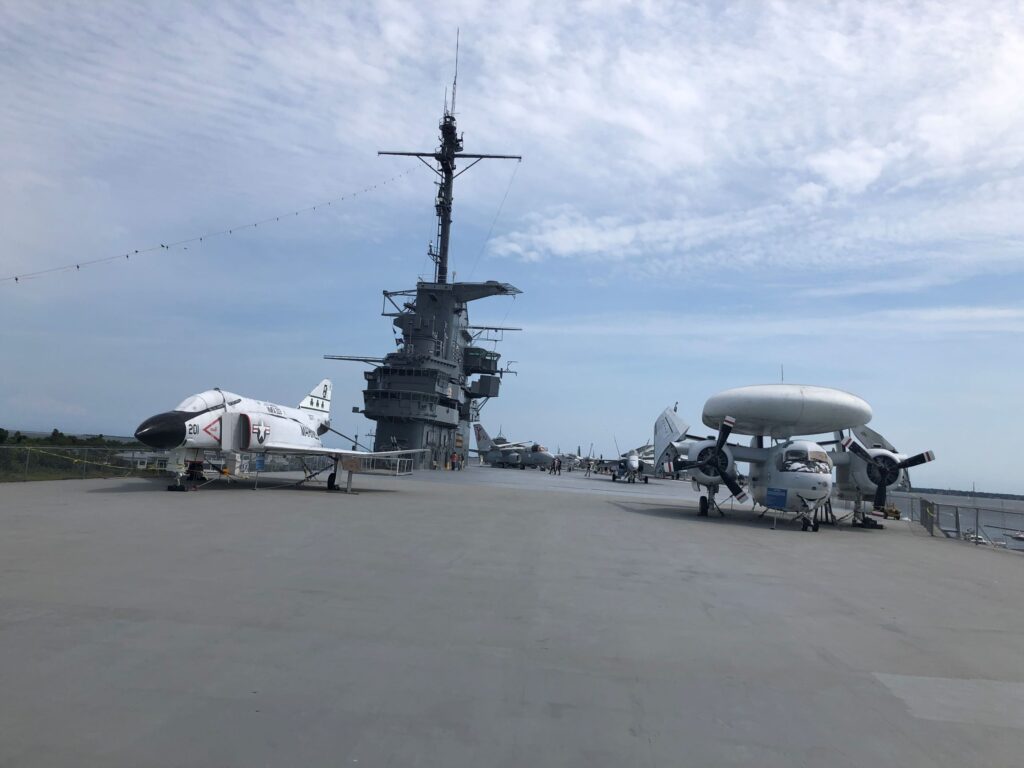
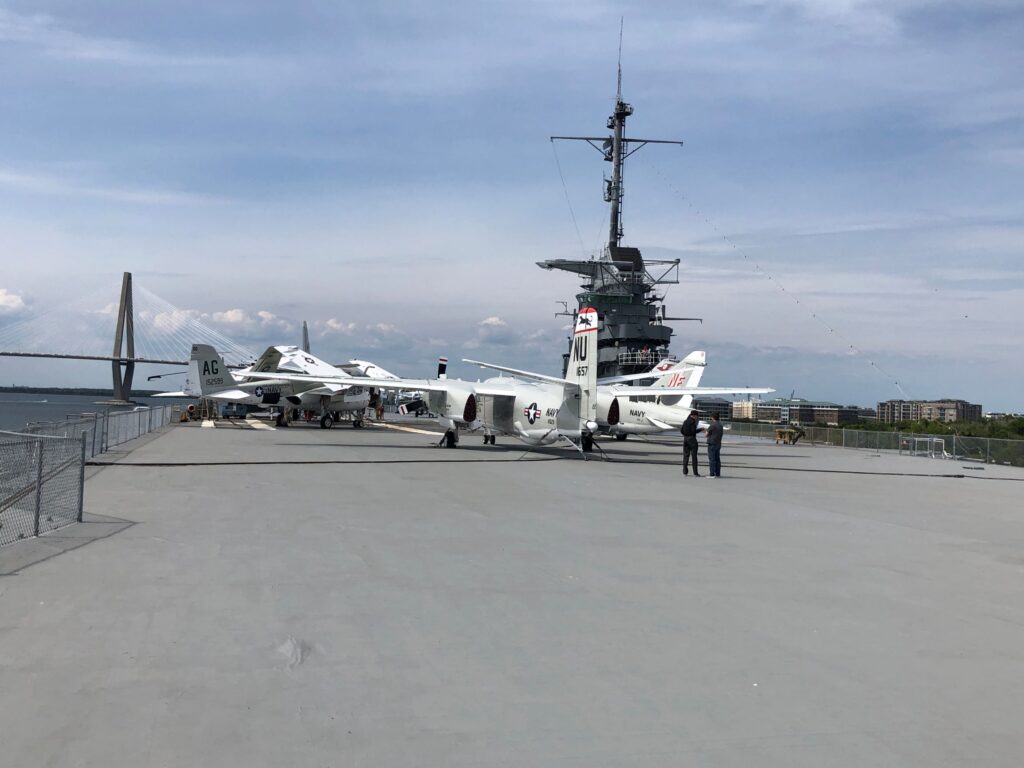
While on the carrier deck, we got a good view of the Laffey.
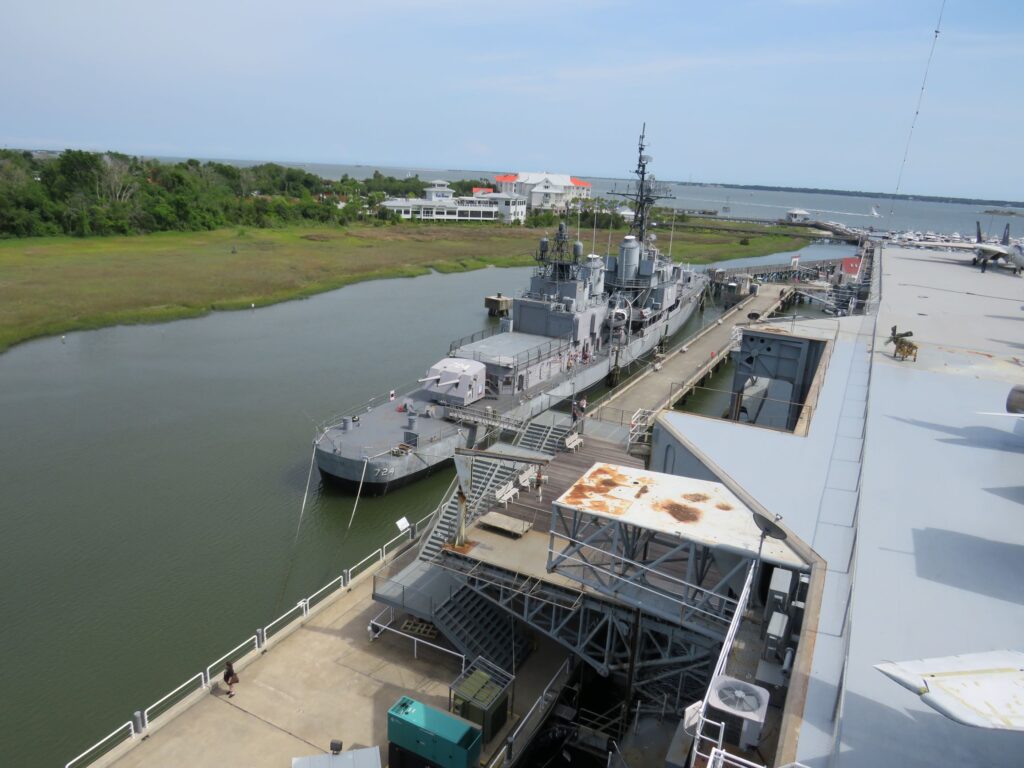
And a good view of the rusty USS Clamagore submarine which is NOT open for visits.
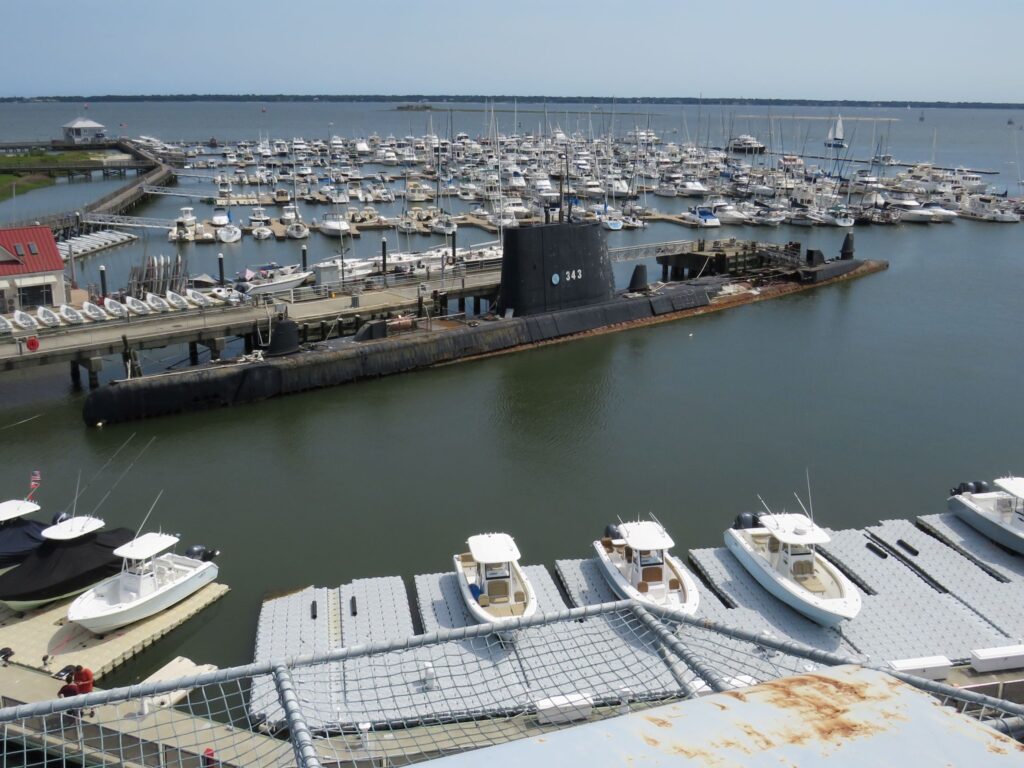
We also got a nice view of the Ravenel Bridge

As we headed out, we drove over to Snee Farm Parkway in Mount Pleasant and saw these lovely Live Oaks lining the road.
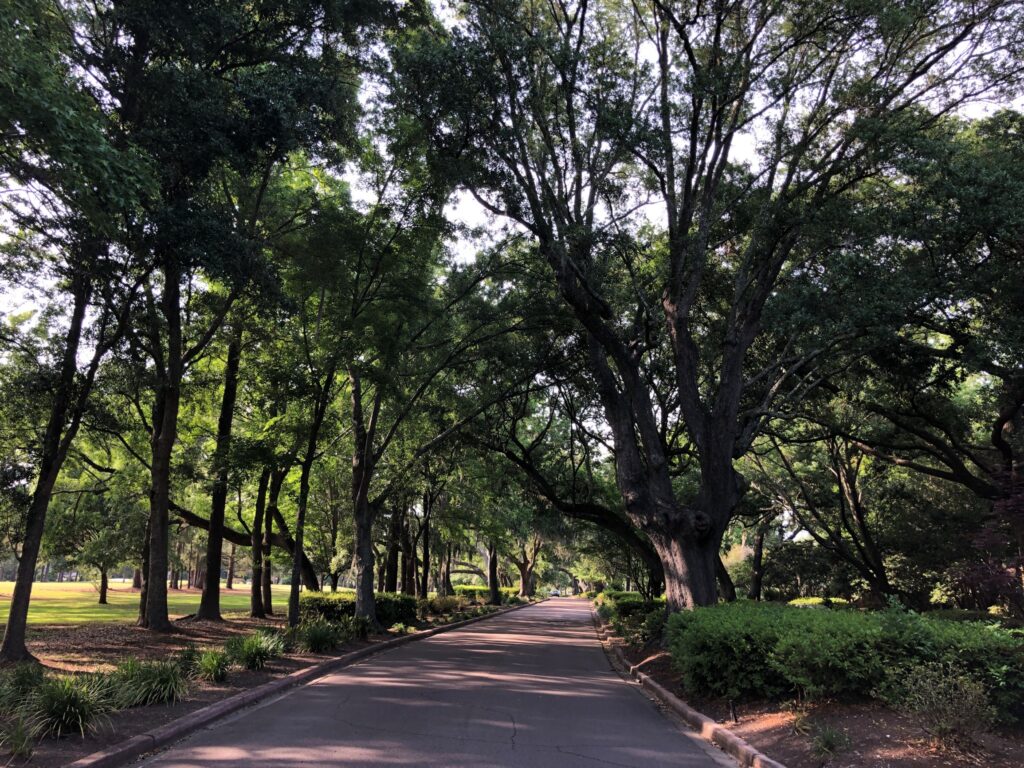
Wednesday we visited the Frampton House and the Blue Heron Nature Trail and picked up an Amazon package at a nearby Amazon locker. The Frampton Plantation House, built in 1868, serves as the Lowcountry Visitors Center and Museum. The large Live Oak trees on the property are thought to be about 250 years old. Their massive branches support other plants: Gray strands of hanging Spanish Moss (which is an epiphyte and not a parasite) and Resurrection Fern which grows along the tops of the main branches, and looks dead when dry – but becomes green again after a rain. We noticed that particularly at the Angel Oak.
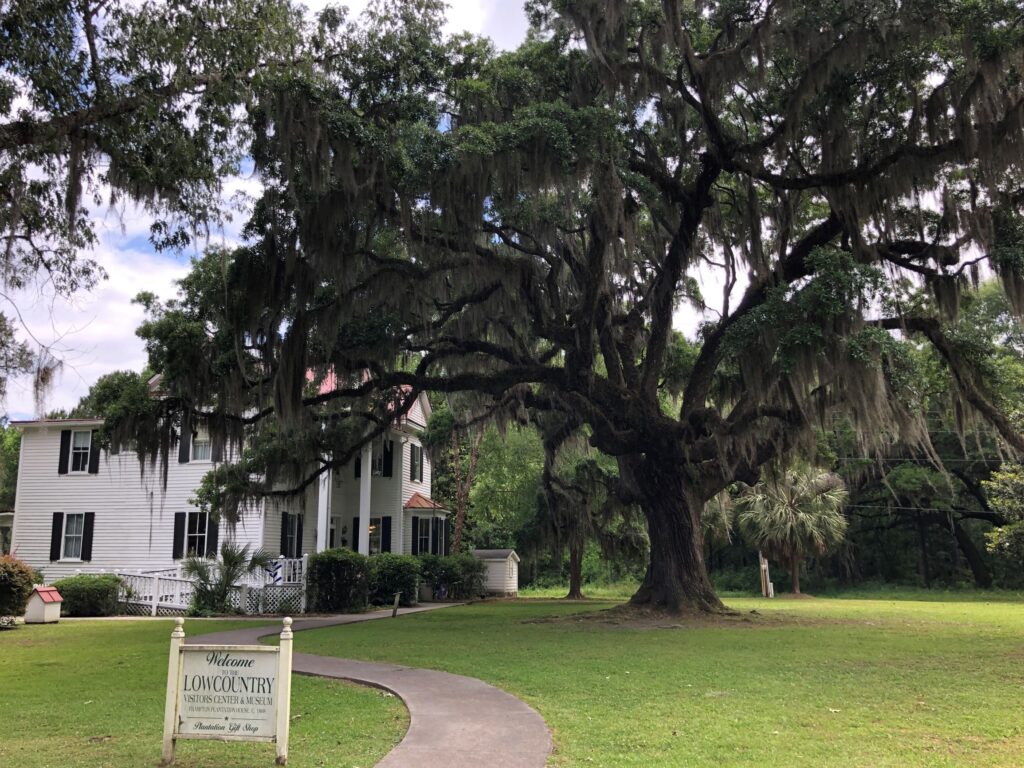
A historical marker in the yard read “This area was the site of “The Hill” Plantation, owned by John Edward Frampton (1810-1896), cotton planter, state senator 1842-45, and delegate from Prince William Parish to the Secession Convention. The main houses here and at Frampton’s other plantations in what was then Beaufort District were burned by Federal troops in early 1865. This house was built in 1868.”
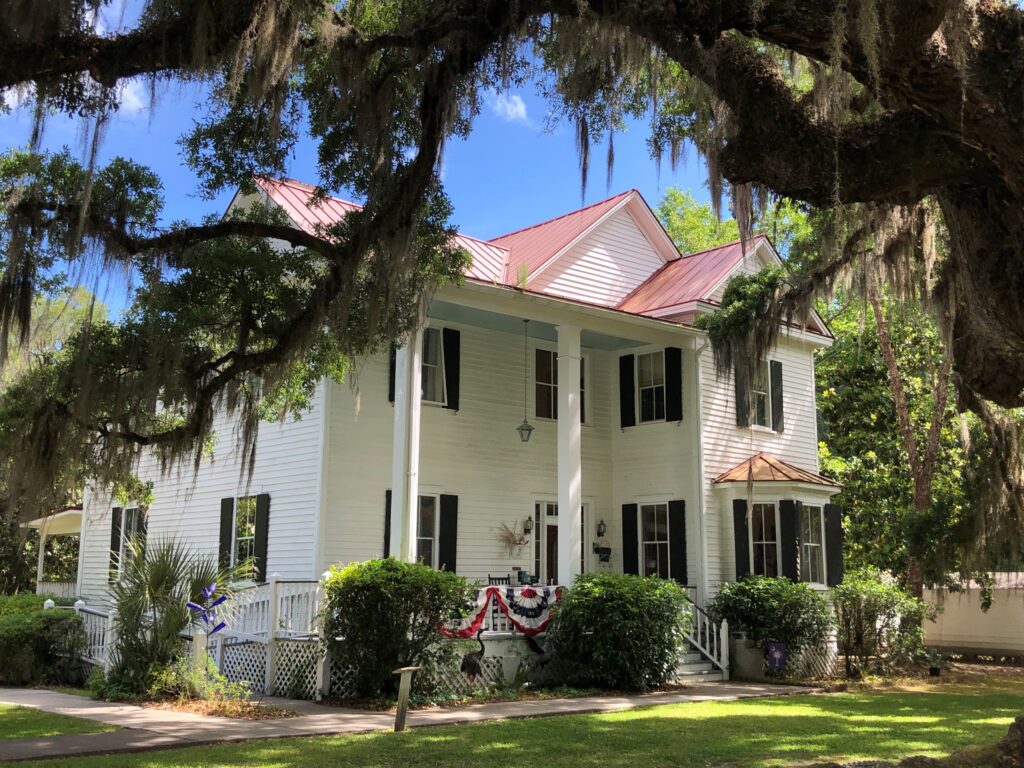
One interesting item in the museum was this TV that was featured in Forrest Gump. The suitcase on top of the TV was much like the one in the movie, but may not be the actual one that was used. The hardwood floor is original to the house.
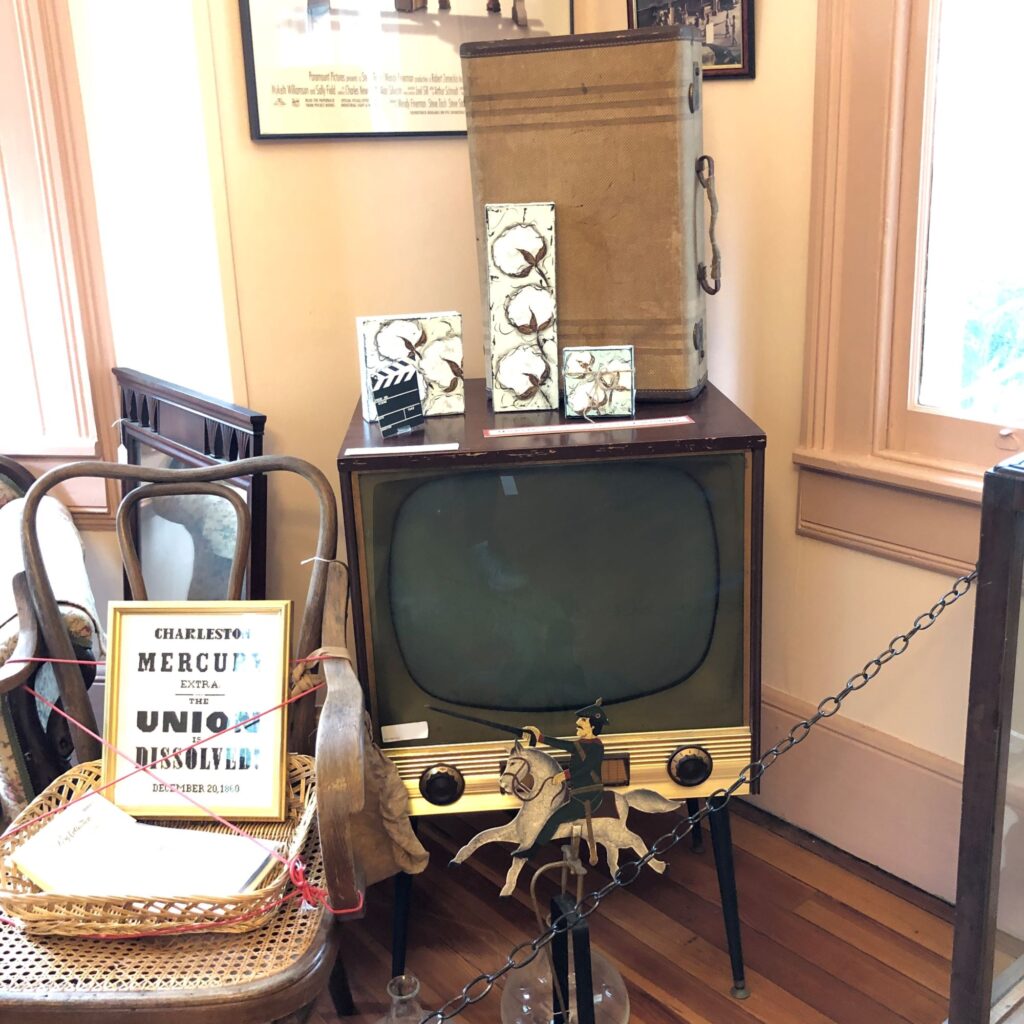
These oaks were out behind the house.
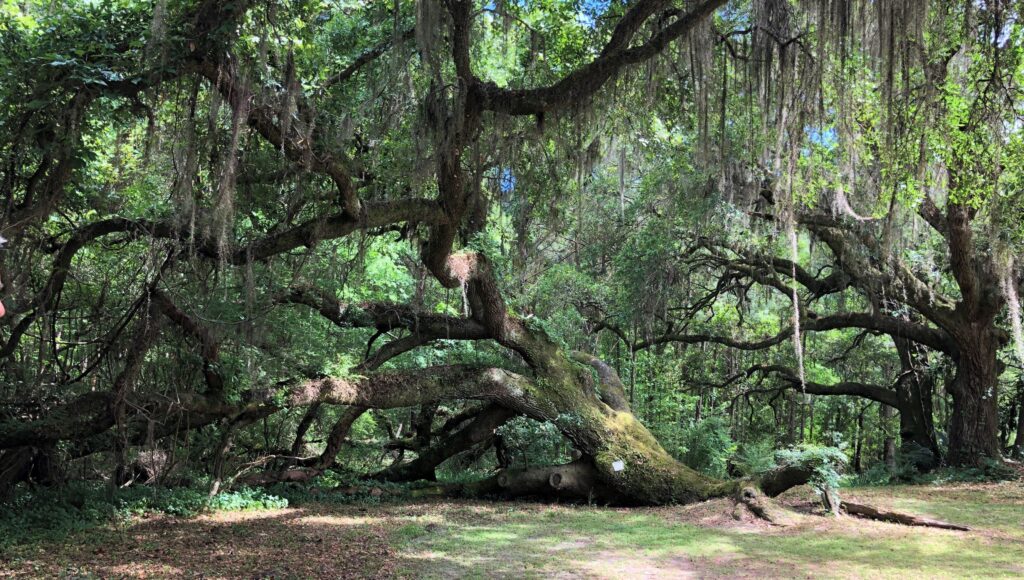
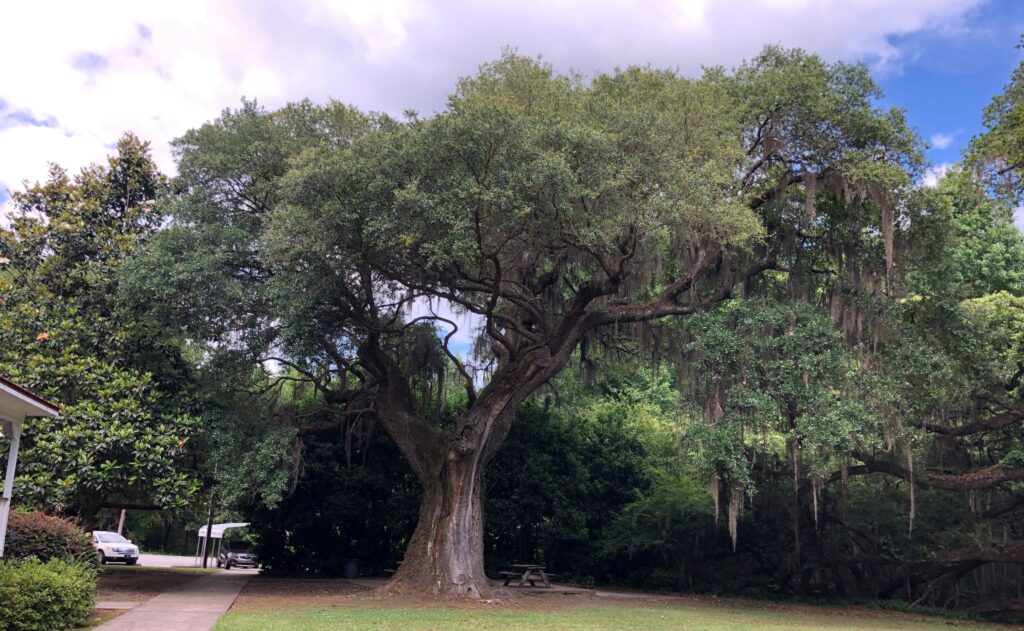
We then went to the Blue Heron Nature Trail. A short trail went by a pond, and into the woods on a boardwalk. There were some ducks by the pond, but none seemed to want to go for a swim?!
The turtles swam over to see us – there must have been 10-12 of them looking for a handout! We didn’t have anything to feed them!
Thursday we had our last ride on the Spanish Moss Trail – for now anyway! Another 20 miles logged on our bikes!
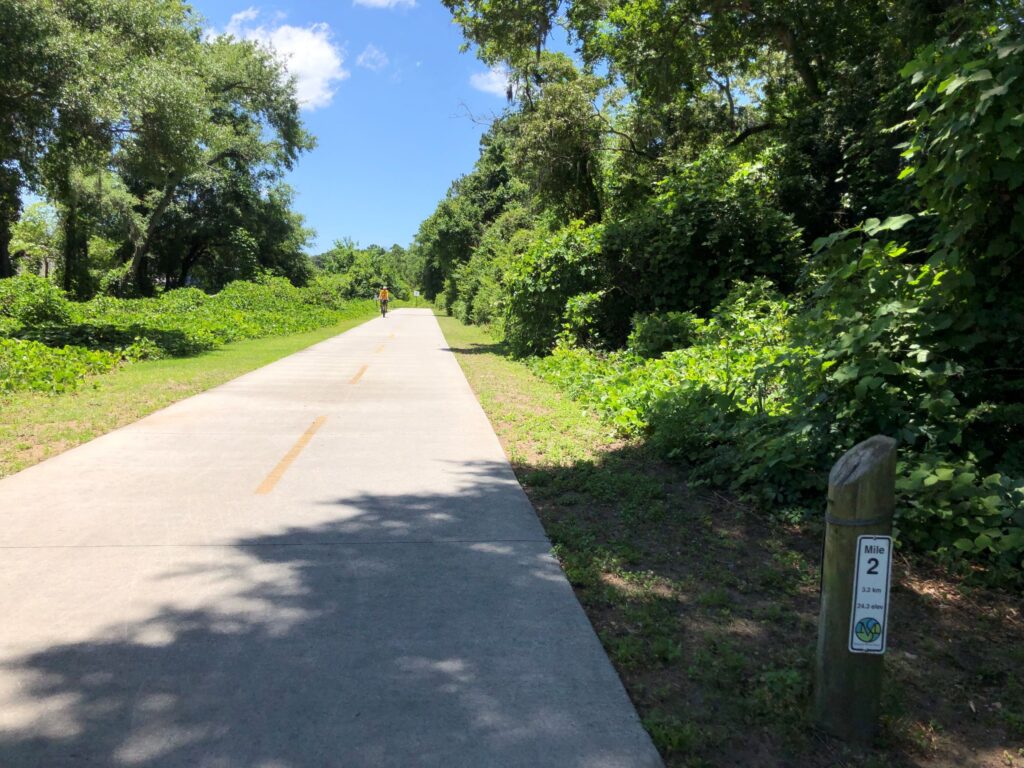
Friday morning we head to North Carolina for a week, then on to Williamsburg, VA.
![]()
